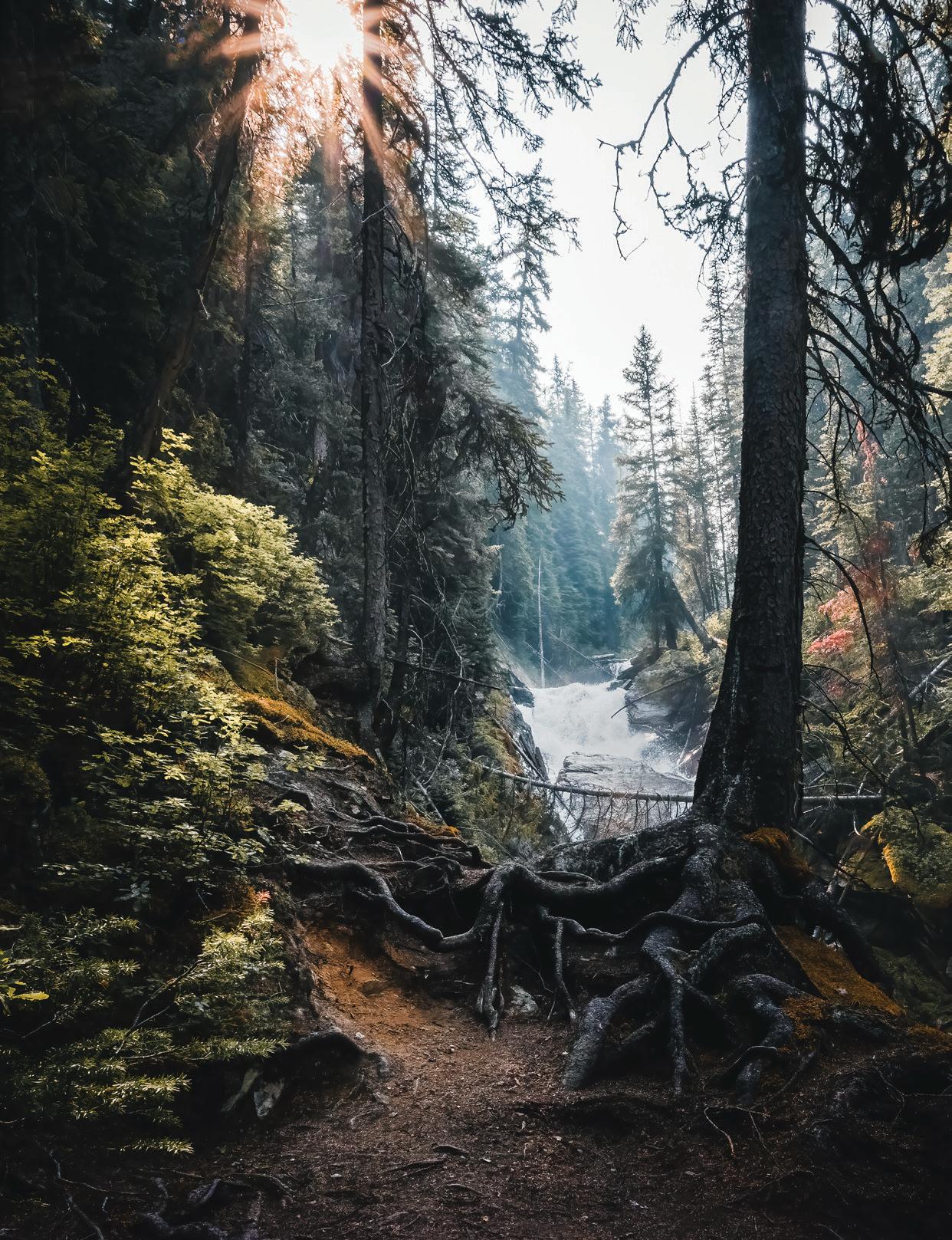
A SOUL AND A SURVIVOR
The 60s Scoop. Vice and Vogue. Big Apple billboards. Creston’s Jayli Wolf hunts for hope.
TEEING UP FOR THE LEGENDARY BOYD HADDAD
SKOOKUMCHUCK’S LAST STANDER?
RAD GRAD: A KIMBERLEY PROM DRESS RETROSPECTIVE
SHOULDER SOLDIERS: EARLY SEASON BIKE, HIKE + PADDLE
LIFE + CULTURE IN THE COLUMBIA, CRESTON & ELK VALLEYS

Situated at the resort’s base, Simply Kimberley offers four well-appointed and distinctive lodges and chalets. Perfect as stand-alone units, these lodges also pair perfectly for larger groups requiring multiple properties.
Our Stemwinder Drive accommodations are right at the resort, close to downtown, and just steps away from great golf and adventures.


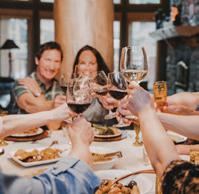
THE BEST OF THE BASE. Kimberley.com Golf
Shuttles & More!
Packages,





We are a proud supporter of the regional Emergency Notification System (ENS) through the Regional District of East Kootenay.
Powered by Voyent Alert!, the system will keep you informed in case of evacuation orders or alerts during critical events such as wildfires, floods or hazardous materials incidents. The service is free and available to everyone in the East Kootenay including municipalities, rural areas and First Nations. Visitors of the region can also sign up to be alerted in case of an emergency. Scan the QR code with your iPad or smartphone or sign up now at www.rdek.bc.ca.
WW W C RANBROOK.C A
Photo: Cranbrook Tourism

Signature Events & Festivals in Fernie

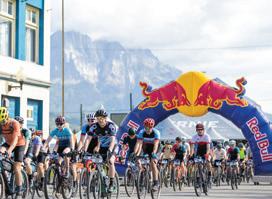

May 4 Feast For a Cause Fundraiser Dinner
May 11 Spring Craft Fair
May 30 Gallery Opening by Tammy Marcer
June 22 Summer Season Opens at Fernie Alpine Resort
June 26 Live Concert: Bandidos Band
June 29 WAM BAM Dirt Jump Jam
July 12-14 Fernie Gravel Grind
July 18 Live Concert: Misery Mountain Boys
July 27 6th Annual Elk Valley Ultra 50km & 15km
Aug 9-10 12th Annual Wapiti Music Festival

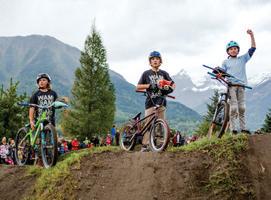
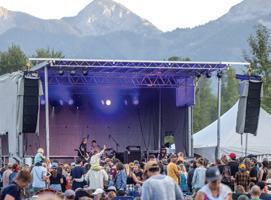
Discover Fernie’s vibrant scene filled with arts and culture events, live entertainment and mountain races for all ages, year round. The above is just a highlight of all the great events you can expect this summer in Fernie –find many more online. Stay longer and enjoy everything that Fernie has to offer.
FernieEvents.com I #ferniestoke

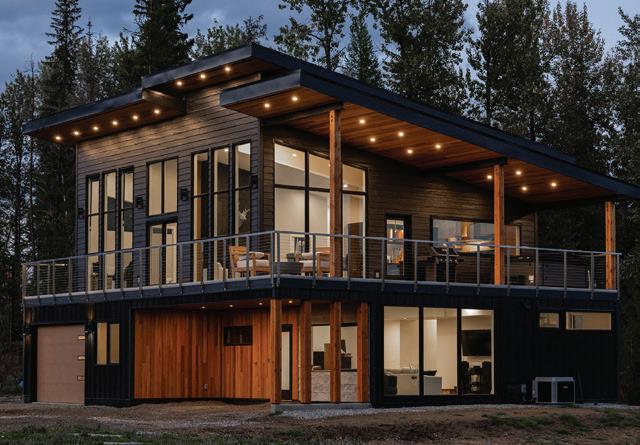


munter.ca | info@munter.ca | 250.427.5925 Gold Winner 2024 Offering award-winning custom homes in the East Kootenays.


Portrait of Perseverance
As seen through the lens of her partner, professional photographer Hayden Wolf, Creston’s singer/ actor Jayli Wolf is a two-spirit member of the Saulteau First Nations. She's featured in our premier issue’s oneon-one interview, Q and Eh, page 15.
On the Cover Fairmont-based photographer Denise Hoffgaard captured this deep forest scene during an August hike to Lake of the Hanging Glacier, a 15-kilometre outand-back trail into the Purcells, west of Invermere. Check out an early season East Kootenay adventure line-up in Shoulder Soldiers, on page 42.
15 Q AND EH
She’s shared spaces with Reba, Reynolds, and a lot of beloved critters on the Creston farm she grew up on. The Trench makes tracks with performer and activist Jayli Wolf.
17 CELEBRATION
Fairmont’s Wicked Woods Music and Arts Festival through the wide eyes of a transplanted Californian.
19 SPORT
Two Cranbrook fathers and a son reflect on the Kootenays' most legendary albeit loose golf tourney.
22 CELEBRITY
Evel Knievel shattered records, bones, and as it turns out, a few wooden hockey sticks, right here.
25 HISTORY
A historic highway-side landmark awaits its fate.
27 OUTDOORS
Saddling up at The Sully with a box of bobbins, and tying one on.
29 PAST BLAST
Even a century ago, the brand new drive from Calgary was worth Sinclair’s satiating soak.
31 HUMOUR
Cowboys, labourers, hockey players, snowboard bums…who’s a Kootenay gal to do when she’s on the prowl?
34
RAD GRAD
A Kimberley prom dress retrospective.
42
SHOULDER SOLDIERS
Your early season adventure ops amongst the melt, mud, and springtime sizzle.
48
THE WILD. AND THE WICKED.
A best-selling author reveals the dark truth behind the Columbia Valley's wild horse cull.
54
OF HARVEST AND HIGH COUNTRY
Creston celebrates a century.
64
WARMING RECEPTIONS
From reservoirs to glacial peaks, signs of climate change abound. Two leading Kootenay scientists explain where we’re going from here.
contents The tRENCH | Spring Summer 2024 9

Meet Our ~
CONTRIBUTORS
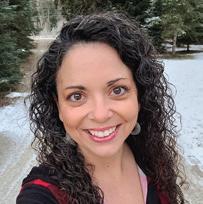
DANETTE POLZIN
A writer and reiki master with a business degree, Danette has a diverse background, from copywriting and content creation to customer service and holistic health. When not working in her wellness studio or writing at her desk in her hometown of Creston, she is likely off somewhere hiking, mountain biking, kayaking, camping, cross-country skiing, or snowshoeing, often with her two zealous boys alongside. She shares some favourite spots on page 42.
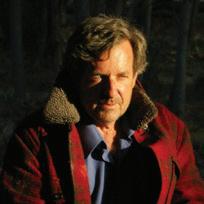
WAYNE MCRORY
A registered biologist who spent the last 20 years studying B.C.’s wild horses, Wayne produced and co-authored several reports on the species — and he shares some of his incredible findings with us on page 48. His research for the Xeni Gwet’in First Nations led to the creation of North America’s largest wild horse preserve, and he’s currently completing his second review of Alberta’s wild horse management. Wayne lives in New Denver, B.C.
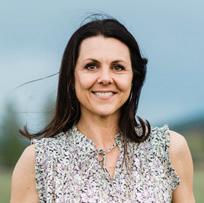
NICOLE LECLAIR
Nicole is a commercial photographer living in Kimberley, B.C. Her work tells the stories of what her clients do and who they help. Nicole leans into the glam and drama of photography, and can find it in any topic she’s assigned. That gift graces our feature on page 34: a retrospective look at fabulous Kootenay prom dresses. Nicole’s favourite part of her process is witnessing her subjects shift their perspective and strengthen their self-image.
Eye on the Fly
Kootenay photographer
Bryce Duffy dove deep in search of this rotund Rainbow in close pursuit of a classic bucktail fly, off Drury Point on the shores of southern Kootenay Lake. Trench writer Jesse Heinrichs documents a pub-going fly-tying crew in his yarn on page 27, In The Fly Of The Beholder.
10 Spring Summer 2024 | The tRENCH
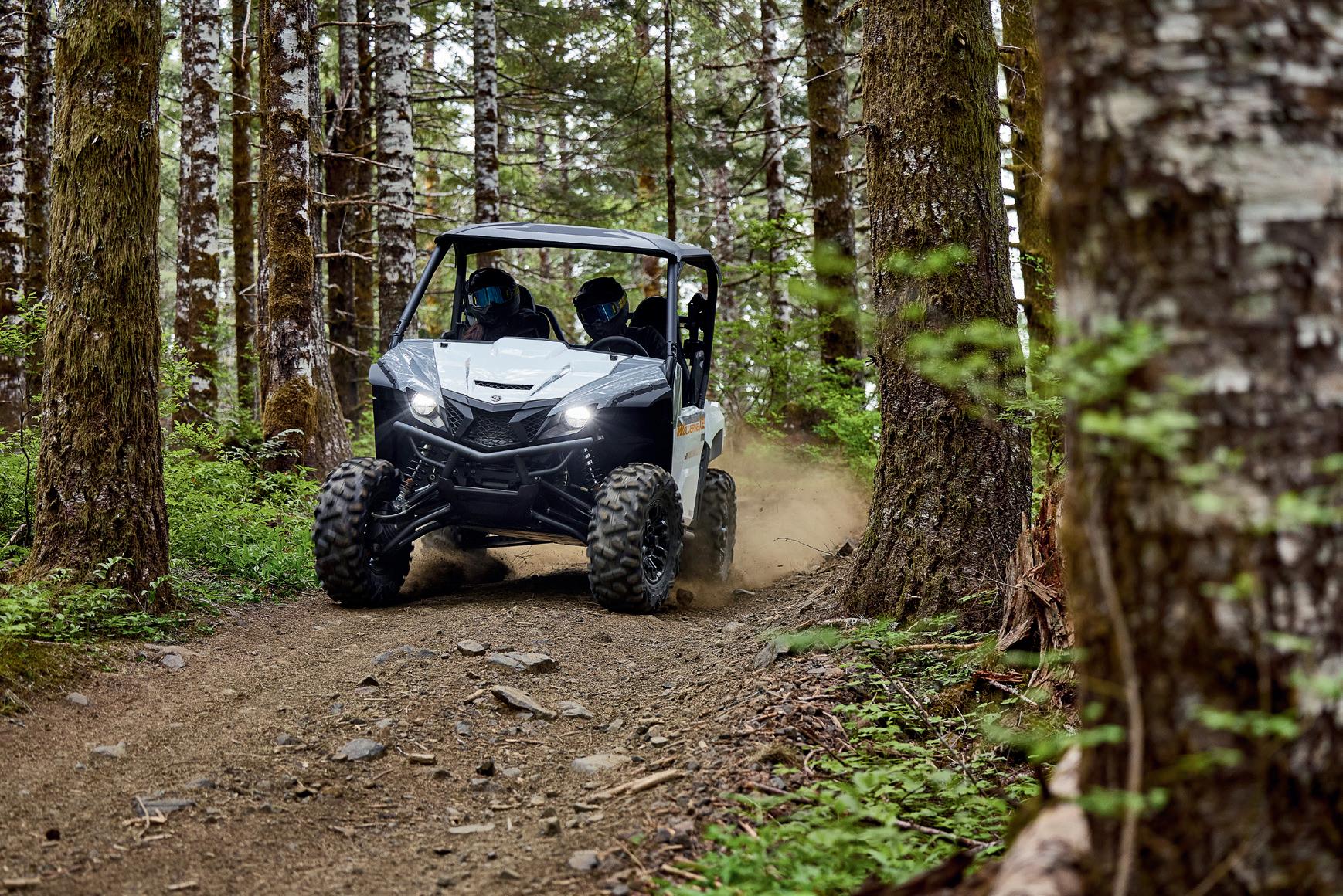


The Ultimate Yamaha Powersports Store, Right here in our own backyard. Kimberley 1142 304st ph: 778-481-8084 www.jcpowersports.com Fernie 30 Shadow Rd ph: 250-423-9251
kootenaymedia.ca
GENERAL INQUIRIES
darren@kootenaymedia.ca
Reproduction, in whole, or in part, is strictly prohibited. No part of this magazine may be reproduced or duplicated without the written permission of the publisher. All rights reserved on entire contents. THE TRENCH Magazine makes every effort to ensure the accuracy of the information it publishes and is not responsible for any consequences arising from errors or omissions. The opinions expressed in the articles are those of the authors.
THE TRENCH Magazine is published three times per year and is printed by Premier Printing in Winnipeg, MB.
THE TRENCH is published by: Kootenay Media 2024 Ltd.

PUBLISHERS EMERITUS
Karen Vold
Grady Pasiechnyk
PUBLISHER
Darren Davidson
EDITOR
Britt Bates
COPY EDITOR
Danette Polzin
ART DIRECTOR
Ashley Dodd
PRODUCTION DESIGN
Sarita Mielke
Janneke Guenther
ADVERTISING SALES
Alesha Thompson
DISTRIBUTION
Jesse Heinrichs
SOCIAL MEDIA
Danette Polzin
WRITERS
Wayne McCrory
Dave Quinn
Brian Lawrence
Jacquie Moore
Danette Polzin
Jeff Pew
Darren Davidson
Monica Karaba
Greg Nesteroff
Jesse Heinrichs
Erin Knutson
Sarah Stupar
PHOTOGRAPHERS
Pat Morrow
Nicole Leclair
Patrice Halley
Ashley Voykin
Neil McElmon
Robin Munshaw
Abby Cooper
Vince Mo
Lynne Karey-McKenna
Emma Penner
Trevor Marzke
Denise Hoffgaard
Petra Hekkenberg
We gratefully acknowledge that we live and work on the traditional and unceded territory of the ɁamakɁis (Ktunaxa) and Secwepemcúl’ecw (Secwépemc), as well as the chosen home of the Métis people of B.C.

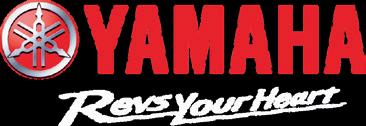
The Ultimate Yamaha Marine Dealership. Right here in our own backyard. Kimberley 1142 304st ph: 778-481-8084 www.jcpowersports.com Fernie 30 Shadow Rd (250) 423-9251






TO PURCHASE PLEASE CALL: 250.427.3389 B OO K YO U R G O L F GETAWAY TODAY! 1-888-874-2553 | TrickleCreek com
TO LEARN MORE
SCAN
Welcome to the trench
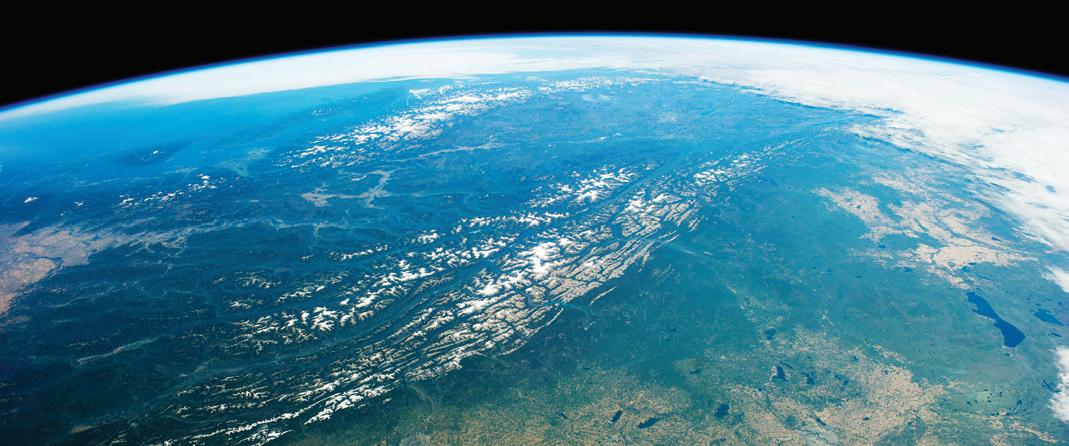
OUR HOPE IS THAT WHEN YOU PICK UP THE TRENCH, YOU’LL FEEL CONNECTED TO THESE LANDSCAPES, COMMUNITIES, AND PEOPLE.
There aren’t many things that you can see from space, yet somehow the Rocky Mountain Trench emerges through the atmosphere.
At Kootenay Media, we’ve been capturing the scene and unseen of the East Kootenay since 2012. The long-standing publications of GO Kimberley, GO Cranbrook, and their merged offspring, GO Cranberley, have been visible throughout the year with thousands of copies circulating through hotels, homes, restaurants, coffee shops, airports, and local businesses.
To expand our perspective, we’re thrilled to announce the inaugural rebrand of our publication Go Cranberley to The Trench, now celebrating the local arts and culture, economy and tourism, geography, and people of the Columbia, Creston, and Elk Valleys.
The Trench, published three times per year, lauds the southern communities of the Rocky Mountain Trench, including Golden, Radium, Fairmont, Invermere, Canal Flats, Kimberley, and Cranbrook, as well as the neighbouring communities of Fernie, Elkford, Sparwood, and Creston.
It’s easy to get lost in the vastness of the Trench.
Although we’re hundreds of kilometres apart, our hope is that when you pick up The Trench, you’ll feel connected to these landscapes, communities, and people — and perhaps, even from thousands of kilometres away in space, the Trench won’t feel so vast and far away.
We are grateful to publish The Trench on the traditional and unceded territory of the ɁamakɁis (Ktunaxa) and Secwepemcúl’ecw (Secwépemc), as well as the chosen home of the Métis people of B.C.
–The Trench team
The Rocky Mountain Trench, aka "the Trench," is a long and deep valley formed 60 million years ago through a combination of tectonic activity, glaciation, erosion, and sedimentation. Also known as “The Valley of a Thousand Peaks,” it runs 1,600 kilometers between the Rocky Mountains to the east and the Columbia Mountains to the west, from the northern tip of the Canadian Rockies to just south of the U.S. border.
Photo courtesy NASA
MEDIA
14 Spring Summer 2024 | The tRENCH

She’s a veteran musician, actor, activist, a new farmer, and a survivor.
Two-spirited Jayli Wolf is also a member of the Saulteau First Nations and today, lives near Creston. While Wolf’s career has garnered the spotlight of global media platforms including Spotify, British Vogue, Vice magazine, Hello! and music’s preeminent title, Rolling Stone, she and her husband Hayden, a professional photographer, live a private and newly peaceful life on the farm where she grew up.
Your work in TV started in 2014 on the Aboriginal Peoples Television Network’s (APTN) Mohawk Girls and, most recently, on Disney’s series Y: The Last Man. You’ve appeared in five films. That business seems gruelling — and maybe not as lucrative as folks may think. How would you describe that part of your career?
We’d work 16 hour days on set, then when I wasn’t there, I was doing voice work, or working on music. I was never home. I saw my partner and friends about a week a year for a few years. (Laughs) It was really bad. There are wonderful parts
about it — you’re constantly in new locations, meeting new people. But at one point, I had to ask myself if it was all worth it. I was putting people and things I cared about second…and you mentioned the lucrative part…at the beginning it can be gruelling, but you can really get some really great contracts. It’s just a lot of sacrifice.
Your musical career started when you won a song-writing contest on APTN, then you and
Why Jayli Wolf Survives
From the farm to Times Square, Rolling Stone to the 60s Scoop, the Creston singer and star lays tracks through stardom, dark days, and a father’s fate.
more authentic that way. My soul was calling me to tell my own stories.
And how did Hayden take that? (Laughing) He was so supportive, he was amazing. He’s my partner in crime.
You’ve both spent time around a lot of very big names in show business. Last year, you performed at the Bring Change To Mind gala for mental health awareness, organized by Glenn Close, that also featured country leg-
We all have good days. It was nice to see celebrities backstage, or on set, and learn that we all sit in a circle in this life.
Last October, you were Spotify’s EQUAL Ambassador, as part of a project aimed at powering movements for gender equality. The advertising for that ended up on billboards in Toronto’s Dundas Square and NYC’s Times Square. How do you keep that kind of fame in perspective? I feel incredible gratitude
I WENT THROUGH A VERY INTENSE SPIRITUAL AWAKENING. I DON’T KNOW HOW ELSE TO DEFINE IT. I THOUGHT I WAS LOSING MY MIND.
Hayden formed the duo Once A Tree. The act received some big press — Rolling Stone took note, so did British Vogue, Nylon, and Vice. With all that success, what led the two of you to set Once A Tree aside to pursue your solo career? I had a lot of stories I wanted to tell that were personal, and it felt right for me to write those as a solo artist, to play with different genres and play with different musicians. It felt
end Reba McEntire and comedian Amy Schumer. You shared a bottle of gin you were given by Ryan Reynolds. Your husband worked for Drake and his clothing line, October’s Very Own. What is it like to be in the company of superstars like this — nerve wracking? Thrilling? Easy company and just another day in the life? I think at first it was really thrilling, but then you start to get that people are just people.
for the opportunities. Life is filled with ups and downs, and this was definitely one of the most exciting campaigns I got to be a part of. I was on such a high during my time in NYC. There were some surreal moments but the main feeling was immense gratitude.
Wild Whisper was your first EP. At the end of the song Child of the Government, you speak to your father’s experience as a
child taken in the 60s Scoop. How is he today? My father is doing really great. He’s grown so much in the past few years, and made a lot of big changes in his life. He lives in the Kootenays as well.
The video for Child of the Government charted number one on CBC and IMC radio; the video was awarded too. Why do you think it was so well received? Some Canadians didn’t know anything about the 60s Scoop. So when the song first came out, it was an educational piece. It was news for some people. I wasn’t expecting it to have that sort of impact.
As an activist, and as someone who is both Indigenous and queer, do you feel society has made headway in the last few years in terms of reconciliation and inclusivity? Have things changed since your career started? Definitely. There’s so much more inclusivity in our industry. It’s really encouraging to see.
Some people feel media has spent too much time on inclusivity and reconciliation the last few years —
continued on page 16
Q AND EH
The tRENCH | Spring Summer 2024 15
Hayden Wolf Photo Styling Poinsetta Lane
I’m glad you touched on that. That’s something we hear a lot — that there’s too much talk of inclusivity. I want to be hired because I’m a good actor and a good musician, not because of my race or because I’m bisexual. But we’ve been in the dark ages for such a long time. We have to give it more time to balance out.
You‘ve said in a few interviews that up until you were eight or so, your Dane family at the time had led you to believe you were of Mexican origin. What does it mean to you to be Indigenous as opposed to a different ethnic background? I didn’t know what that truly meant until I got a bit older. It meant the world to me to start reconnecting with my biological Indigenous family in my teens.
What’s next for you? I’m working on my debut fulllength album at the moment, and I’m beyond excited about getting this time to create…and writing my poetry book.
In your latest album, God Is An Endless Mirror, you get very personal in ways many folks can relate to. In an interview you did with Tom Power on CBC’s Q last fall, you talked about the mental and spiritual health challenges you’ve faced. What were you going through, and how have you overcome that darkness? I went through a very intense spiritual awakening. I don’t know how else to define it. I thought I was losing my mind. It’s why I stepped away from acting and came back to the Kootenays. What’s helped? Surrounding myself with na-
REBA MCENTIRE…RYAN REYNOLDS… DRAKE…WHAT’S IT LIKE BEING IN THE COMPANY OF SUPERSTARS LIKE THAT?
Your return to the Creston farm you grew up on is an incredible story. I left when I was 17. My great grandparents owned it, so I was able to visit, but they lost it about seven years ago. I always said I was going to buy it back. And as soon as I started looking, it came on the market. The new owners had even kept the old family farm name sign up.
You’ve mentioned you’re not really a morning person. Farmers usually get up pretty early… (Laughing) I’m getting better. We’re getting horses soon so I’m going to have to get up. But that’s the best part. It’s hard to have a bad day when you’re surrounded by beautiful, innocent creatures. Even though they demand time and energy.
ture and animals, and having time for my partner and my friends. Giving back to myself.
Lots of us struggle to maintain mental health. What’s your advice on how to just get through a difficult day when they keep piling up? I had to stop giving my energy to unhealthy thoughts. I would literally say ‘I call my power back to myself.’ I’d focus on my inner world and get in touch with what I actually want, not what society says I should want. What is actually going to make me happy? I’d suggest to anyone going through a hard time that they listen to what’s going on within.
–Darren Davidson
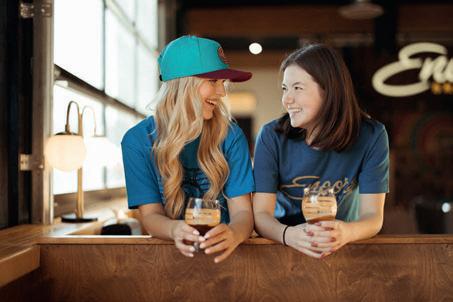
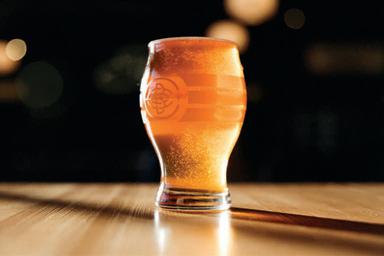

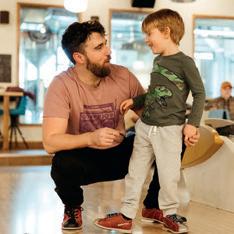

Q AND EH
16 Spring Summer 2024 | The tRENCH
The night the bush beat the Bay
Our transplanted San Franciscan and unabashed rave n’ club lover reflects on her wicked nights in nearby woods.
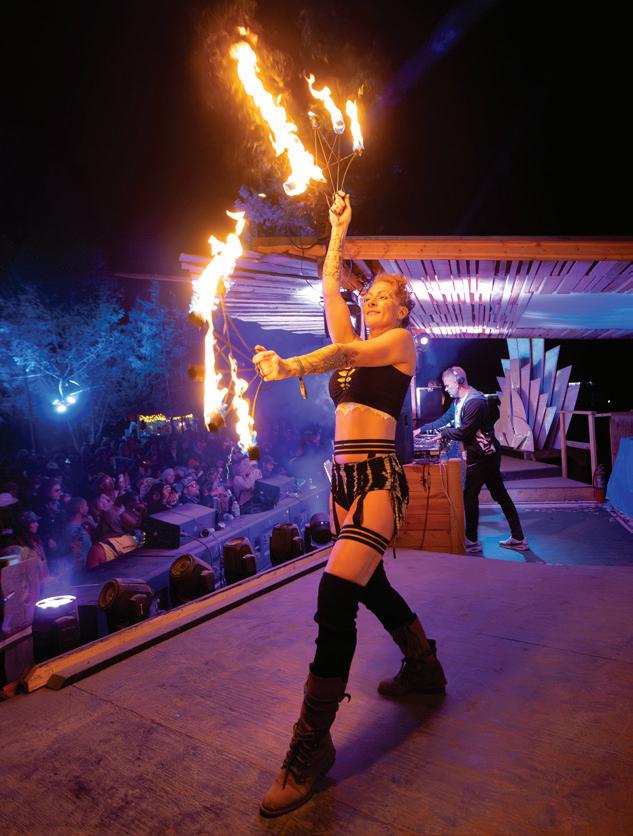
Leading up to my move from San Francisco to Kimberley, I had to make some decisions on what to bring from my wardrobe. It was a no-brainer to discard the high heels and office workwear, but it was a lot harder to let go of my carefully curated festival gear: fur coats, neon onesies, and tutus. Eventually the practical side of me won out: I assumed my raver days were behind me.
Two weeks after my arrival, while still wondering
what life would be like now that I was surrounded by wilderness on all sides, my fiancé announced we had been invited to hear some DJs play. Cool, I thought, but is there even a club around here?
I was a bit confused when we turned off the highway onto St. Mary Lake Road, which seemed even further away from any signs of civilization. We took another turn onto an even bumpier, smaller road. Thick forest blocked out most of the
fading sky.
I heard it before I saw any signs of it. From somewhere deep in the forest, a deep booming grew louder. We pulled up to some friendly people waving flashlights who showed us where to park. “What the heck is this?” I asked my fiancé. He grinned. “Welcome to Wicked Woods!”
Be still, my electronic-music-loving heart! There before us, tucked deep inside the wild mountain landscape, was a vibrant,
It's lit — Amongst more than 150 artists who perform each year at Wicked Woods, dancer Elysha Herridge (stage name Meraki Rising) performs during a 2022 DJ set by Dominic Butler, one-half of UK-based DJ duo Stanton Warriors. Neil McElmon Photo
pulsating dance club. It was surreal: dust rose around people jumping to hypnotic beats on the dirt dance floor; others warmed their hands around crackling fire barrels. Laser lights shot through the darkness, creating a lightshow on the towering conifers better than any effect I had seen in an industrial warehouse. I breathed in the crisp mountain air and thought to myself, “Sorry, San Francisco, this is the real underground!”
Wicked Woods began in 2008 as an edgy, one-night bush party of about fifty people celebrating Kimberley local Danielle Phillip’s birthday. So much fun was had that Danielle and her husband Heath hosted the party again the following year, and every year thereafter. Momentum grew as they and their friends became more organized and creative with the lights and sounds (provided by Ray’s Music since day one), artist lineup, and overall ambiance. In its sixth year, the event
on crown land for several years, Wicked Woods found a spot on private land from 2013 through 2016. Eventually the festival outgrew its humble roots and moved in 2017 to a grander location near Fairmont Hot Springs, its seventh and final location: 144 acres of land, set against an otherworldly mountain backdrop with panoramic views of the Columbia Valley.
Here, the festival’s elaborate structures and stages remain in place between festivals, thus allowing for ongoing expansion and enhancements every year. The larger space features four stages of music, as well as inspiring art installations, more workshops, and abundant ways for people to come together and experience the transformative power of music, art, nature, and community.
In 2023, a talented new team took over management of the event, which now sees an attendance of approximately 3,000 people. The team’s vision for 2024 in-
FUR COATS, NEON ONESIES, AND TUTUS… I ASSUMED MY RAVER DAYS WERE BEHIND ME.
expanded to two nights to accommodate all the local talent. Vendors and workshops were added, and detailed planning went into the site’s layout, decor, and camping experience.
After bouncing around
cludes presenting the most diverse line-up of artists and performers yet, while maintaining the inclusive, homegrown, welcoming atmosphere that the festival is known for. Rumour
continued on page 18
CELEBRATION
The tRENCH | Spring Summer 2024 17
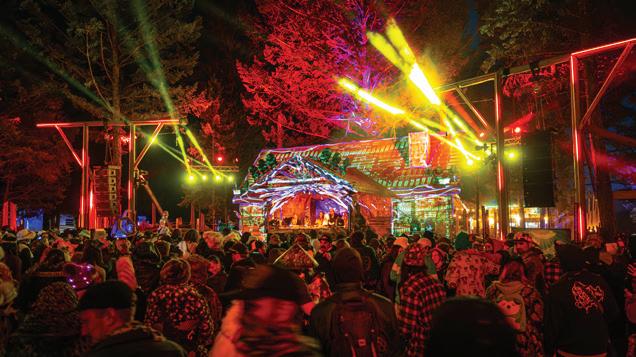
has it there will be more Drum and Bass this year, a favoured genre.
Kimberley resident Rob Palermo has participated in almost every Wicked Woods event since its inception, in roles such as builder, site carpenter, stage director, and DJ. He is known around the region for his beautiful stages: he constructed a
50-foot-tall pirate ship for SYNC Festival in Golden, and has worked as the main builder for the Grove stage at Shambhala in the West Kootenay, known as Canada’s premier EDM (Electronic Dance Music) event.
“Building stages for music festivals allows me to express myself and explore the creative and artistic side of
my carpentry skills,” Palermo explains. “It’s a tonne of hard work, time, and commitment — but seeing the smiles on everyone’s faces makes it all worthwhile.”
As for Danielle Phillips, whose birthday set off the chain of events leading to the unexpected rise of Wicked Woods’ popularity, she emphasizes that, “Wicked
Bush bashin’ — Right between Salmo’s legendary Shambhala Festival and Golden’s SYNC Festival, Fairmont’s Wicked Woods started as a 50-person birthday shindig near Kimberley. Neil McElmon Photo
Woods is and always has been about bringing everyone together in community.”
“Seventeen years ago, my husband and I and a few others created a magical night out in the woods — a night full of local talent, beautiful friends, and the best vibes,” Phillips reflects. “So many people along the way helped create this space for us all to enjoy; for us all to get weird and just be.”
While its original ethos still drives Wicked Woods, Kimberley’s little backwoods festival has expanded into one of the top-ranked EDM festivals in Western Canada.
Oh, and for any other city slickers who are on the fence about attending, know this: there’s nothing
that compares with dancing your heart out from sunset to sunrise on the side of a mountain underneath a starlit sky. The lights, the costumes, the community: Wicked Woods is a colourful, high-energy, life-affirming experience of community and fun. (And don’t worry: there are even glamping options now, too!)
The three-day Wicked Woods Music and Arts Festival runs Aug. 30 to Sept. 1, 2024 at Fairmont Hot Springs. More info? wickedwoods.ca.
–Monica Karaba

Discover the Columbia Valley Golf Trail! The 10 spectacular courses offer unique golf experiences for every golfer, from family fun to world-class. Explore the Columbia Valley Golf Trail courses in Spur Valley, Radium Hot Springs, Invermere, Windermere, and Fairmont Hot Springs.
CELEBRATION
Book Your Tee Times at ColumbiaValleyGolfTrail.com
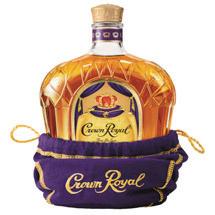
Meet Cranbrook golfers
Wayne Haddad and Bob Langin. Cumulative age 158 years. With their best golf played through the eras of a young Nicklaus, Lopez, then Faldo, the fellas’ combined handicaps would have barely reached double digits back in the day.
As two of the longest time members at the Cranbrook Golf Club — the 84-year old Haddad has been there since the course opened in 1951 — at their best, both he and Langin were scratch golfers and part of the club’s always formidable squad in the Kootenays’ most quietly famous golf tournament, the Boyd Haddad.
“It was pretty much a party to start with,” laughs Haddad, whose name adorns one of the tourney’s two cups. “You’ve seen the original trophy.”
Donated by Vancouver golf course and highway builder John Boyd in 1936, the “cup” is in fact a rotund and antiquated wooden whiskey keg. Part of the tournament entry fee, Haddad explains, was a bottle of rye. Crown Royal no less. Each team brought its prerequisite 26er, and each one went into the keg. By the time the tourney and evening’s celebrations ended, most of the whiskey had been shot or maybe lost to spillage. On road trips to neighbouring courses, a designated driver was hired
From Boyds to Men
Fathers and a son reflect on the Kootenays’ legendary and somewhat loose Boyd Haddad golf tourney.
for safe navigation of the rollicking passenger van that ferried what was often a victorious Cranbrook squad.
Good times aside, the retired car dealer and insurance brokerage owner explains that the tournament has, for decades, featured many of the region’s best golfers.
“It was an honour to make the team,” he says. “A lot of the players were club champions.”
son Jeff.
“The format is fun and it’s about bragging rights,” says the junior Langin, 37, a Cranbrook native and current course champ in Nelson, where the Boyd Haddad will be held this summer. (Somewhat true to its casual form, as of Trench press time, no one was quite sure of the tournament’s date.)
Golf’s currents run deep in the Langin family. Bob went to school in Colorado
BY THE TIME THE TOURNEY AND EVENING’S CELEBRATIONS ENDED, MOST OF THE WHISKEY HAD BEEN SHOT OR MAYBE LOST TO SPILLAGE.
Originally pitting East Kootenay teams against one another, the competition now includes squads from Kimberley, Fernie, Creston, Trail’s Birchbank, Castlegar, Balfour, Nelson’s Granite Point, and the reigning champs, Cranbrook.
In the ‘70s, Haddad introduced the second tourney to include a net tournament, to add to the Boyd, which was gross. That way he says, more golfers could have a shot at competing. He played in 20 or more Boyd Haddads. Same goes for the 75-year-old Langin. In fact, over the years the scoreboard has included a number of father-son tandems, including he and his
Springs on a hockey scholarship and played on the golf team too. Jeff played for Washington State University. He and his brother played in the BC Amateurs. Mom Langin has had three holes-in-one.
“I had a club in my hand when I was three,” says Jeff, who remembers playing 36 holes a day as a kid on the Cranbrook track. He started out-shooting his dad around age 13.
Son and Pops have been paired up twice in the Boyd Haddad.
“But we never played any good when we played together,” Jeff recalls.
“We weren’t the greatest partners, but we had fun,”
Bob laughs, “At least I did.”
The elder Langin’s still got game. He’s shot his age.
“You have to be pretty good to do that,” he surmises, “and live long enough.”
Bob’s days at the tournament ended with the Fernie club’s tilt in 2009.
For Haddad, the sun has set on his tee times. Once a 100-round-a-year player, he got out for maybe a dozen games last year.
“My golf days are behind me,” he says, recalling his first rounds on the old course in the nearby former lumber town of Wardner, back in his teens. “People nowadays don’t even know there was a course there,” says Haddad. “It’s all pasture now.”
–Darren Davidson
Spirit of ’36. — Pitting Kootenay golf course aces against one another for 94 years, the Boyd Cup was in fact built from an old whiskey keg. Jesse Heinrichs
 Photo
Photo
SPORT
The tRENCH | Spring Summer 2024 19
A Different Kind of Developer’s Vision for Cranbrook
River Valley Estates is committed to meeting Cranbrook’s growing needs through responsible development.
Andrea Warkentin isn’t conventional. Upon meeting her, with her easy smile and friendly, casual manner, you may not guess that Andrea is one of Canada’s most successful self-made women in real estate development, with a career built on belief in herself and a resolve to not let the fear of making mistakes stand in her way. From her gentle, welcoming demeanor, you may also not guess Andrea was a member of the Vancouver Police Department before moving to Red Deer, Alberta in 2006 to focus on parenting from home while educating herself on creative approaches to real estate that would allow her more freedom.
She started buying and renovating distressed properties to help make homeownership achievable for people unable to qualify for traditional mortgages through a rent-to-own program that allowed 50 renters to become owners, literally opening doors to more secure futures. She’s also built a large portfolio of multi-family rental properties throughout Central Alberta that provide quality,

affordable housing in areas with low rental availability.
Andrea has a new local project that she believes will not only bring much needed
place the Cranbrook/Kimberley region as a top allyear lifestyle destination.
River Valley Estates is a master planned communi-

FROM FAMILY-FRIENDLY TOWNHOMES AND HOMESITES, TO FUTURE PLANS FOR AGE-AT-HOME DEVELOPMENT, ANDREA WARKENTIN IS LOOKING TO CREATE HOME SPACES FOR THE COMMUNITY.
affordable family housing to the area, but also firmly
ty nestled between Shadow Mountain Golf Course and
St. Mary River. The project will be multi-phased and is created for residents of all stages of life, beginning with townhomes starting from $499,900 in its first neighbourhood, Elk Crossing.
“The benefit of living in Cranbrook is that everything is here: the airport, shopping, schools, the hospital, and of course, incredible recreation, “says Warkentin, “but what’s needed is affordable housing for families and people working in areas like education, health care, and law enforcement. So that’s what we’re addressing with our first neighbourhood, Elk Crossing.”
Her assessment agrees with the City of Cranbrook’s Housing Needs Report, which projected that by 2031, the city will need 1,400 new homes to meet demand, with 900 of those units being more affordable options. “To keep attracting the kind of workforce that Cranbrook needs for sustainable growth, affordable and high-quality housing needs to be available,”
Warkentin comments.
The master planned community is currently offering homesites backing onto the golf course, ready to welcome those seeking to build their dream home surrounded by top alpine resorts and the recreation lifestyle found in our part of the Kootenays.
From Vancouver to Red Deer to Cranbrook, from police officer to stay-at-home mom to self-taught real estate investor and in-demand real estate coach, Andrea even found time to tick another box off her bucket list in 2021, competing in her first (of many) ballroom dancing competitions. “When I believe in something, I just move forward with it,” she says, “If you're afraid to make a mistake, you’ll always be sitting still.”
To learn more about Warkentin’s vision for River Valley Estates, visit rivervalleyestates.ca
–Sylvia McNamee, Ace Project Marketing Group
SPONSORED CONTENT
The River Valley Estates master plan includes 46 executive homesites located on the Shadow Mountain Golf Course, nestled alongside the St. Mary River.
20 Spring Summer 2024 | The tRENCH

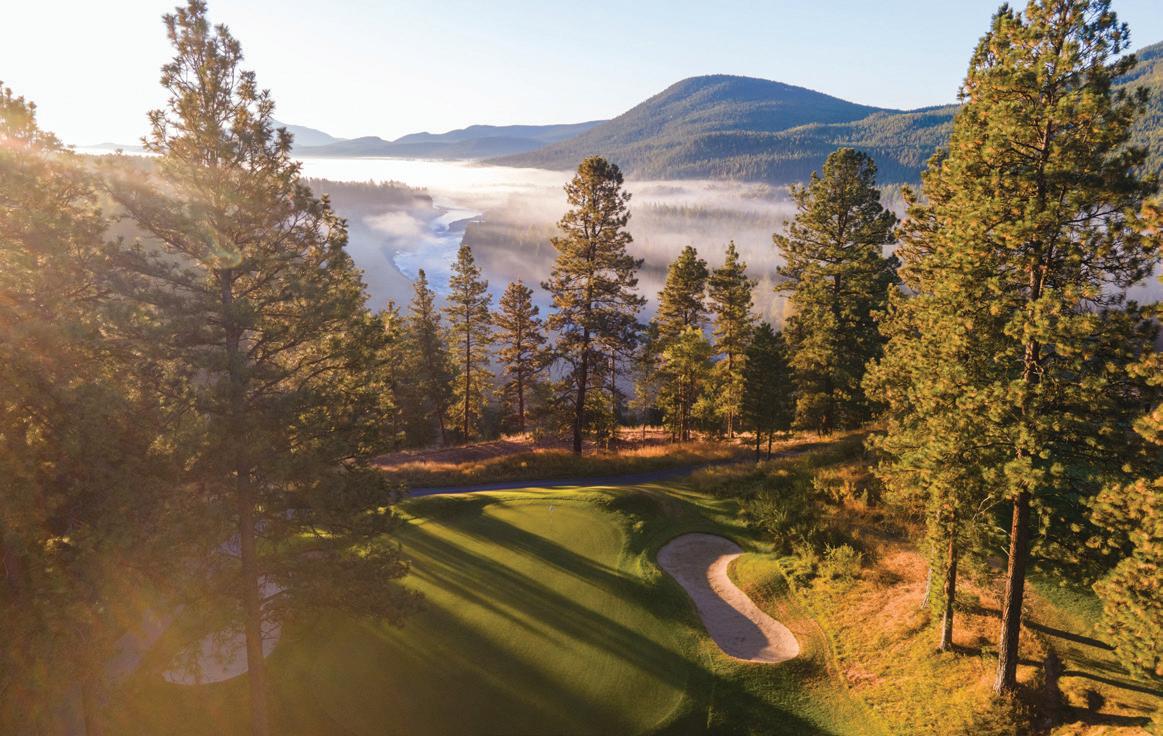
Celebrating 100 years! 1924 - 2024 All East Kootenay residents are welcome to join us July 1st for a round of golf for $19.24! *including power cart. www.purcell.golf 250.427.4161
Daredevil motorcyclist, world-famous stunt performer, the godfather of extreme sports, and — unbeknownst to most — a small-town hockey player with a connection to the Kootenays.
Evel Kneivel, the 1970s pop culture icon, grew up in Butte, Montana where he skated for his high school hockey team. Then known as Bob Knievel, he was a gifted scorer whose hotheadedness earned him plenty of time in the penalty box.
“He was decent,” teammate Tom McManus told author Leigh Montville for his book Evel: The High-Flying Life of Evel Knievel. “On a scale of one to ten, he was a seven. But I’d trust him about as far as I could throw him. He was a real show-off; had to be the life of the party all the time.”
Knievel later joined the
Evel Knievel in a hockey uniform can be found in the Butte city jail where he supposedly received his nickname.
Of Slap Shots and Scorpions
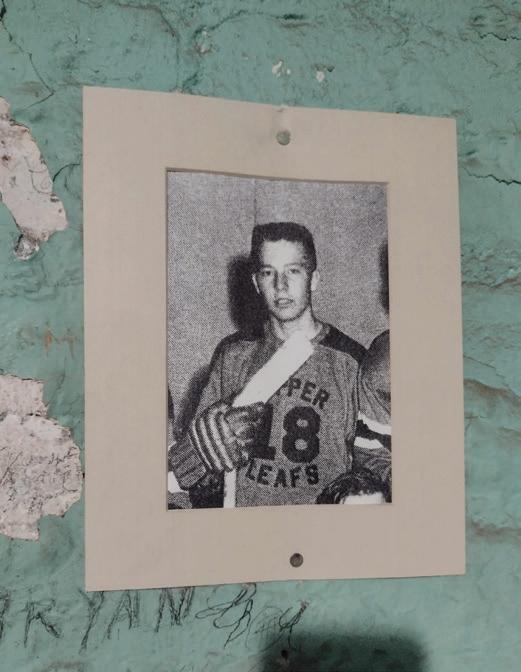
He shattered records, bones, and probably a couple of wooden Sherwoods. But how was it that legendary motorcycle madman Evel Knievel made a Creston connection?
Copperleafs, the town’s senior hockey team whose main problem was finding competition. They weren’t in a league and their closest state rival was two-and-ahalf-hours away in Great Falls, Montana — so they looked north of the border for potential opponents.
Top-flight senior teams
three years later, rechristened as the Canucks, and beat Knievel’s Copperleafs 9-4 and 8-3. Knievel fought Creston’s Don Vigne.
“Coming from an area where babies are given hockey sticks instead of teething rings, the Canadians outskated the Leafs and played their positions
posed to get $50 each. “We never got paid too often,” winger Tubie Johnson told Montville, “but I remember a couple of good meals.”
That season the Bombers had better luck against Creston, taking two out of three games by scores of 8-6 and 9-1. Another fight broke out when Knievel went after
“I’D TRUST HIM ABOUT AS FAR AS I COULD THROW HIM. HE WAS A REAL SHOW-OFF; HAD TO BE THE LIFE OF THE PARTY ALL THE TIME.”
from the Kootenays didn’t have time to travel to Butte for what amounted to exhibition matches, but intermediate teams could be enticed.
The Creston Del-Macs, with a top line of Yaqan Nuʔkiy (Lower Kootenay Band) players, first went to Butte in 1955. They returned
better than the Butte rinksters,” wrote the Montana Standard of the games.
The Copperleafs were replaced the following season by the Bombers, whom Knievel coached and managed. They were described as semi-pro, which meant they charged admission to games and players were sup-
Creston’s Gordon Bens in retaliation for high-sticking.
In the off-season, the Bombers made noise about joining the Western International Hockey League, to which Rossland, Trail, and Nelson belonged, but it came to naught. Instead, they spent another year as an independent team, but
this time Creston wasn’t on their schedule. (For some reason, the Bombers didn’t play on the road, so Knievel never actually visited the Kootenays, as far as is known.)
Both the high and low point of the Bombers’ existence came when they convinced the Czechoslovakian national team to play them in a tune-up match ahead of the 1960 Olympics. Czechoslovakia won 22-3. “The score could have been 105-0 if the Czechs wanted,” Johnson said. “They were kind to us.”
At year’s end, facing a lawsuit for unpaid bills, the Bombers folded and Knievel’s hockey career was over. He was on to his next adventure.
–Greg Nesteroff
CELEBRITY
22 Spring Summer 2024 | The tRENCH
Oct. 17, 1938
Robert Knievel is born in Butte, Montana.
1946
Knievel attends an auto daredevil show, which he later credits as his inspiration to become a motorcycle stuntman.
1956
Knievel is jailed for reckless driving and shares a cell with William (Awful) Knofel, leading to him being called Evil Knievel. (He would later change the spelling to Evel.)
Early 1960s
Knievel becomes a motorcycle dealer in Moses Lake, Washington, and promotes motocross racing.
Jan. 3, 1966
Evel Knievel and his Motorcycle Daredevils debut in California.
Feb. 10, 1966
Knievel suffers his first major injury in a stunt gone wrong in Barstow, California.
Dec. 31, 1967
Knievel tries to jump the fountain at Caesars Palace in Las Vegas. He crashes, suffering a crushed pelvis and femur.
May 25, 1968
Knievel crashes trying to jump 15 Ford Mustangs, breaking his right leg and foot. In all, he would break 35 bones over his career.
Jan. 7-8, 1971
Knievel sells over 100,000 tickets to performances at the Houston Astrodome.
Feb. 28, 1971
Knievel sets a world record by jumping 19 cars at a speedway in California.
1971
The biopic film Evel Knievel is released, starring George Hamilton.
1972 - 1977
Ideal Toy Company releases a series of Evel Knievel-related merchandise.
Sept. 8, 1974
Knievel attempts to jump the Snake River Canyon in Idaho using a rocket-powered bike and parachute. He fails but only suffers minor injuries.
Sept. 21, 1977
Knievel pleads guilty to attacking promoter Shelly Saltman with a baseball bat and receives six months in jail. Saltman later wins a $13-million civil judgment, but never sees any money.
1981
Having lost endorsement deals and with no other income, Knievel declares bankruptcy.
May 20, 1999
Knievel’s son Robbie fulfills his father’s dream of jumping the Grand Canyon. (Robbie later dies in 2023 of cancer.)
Nov. 30, 2007
Knievel dies in Florida, age 69. He'd been suffering from diabetes and pulmonary fibrosis. Thousands attend his funeral.
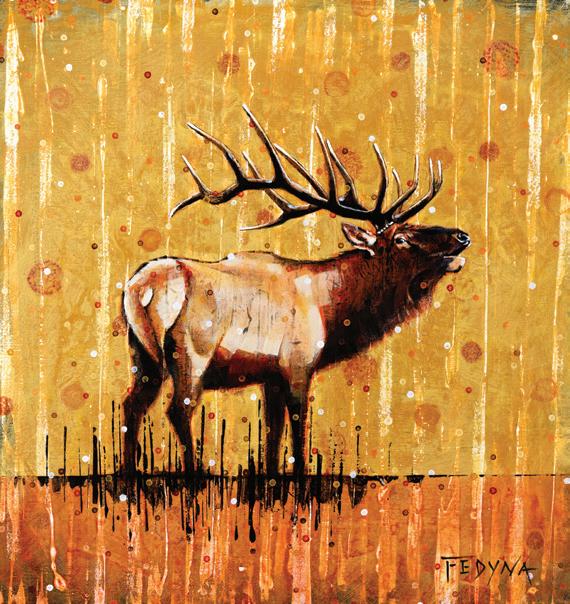

K’naan Dear Rouge Rare Americans Jesse Roper Dawn Pemberton • Phonosonics Brass Camel • Kaeley Jade Alex Maher • Charles Benjamin Resident DJ Cona AUGUST 9-10, 2024 Annex Park • FERNIE BC wapitimusicfestival.com Purchase tickets! A Fresh Mountain Experience
Life
Wheel
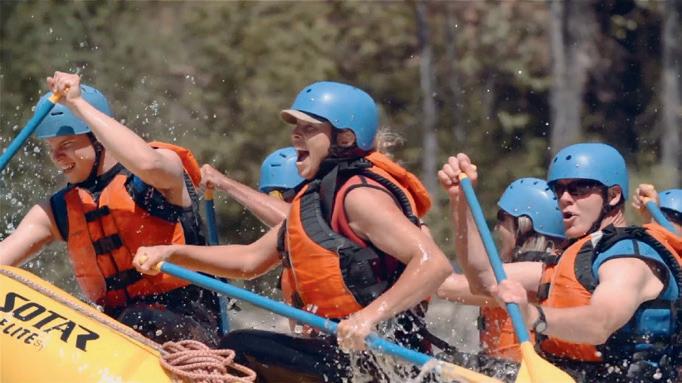


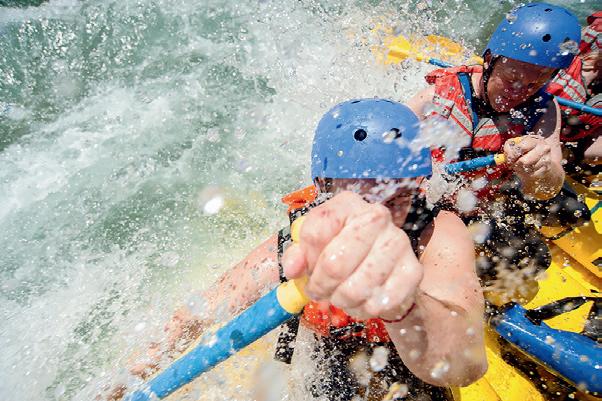


WWW.KOOTENAYRAFTING.CA
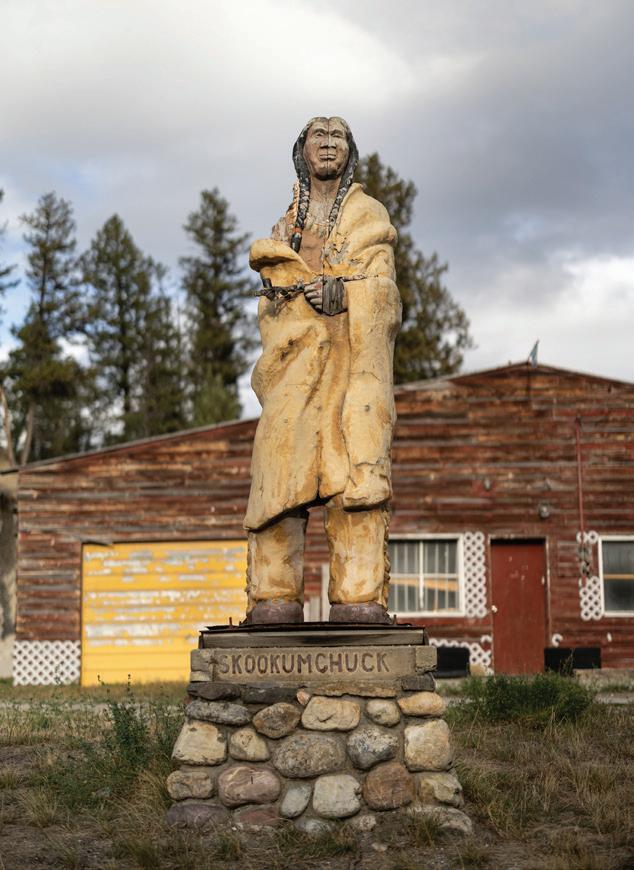
"He could do anything, except make a lot of money,” Karen Barraclough recalls of her neighbour, the artist Bud Amy. “He rented a big house, had five kids to feed, yet couldn’t afford groceries. Artists didn’t make a lot of money back then,” she says over the phone from Skookumchuck, B.C.
Barraclough is a rancher and the owner of B-E Ranch, located 42 kilometres north of Kimberley. Her family has a long history in the area, dating back to 1944 when her dad bought the cattle ranch. “I’ve lived here since Bud carved that statue,” she says, referring to what locals had called “The Indian” since the late ‘50s.
According to Barraclough, Amy traded the eight-foottall statue on the side of
Highway 95 to gas station, garage, and grocery store owner Mel Cowie for $500 worth of groceries.
This was a time of Cigar Store Indians: the storefront carvings crudely attempting the likeness of an Indigenous person, used to adver-
chuck in the back of their parents’ station wagons, extend their arms, mirroring the statue, and say, “How.” This was 65 years before the process of Truth and Reconciliation began, long before sports teams’ names were changed and statues
ACCORDING TO BARRACLOUGH, AMY TRADED THE EIGHT-FOOT-TALL STATUE ON THE SIDE OF HIGHWAY 95 TO GAS STATION, GARAGE, AND GROCERY STORE OWNER MEL COWIE FOR $500 WORTH OF GROCERIES.
Unarmed — Carved 65 years before sports teams names had to be changed and colonialist statues were defiled or torn down, Old Crow went on up. His missing arm is in safe keeping though. Jeff Pew Photo
tise tobacconists. A time of black-and-white westerns, with white actors cast in stereotypical “Indian” roles; a time when children would drive through Skookum-
of violent colonialists were torn down.
Geordie Driscoll grew up in Tata Creek, 16 kilometres south of the statue, and he remembers seeing its
ODDITY
Old Crow, New World
To restore or recycle in the age of reconciliation? A historic highwayside landmark awaits its fate.
broken arm at his parents’ house in 1986 as his dad and a family friend repaired and painted it. “The statue was called ‘Old Crow,’” Driscoll recalls, “and his right arm, extended in greeting, was repeatedly vandalized.”
The statue was fixed again in 1997 by Grant Howse, a friend of Bud Amy’s, but what remains of Old Crow now, Driscoll explains, “is a result of woodpeckers, rot, and vandals.”
Old Crow has seen better days. When you drive by, the fibreglass veneer of his blanket is faded and cracked, and his right arm has been missing for years. Fabienne Groen of Kootenay Tack, and the current owner of the Skookumchuck property, says the missing arm is safely inside her shop. “People
would hang off it to take photos,” she says. She believes the current fibreglass coating is trapping moisture and causing wood rot inside the statue. Despite offers to purchase the statue, Groen says it’ll remain in the current location, at least until her property is sold.
What will become of Skookumchuck’s familiar landmark? Some consider it a significant Kootenay artifact that deserves to be restored, while others feel it’s a kitschy caricature of First Nations people that should quietly disappear so nature can reclaim it, so it can become one with the earth again.
–Jeff
Pew
The tRENCH | Spring Summer 2024 25

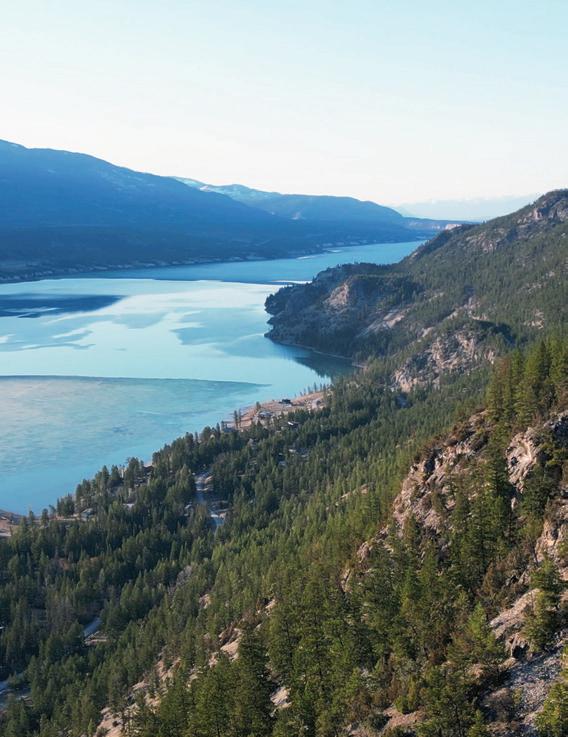




QUALITY PROGRAMS FOR INDUSTRY NEEDS. VISIT: cotr.ca THINK. DO. BECOME. Bringing your dream home to the Columbia Valley. Rachel Sweeney REALTOR® Royal LePage Rockies West Realty 492 Highway 93/95 Invermere BC V0A 1K2 250.899.8996 C | 250.342.5599 B rachel@rockieswest.com | sweeneyrealestate.ca J2 RANCH Locally Raised Wagyu & Bison Hormone/anti-biotic free & grain finished Offering Steaks, Smoked Products & Sides Available year-round in Invermere & Canal Flats justin.larson@j2ranch.com | 250.349.5874
Bates and Bites — Fly fisherfella Jeff Bates, president of the St. Mary Angling Club, and the initiator of Kimberley’s Tie-OneOn Tuesdays. — Jesse Heinrichs
In the Fly of the Beholder
When the drug of the tug is frozen away, what’s an angler to do? Saddle up at The Sully with your box n’ bobbins, and tie one right on.
In the summer, fishing is often a solitary sport. Anglers retreat up Notellum Creek, far from cell service, and even further from other fisherfolk.
But in chillier months, the seclusion loses its appeal. Ice-fishers cluster together like penguins, angling clubs convene for monthly meetings, and fly-tying groups gather in preparation for the approaching thaw.
Such is the case in Kimberley, where fly tyers gather in the historic Sullivan Pub every second Tuesday evening.
Tackle boxes percolate into the 99-year-old pub at 6:30, and by 7:00, the entire back room resembles a Micheals discount bin.
As bobbins whirl and scissors snip, a perfectly balanced formula takes place: one fly tied per one beer consumed. This ratio is likely why these sessions are fondly referred to as Tie-One-On Tuesdays.
The dim lighting, though not conducive to fly tying, is hardly a deterrent for the crafty anglers. What the pub lacks in lumens, it makes up for with a steady stream of draught beer and good company.
FILLING THE QUIVER FOR THE SEASON AHEAD IS A REWARD ON ITS OWN, BUT BUILDING NEW CONNECTIONS WITH GOOD PEOPLE IS PRICELESS.
There are other advantages to tying in the pub as well — at least according to Jeff Bates, president of the St Mary Angling Club, and the initiator of Tie-One-On Tuesdays.
This frugal fisherman sees the pub as an untapped gold mine of material.
When Halloween comes around, most people see the pumpkins pinned along the pub walls as regular old decorations; Jeff sees a sparkling orange foam perfect for imitating the pigmented body of an October Caddisfly.
Where some see a little blue straw poking out of a weekday cocktail, Jeff sees the thin abdomen of a mature
continued on page 28
The fly tying world is teeming with beautiful and complicated flies, some so convincing it can be hard for even a human to differentiate them from a real bug. As amazing as these are, often a simpler pattern can be just as effective at fooling tricky trout.

The pattern below is a simple yet proven fly that works well anywhere in the Kootenays. It's economical to tie, both in time and product, and can be used for long stretches of the season.
Simplified All-Dubbing Leech
The All-Dubbing Leech can be fished any month, as leeches are an important food source for trout year-round. This versatile fly can be fished in both moving and still water, and can coerce a strike at any time of day. With one main ingredient, its beauty is in its simplicity.
Components
Hook: Size 8-12 Wet Nymph or Streamer Hook (shown is a Mustad 9671 in size 10).
Thread: Any black thread that won’t break (shown is UNI 3/0 in black).
Head: Gold or silver cone head bead (shown is a 3/16” gold cone).
Body: Leech Dubbing in black. This pattern can also be tied in olive or chartreuse (shown is Chinook Wind Outfitters Black Peacock dubbing).
Instructions
Step 1: Slide the cone onto the hook with the tapered side butting up against the hook eye.
Step 2: Begin wrapping the thread around the shank of the hook, moving backwards from just behind the cone to just behind the hook point. Once finished, cut off the tail of the thread.
Step 3: Attach a pinch of leech dubbing to the hook shank. Allow one centimetre of dubbing to extend past the bend of the hook and secure the dubbing into place.
Step 4: Take the dubbing pointing forward, and pull it back toward the bend of the hook. Secure the dubbing with a few tight wraps and move your thread forward to halfway up the hook shank.
Step 5: Repeat steps 3 and 4 in the middle of the hook shank, and then move the thread up against the back of the cone head.
Step 6: Repeat steps 3 and 4 up against the gold cone. Once the dubbing is secured at the front of the fly, tie the fly off with three to four whip finishes and cut the thread free.
Step 7: Go fishing. Your fly is complete.
OUTDOORS
The tRENCH | Spring Summer 2024 27
Photo
Buoy Toys — Behold…the Puterbaugh Caddis. And the All Dubbing Leech. (But you prolly already knew that.)
Jesse Heinrichs Photo
Damselfly, hand-delivered and complimentary of the bartender.
These social sessions provide a place for anglers to swap tips and stories, and more importantly, provide people with little or no experience a place to try fly tying for the first time.
The community and camaraderie that can be so elusive during peak-season fishing is found in abundance at these get-togethers. Filling the quiver for the season ahead is a reward on its own, but building new
‘Tie-One-On Tuesdays’ fly night is open to anyone interested in tying (or learning to tie) fly-fishing flies. Meetings take place every second Tuesday at the Sullivan Pub in Kimberley, and start at 6:30 p.m. Limited vices are available. It’s recommended to bring a personal vice and bobbin. All other materials can be provided. There is no membership fee and no prior experience is required. Upcoming dates are April 23, May 7, and May 21. For more information, jesse. heinrichs.1@gmail.com


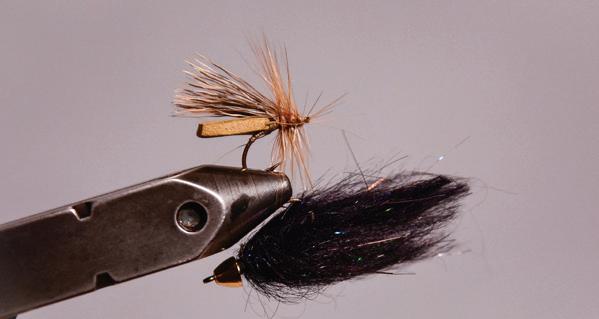
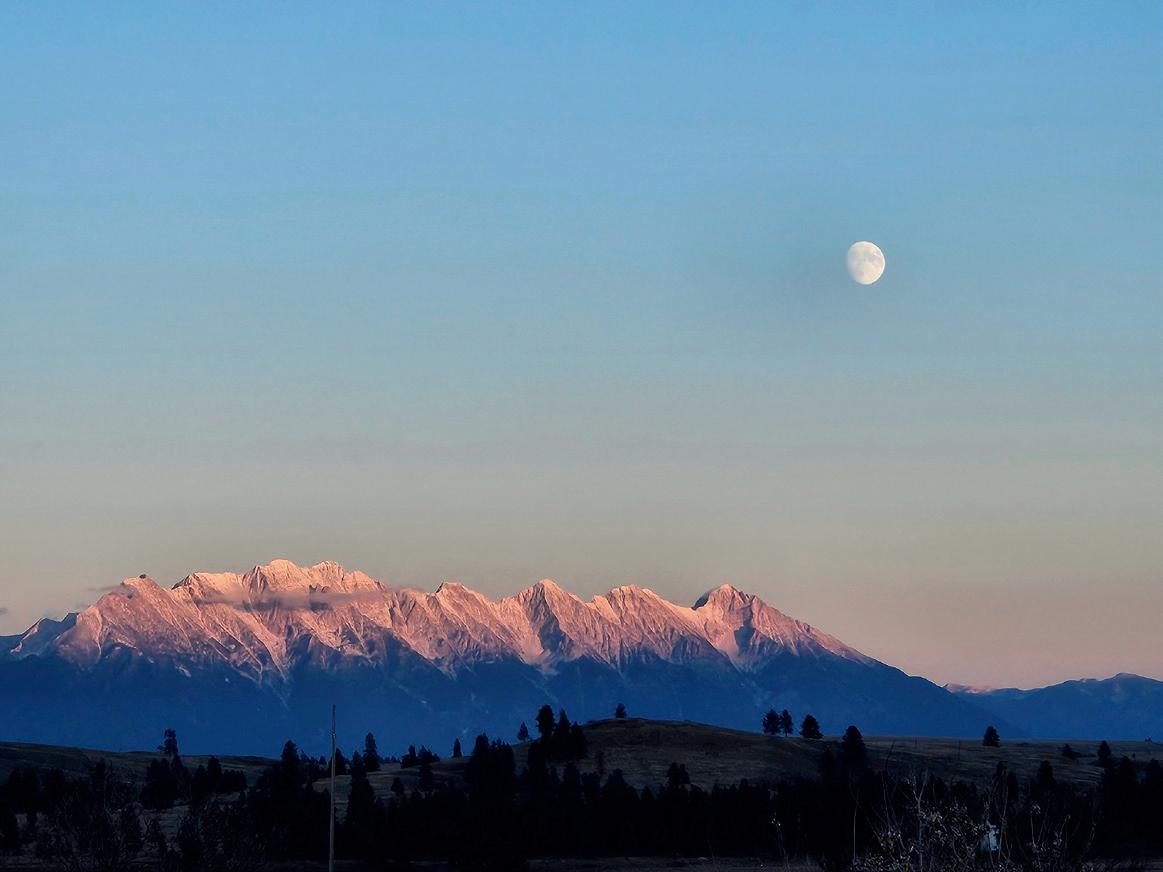
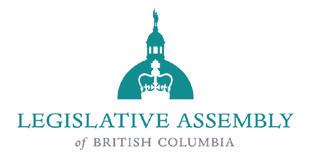

UNITED for the Kootenays REACH OUT We are working for you Doug Clovechok, MLA Columbia River-Revelstoke www.dougclovechok.ca Tom Shypitka, MLA Kootenay East www.tomshypitka.ca OUTDOORS
Originally called Sinclair Hot Springs after James Sinclair travelled from Manitoba’s Red River to the area with a group of Métis, Radium is now called Radium because…well, read on… — photo courtesy Columbia Basin Institute of Regional History
A Steamy Scene
For big city travellers of a bold new route through Kootenay National Park, the original geothermal go-to.
Finally able to flock to the healing waters: this 1920s image of the Radium Hot Springs pool showcases bathers enjoying some of the finest swimming of the era, in the heart of the Rocky Mountains — made accessible partly thanks to the arrival of the automobile and the development of a major new road. Visitors could now enjoy Kootenay National Park, Canada's tenth national park, via highway.
Tourists from across the globe began to visit Radium to soak in this unique landmark in the Columbia Valley by way of the new route carved out with the Bow Valley Parkway, which was followed by a proposal to link the highway from Banff to Windermere in 1910.

"When private interests could not complete the road, the federal government took over the project in return for British Columbia ceding the title to land adjacent to the highway,” wrote Graeme Pole in The Cana-
Banff-Windermere Highway, and the government employed prisoners of war, conscientious objectors, and internees to finish it. The highway was completed in June 1923.
Radium was first devel-
RADIUM WAS FIRST DEVELOPED BY SETTLERS IN THE LATE 1800S WHEN ENGLISH BUSINESSMAN ROLAND STUART PURCHASED THE LAND FOR $160.
dian Rockies: A History in Photographs. “Banff, Yoho, Glacier, and Jasper were known as railway parks. Kootenay was Canada's first highway park."
World War I intervened as the final leg of construction commenced for the remaining 53 miles of the
oped by settlers in the late 1800s when English businessman Roland Stuart purchased the land for $160. It had been formerly known as Sinclair Hot Springs after James Sinclair travelled from the Red River to the area with a group of Métis families in the 1840s.
The Englishman made this First Nations sacred site a popular place for non-Indigenous people by constructing a concrete swimming pool and facilities at the natural hot spring. He later named the establishment Radium after experts from McGill University found non-toxic traces of radon in the water, according to The History of Radium Hot Springs by Parks Canada.
Radium is not the only geothermal site in the East Kootenay: mineral hot pools are located nearby at Fairmont Hot Springs and Lussier Hot Springs, the latter in Whiteswan Lake Provincial Park, between Canal Flats and Skookumchuk.
Thousands of visitors seek these pristine locations annually for relaxation and
rejuvenation. According to the 2019 census for Tourism in the Columbia Valley, the region saw approximately 68,000 visitors.
"People have long been drawn to hot springs, seeking comfort in the warmth and touting healing properties of the rich minerals," writes Kate Barker in A Very Short History of Fairmont Hot Springs in Where Canadian Rockies. "Evidence shows that people have been relaxing here for over 7000 years; both the Ktunaxa and Secwépemc First Nations lived in this area. They dug out baths and sought the water for many of the same reasons people are drawn to this area today."
– Erin Knutson
PAST BLAST
The tRENCH | Spring Summer 2024 29





Loralee Thomas | Real Broker | 250.430.1070 WWW.LORALEETHOMAS.COM birdiesbeverages.com @birdiesbeverages premium vodka + real fruit juice Now at liquor stores near you.
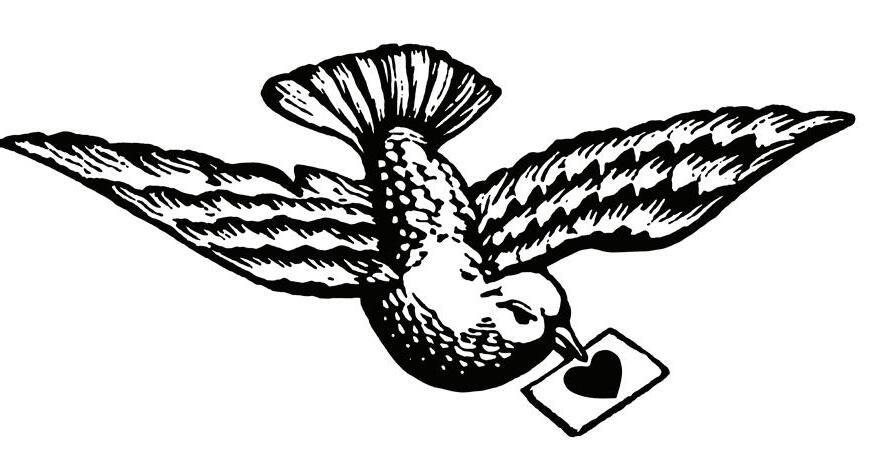
the movies I had envisioned. Instead of starring in Oscar-winning dramas, I ended up making Hallmark movies. It paid the bills for a while, but eventually my life kind of fell apart and I moved back to Cranbrook. Ironically, it seemed my own existence had become a Hallmark movie.
no handsome cowboy came up to me at the rodeo to say, “Howdy ma’am, will you marry me?” No, when I moved back to Cranbrook, I dated an alcoholic on his third DUI. He told me he liked long walks by the river, and only later I realized it was because his truck was impounded.
at the trailhead and waiting to see who passes by. Otherwise, you must resort to the dreaded dating apps.
Tinder Vittles
For Kootenay folk on the prowl for a prestigious partner, single life can be a herd of cats. Not all of them cool.
The Dating Profiles of Kootenay Men
Let’s remember, of course, that every man has his pros and cons.
The Labourer: Your carpenters, framers, roof-
He’s handy around the house. He comes equipped with all the tools and knows how to fix things.
Probably addicted to recreational drugs.
The Hunter/Fisherman: Always posing with a dead animal.
This man can actually put food on the table and keep the grocery bills down.
SPRING IS IN THE AIR, SO PEOPLE ARE FEELING FRISKY.
In case you’ve never seen a Hallmark movie before, I’ll let you know how they go. You’ve got the small town girl living in the big city. Career: stalling. Love life: lackluster. The editor of the online magazine that she works for sends her back to her hometown to write a listicle about a pumpkin farm. At the Harvest Festival, a handsome lumberjack accidentally spills her hot apple cider. At first they hate each other, but then they have to work sideby-side in the bake sale to
Spring is in the air, so people are feeling frisky. As I illustrated, though, the Cranbrook region can be a challenging one in which to find a desirable match. I guess you can live a Hallmark-type life in the Kootenays, with the picture-perfect family and white picket fence. The trick is, though, you have to already have the family when you move here. Those who arrive single may struggle meeting quality people.
While it’s nice to live in an area so focused on outdoor
In case you have not ventured out onto the apps, let me prepare you for what you will see there (see sidebar). (And if you’re already hitched, here’s your glimpse into a world that you’ll luckily never have to take part in.)
The pickings aren’t necessarily slim, but they are interesting. Alas, as a straight woman, I can only report on the dating profiles of Kootenay men. I invite others to share their own Tinder experiences with some letters to the editor!
– Sarah Stupar
If you marry him, you’ll be wearing a camo wedding dress.
The Ski/Snowboard Bum: Every single photo on his profile is from the resort.
Actually, I can’t really think of any. Probably Australian.
The Cowboy/Rancher: He was doing it before Yellowstone made it cool.
The strong, silent type. He won’t talk too much, so you’ll have lots of peace and quiet.
The Hockey Player : He was a big deal in Junior, you know.
He was taught that team bonding includes questionable activities we can't actually print.
I was dating a cowboy once who had previously broken his back in a bull riding accident. Every time we had sex, he had to be on the bottom.

YOU
FUNNY
Local rockstar status.
The tRENCH | Spring Summer 2024 31
PROFESSIONAL, FAMILY-FRIENDLY DENTAL SERVICE
Serving clients in Kimberley and the surrounding communities. We offer a full range of services to sustain your oral health and improve your smile, including routine care and restorative treatments.
SERVICES
* General Dentistry
* Sedation Dentistry
* Orthodontics
* Dental Implants
* Wisdom Teeth
* Crowns & Bridges
* Botox®

































Dr. D. Eric Nelson | Dr. Jordan Enns | Dr. Spencer Dunn 90 Wallinger Avenue | 250 427 5366 KIMBERLEYFAMILYDENTAL.COM
ACCEPTING NEW PATIENTS!

STRENGTHENING THE PLACES WE LOVE
ou r t
Columbia Basin Trust gratefully operates on the unceded traditional territories of the Ktunaxa, Lheidli T’enneh, Secwépemc, Sinixt and Syilx Nations.
rust.org/stories

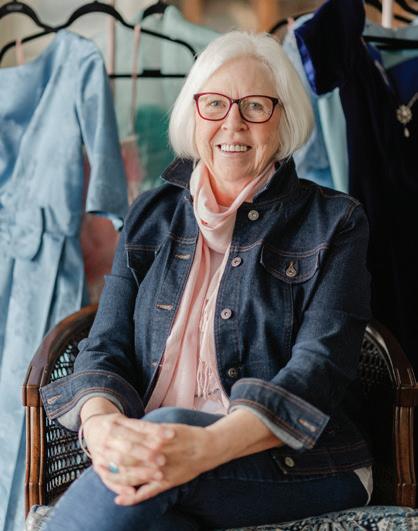
Rad Grad
From the ‘50s to the ‘90s, a Kootenay prom dress retrospective.
Words by Jacquie Moore
Photos by Nicole Leclair
Long after we’ve forgotten our calculus mark, our crush, and our locker combination, the memory of what we wore to prom lives on. A collection of Kimberley’s vintage gowns proves that a cherished piece of clothing can transport us to the past and shine a beautiful light on the future.The opportunity to memorably mark an occasion with a sartorial expression of who we are — be it chic, rebellious, laidback, or quirky — doesn’t come up very often. Prom (shortened from promenade dance, and often informally referred to as grad) is one special event for youth to do so.
Across the East Kootenay, graduating teenagers are celebrating the end of an era that has coloured and structured most of their lives. They reflect on more than a dozen years of work and play, physical and emotional transformation, tiny victories and arduous struggles, and, of course, friendships — some fleeting, others forever.
34 Spring Summer 2024 | The tRENCH
Spirit of '66 — Margot Evans, who graduated from Kimberley’s Selkirk Secondary a scant 57 years ago, is also a collector of local history, grad dresses included. Margot provided the dresses for Trench photographer Nicole Leclair, modelled by current Selkirk grads, in settings throughout the historic high school.

The tRENCH | Spring Summer 2024 35
These stories are woven into our adornments. For Margot Evans, a lover of local history who graduated from Selkirk Secondary in Kimberley in 1966, the outfits worn to honour special thresholds like graduation can hold memories that become more precious and meaningful with time.
For instance, when she looks back at her own graduation attire, she recalls not only how elegant she felt in her sky-blue taffeta dress with pearl buttons and long white gloves, but she thinks of her beloved cousin, Mary Charlton, who sewed it for her. “I picked the pattern and fabric from the local store here and Mary volunteered to make it for me,” explains Evans, whose graduating class was one of the first in the region to make the move from cocktail dresses to floor-length gowns.
In recent years, Evans has managed to give a second life to a handful of prom dresses that belonged to local friends and family, even serendipitously reclaiming an old friend’s circa 1959 gown from a local vintage store. Evans’ collection inspired a recent window display at Kimberley’s Sew Creative Quilt Shop that featured half a dozen vintage graduation frocks, including her own. “It’s interesting to me how sewing techniques have evolved,” she remarks.
Evans is struck by how much styles change over the decades, and then change again, circling back on themselves. “Everything old is new again,” she says. “Any of those dresses from the ‘50s to the ‘90s could be worn today.” (We’ve got proof!)
Evans plans to donate her collection to the Kimberley Heritage Museum. Indeed, each dress offers a small glimpse into the life of a Kootenay youth during a particular era, on a notable day that would have been — and still is — defined by both teary endings and jubilant new beginnings.
Thirty, fifty, seventy years from now, who knows which looks from this year’s graduating class will spin through the fashion cycles and come out the other side still charming and stylish; that’s for future collectors to know.
What matters now is that however they choose to express themselves, every student who crosses the stage, parades through downtown in their finest, or smiles for one final class photo is an essential thread in the vibrant fabric of this place.


1963
According to Evans, her older sister, Susan Barr-Robertson, “didn’t wear dresses unless she had to.” Clearly, when she did, she went all in. Susan graduated in 1963 and her dress, purchased at Kimberley’s (now defunct) Laura’s Dress Shop, is retro-chic on Nicole Cowl. Passionate about art and jewelry design, Nicole is excited to “learn more about herself” as she makes her way into the wider world. We can’t wait to see what she creates.
36 Spring Summer 2024 | The tRENCH
Sporting a vintage '89 collegiate jacket that belonged to the daughter of one of Evans’ friends, Hunter Carr says living in Kimberley "has been one of the best things to happen to me." While he'll be sad to move on, he plans to make the most of his last summer in the Kootenays enjoying lake life before starting a Bachelor of Science program at Vancouver Island University.
Each dress offers a glimpse into the life of a Kootenay youth on a day that would have been — and still is — defined by both teary endings and jubilant new beginnings.





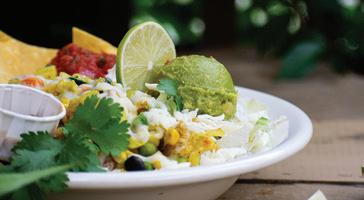

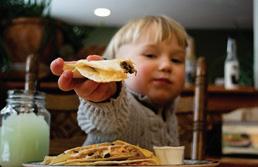
1989
BURRITO Grill Online Ordering . Casual Dining . Catering . two outdoor patios . Take-out . 160 Howard Street . Kimberley BC . 250 - 427 - 0502 . burritogrill.ca 15 years of family-run business.


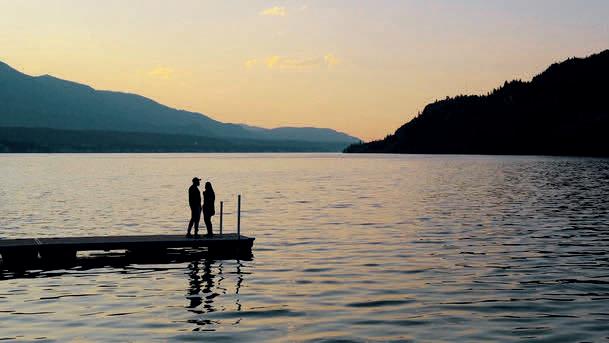


open monda y -
9am-4pm Good, I’m going to be immortal! (Vampire puns) New study links coffee to a long life… VILLAGE SOCIAL CAFÉ Mon-Sun: 7am-3pm Sat Dinner: 5-7pm 4957 Burns Ave, Canal Flats Offering breakfast, lunch & homemade goods C: 250 409 4738 village.social@bidco.ca Come join us for a fresh cup!
saturday
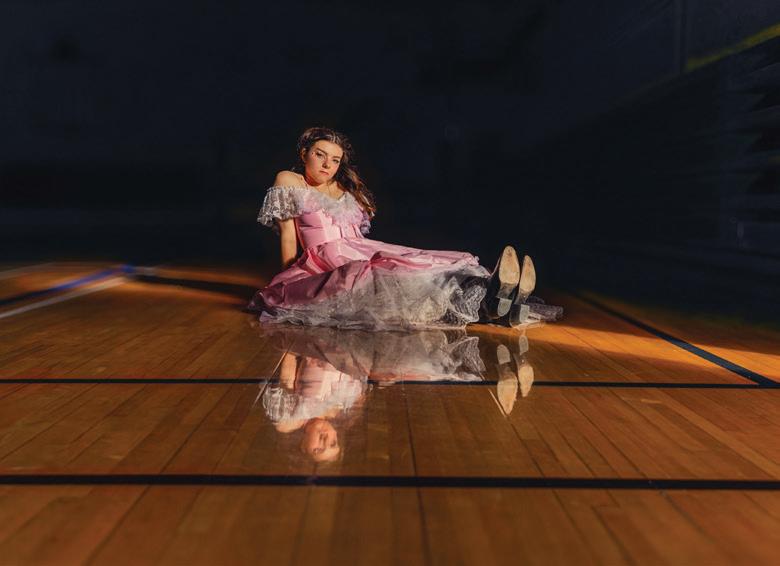
1960
On schedule to graduate in 2025, Paige Johnston brings her unique charm to this sweet, circa 1960 gown that belonged to another Selkirk grad. Evans discovered the dress when she was helping a friend clean out her storage barn; the dress faded slightly after a thorough cleaning, but it remains as beautiful as the day it was purchased at a Kimberley dress shop more than 60 years ago. As for Paige, she plans to design and create a "mushroom person" costume throughout this summer and fall. We'll be eagerly tuned in to watch what she wears to her own grad next spring.
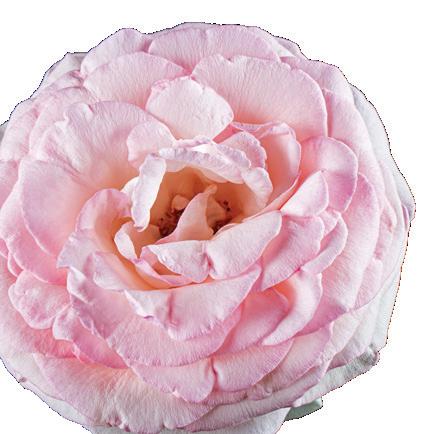
1990
This sweet confection was worn with pride by circa 1990 graduate Kimberley Balcom who, in a way, never left her beloved alma mater: she’s now a school custodian at Selkirk High. The student modelling Kimberley’s dress, on the other hand, plans to get as far away from her hometown as possible — at least for a little while. “After grad, I’m going to work and save up to travel to Southeast Asia,” says Willamena Honeyman, who plans to accessorize her own prom dress with a pearl necklace that once belonged to her great grandmother.

The tRENCH | Spring Summer 2024 39



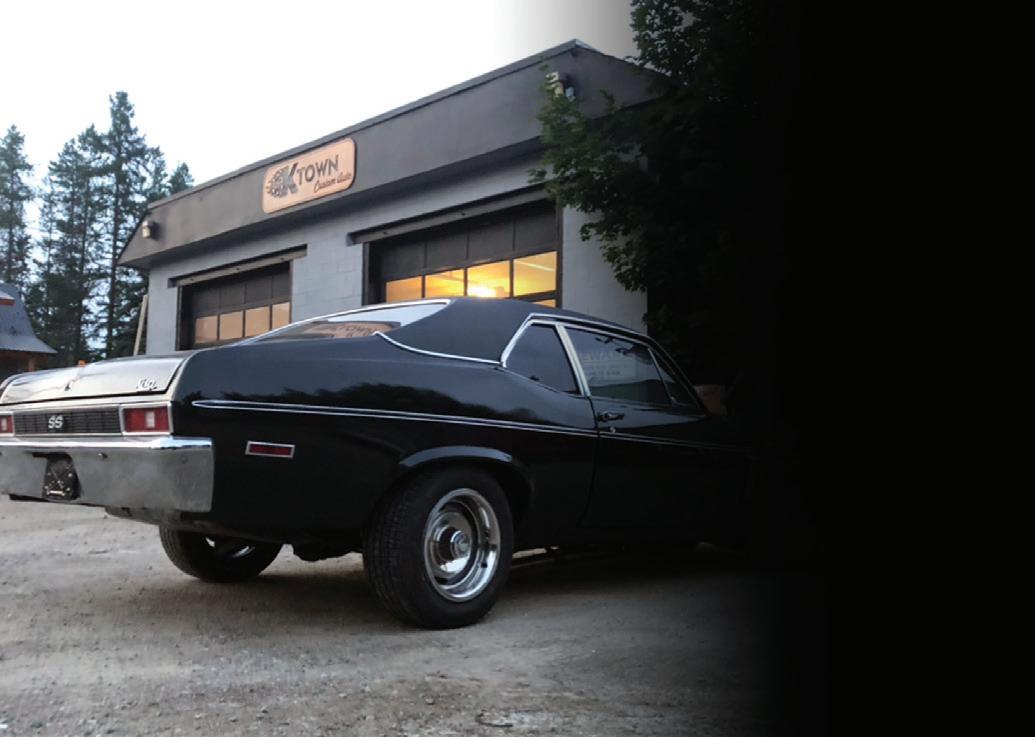
Hours & Menu at deerparkdiner.com 130 Deer Park Avenue Kimberley, BC 2820 ROTARY DRIVE, KIMBERLEY | 250.432.2180 | KTOWNCUSTOMAUTO.CA Your Local Full Service Auto Repair Facility. We’re committed to providing a stress-free experience to both new and returning customers. Our shop only uses parts from quality brands to ensure that your vehicle is always ready to drive. Services: • Glass experts - replacement & repair • Wheel alignments • Oil changes • Tire swaps • Brakes • Suspension • And EVERYTHING else in between!! We are your one stop for anything automotive.

Every student is an essential thread in the vibrant fabric of this place.
1959
In 1959, Pat Thompson and her boyfriend drove to Lethbridge to purchase this gorgeous sweetheart dress for Pat's prom. "That would really have been something back then, going all the way to the city to buy a dress," says Evans. Glamorous as all get-out, the dress is modelled here by Halle Krahn. She looks forward to graduating alongside two of her most cherished classmates; all three will wear matching necklaces with their birthstones to honour their friendship. A Grande Prairie transplant, Halle will cross the stage in front of her extended family who are making the trip to celebrate the milestone. After grad, Halle plans to pursue writing and English literature. "I want to share meaningful stories with the world,” she says.
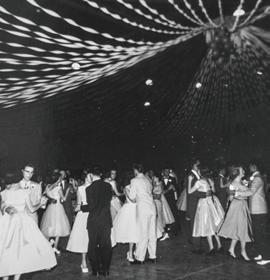
1994
This blue velvet dream belonged to Evans’ daughter, Andrea, who graduated from Selkirk High in 1994. “We bought it at The Bay in Calgary and as soon as Andrea tried it on, we both loved it,” says Evans. Turns out they weren’t the only ones who did: a classmate and neighbour came to that year’s prom in the same dress, only in green. Worn here by Mora Duffy, the gown cost more 30 years ago than the one she’ll wear to her own upcoming grad: “My mom found my dress for $10 at a thrift store.” No doubt she’ll look just as red carpet ready as she does here. Mora’s looking forward to attending the University of Victoria in the fall. “I lived on Vancouver Island for most of my life, so I can’t wait to get back to the ocean.” Still, she says she’ll miss her “wonderful friends and teachers” in Kimberley.

The tRENCH | Spring Summer 2024 41
SHOULDER SOLDIERS
Weather, or not, it’s get-out-and-go-time — by bike, boot, and boat. Creston-based Trench writer Danette Polzin outlines your East Kootenay early season adventure ops amongst the melt, mud, and springtime sizzle.
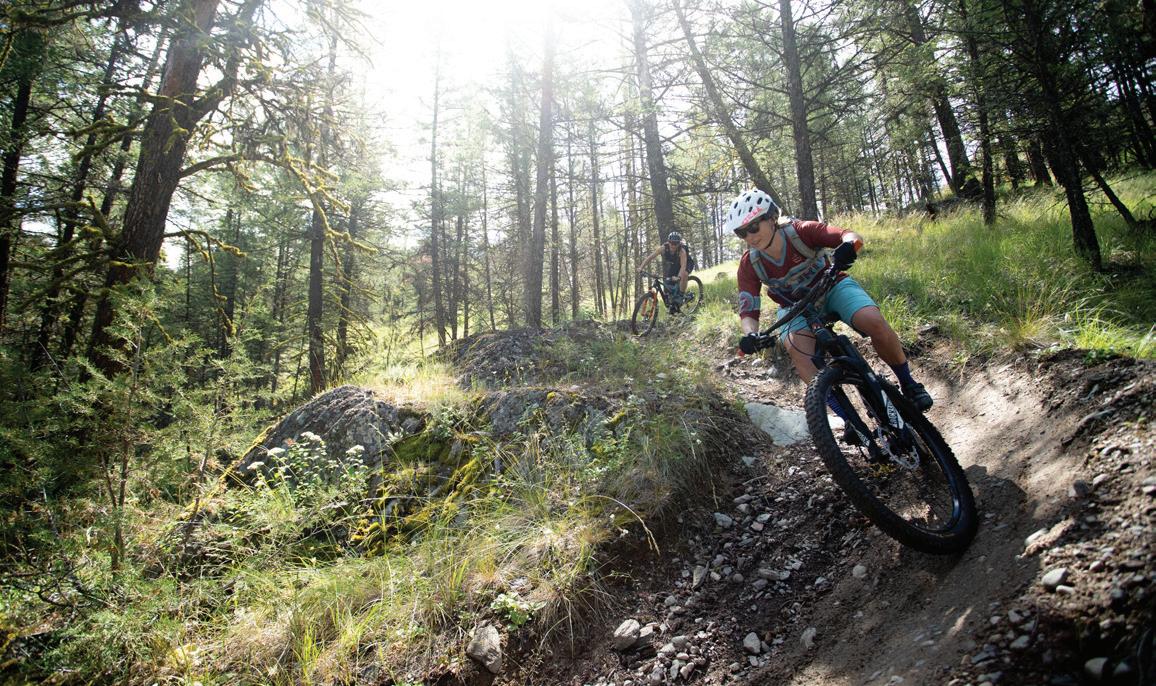 BY DANETTE POLZIN
BY DANETTE POLZIN
As the days grow longer, many of us are struck by our annual yearning for snug hiking boots and the weight of a loaded pack — only to be stalled by the mountains’ lingering snow. But we don’t want that to stop you from grabbing your gear and hitting the trail!
And so, behold: a list of our top-ten shoulder season hikes in the East Kootenay, as well as our favourite destinations for paddlers and mountain bikers — all perfectly suited for this transitional time of year.
The locations can all be accurately located on Google Maps, and most are on TrailForks. Please practice responsible and safe trail use: check weather and trail conditions before you go; prepare for all elements and emergencies; leave no trace; and follow trail use guidelines. And have fun out there!
Although our chosen ten hikes are in no particular order, the first four are our top picks for their ease of access, sense of adventure, and ability to be a full-day outing — plus, three of them even have potential for spring polar plunging. Brrr!
Banksy —
Eager riders earn their turns with lofty berms on the Chewbacca Rocka trail in the Cranbrook Community Forest. Robin Munshaw Photo, courtesy of Cranbrook Tourism
42 Spring Summer 2024 | The tRENCH
WALK IT OFF
Put some springtime sole power to the test on these early season sojourns.
Pilot Bay Provincial Park
› Distance: 4 - 7 km roundtrip
› Time: 2 - 4 hours
› Difficulty: Easy
A year-round destination, Pilot Bay Provincial Park takes up a section of the Pilot Peninsula on Kootenay Lake, and offers several access points to pebbled beaches. With cedar groves woven through the forest and wooden bridges crossing small streams, it’s easy to be swept away by this surely enchanted forest. (Note that bikes are not permitted inside the park.)
Silver Spring Lakes
› Distance: 8.5 km
› Time: 2 - 3 hours
› Difficulty: Easy to Moderate
Close to Elko, B.C., you will find not one, not two, but three lakes nestled together, each of them stunning with dramatic rock walls towering over glistening turquoise waters. A growing sense of serenity is achieved with each lake visited, the third offering the option to perch on giant moss-covered rocks for lunch. Silver Spring Rim — a more physical and adventurous hike, with almost 500 metres of elevation gain and a 9 km round trip — is another option, offering panoramic views of the lakes below.
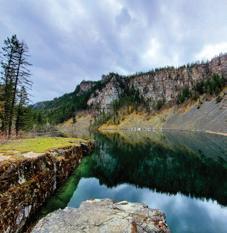

Premier Lake Loop
› Distance: 7 km
› Time: 2 - 3 hours
› Difficulty: Easy to Moderate
An early season favourite, this is an essential for Columbia Valley hikers. Each lake is more breathtaking than the next, boasting brilliant hues of green and blue that reflect tree-swathed shorelines and a lofty mountain backdrop. Some of the high points along the trail offer glimpses of Premier Lake below, and it’s possible to add a 2 km detour to Cat’s Eye Lake at the beginning or end of your outing.
Old Coach Loop / Deja View
› Distance: 15.5 km circuit
› Time: 4 - 6 hours
› Difficulty: Moderate
Balancing Rock / Fern Forest / Mt. Creston
› Distance: 2 - 7 km
› Time: 1 - 3.5 hours
› Difficulty: Easy to Moderate
Spring ting — The crystal-clear waters of Silver Spring Lakes are popular swimming locales when the weather warms.
Old Coach runs between Radium Hot Springs and Dry Gulch, and can be turned into a circuit with the addition of Deja View. The trail’s nearly full sun exposure makes it a top pick for early season access, and plenty of bluffs offer dramatic views of the Columbia River wetlands and Purcell Mountains. The Old Coach trail is steeped in fascinating history, and signage along the way tells its tales. Those wanting a shorter, easier outing can simply pick one of several entrance points and enjoy the trail until ready to turn around.
Hikers can choose their own adventure, based on their desired difficulty and length, and trails can be hiked either out-and-back, or as a circuit. Fern Forest boasts lush cedar groves towering above Summit Creek, and Balancing Rock is more challenging with its short, steep, and exposed push to a gorgeous viewpoint that overlooks the Creston Valley. Continue further up to meet the namesake rock, and even further to ascend Mt. Creston, where you’ll find more views and a seasonal waterfall.
Danette
Polzin Photo
The tRENCH | Spring Summer 2024 43
Look here, sun — A hiker takes in the spectacular views offered on the Windy Bluff trail in the Cranbrook Community Forest. FieldandForest.co Photo, courtesy of Kootenay Rockies Tourism

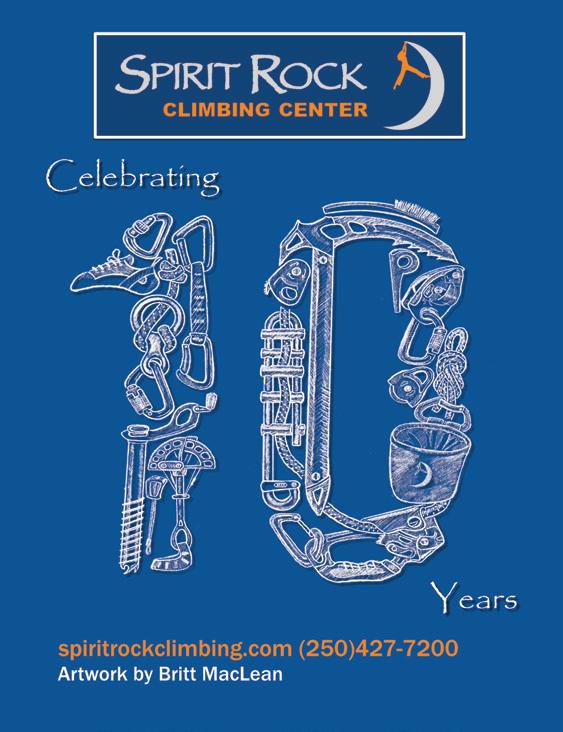
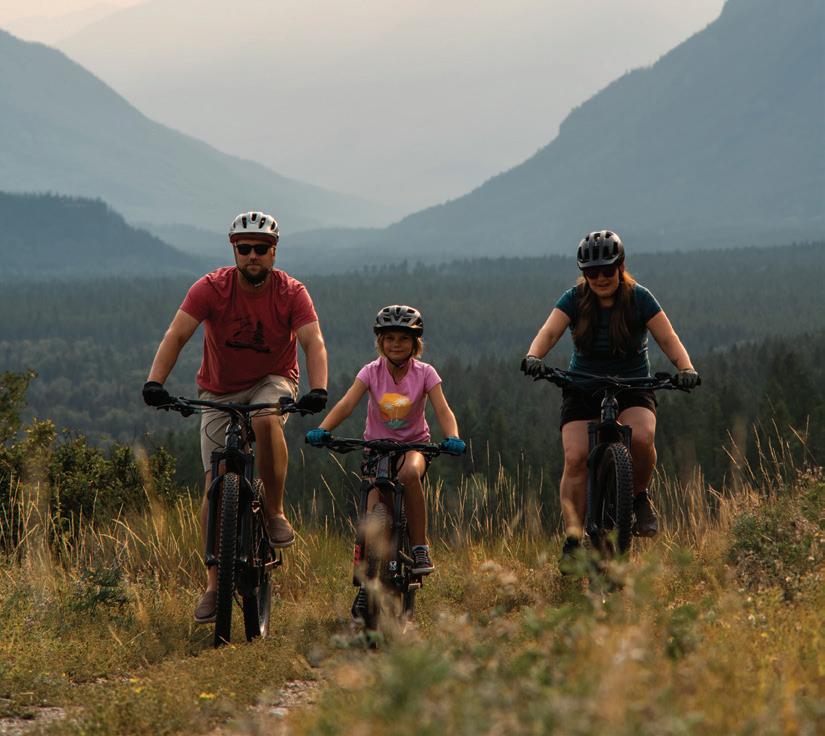
YOur experience is our business RENTALS • SERVICE • SALES 778.481.5156 blackdogcycleandski.com Scan here to see our entire (CANADIAN MADE) Rental Fleet
Eager Hill / Cranbrook Community Forest
› Distance: Varied
› Time: Varied
› Difficulty: Easy to Difficult
Another choose-your-own-adventure trail system, this spot has many access points and ample options for all abilities — from short, gentle forest wanders to glute-busting climbs with sweeping views of the Rockies. It’s an excellent location for both hikers and cyclists looking for adventure, springtime and year-round.
Fairy Creek Falls
› Distance: 4.5 km
› Time: 1 - 2 hours
› Difficulty: Easy to Moderate
A year-round Fernie favourite for almost all ages and abilities, this hike is most impressive during Spring’s high waters, when the waterfall is at its most glorious. The trails leading to the falls meander the lush lower slopes of Mount Proctor.
Sunflower Hill / Kimberley Nature Park
› Distance: Varied
› Time: Varied
› Difficulty: Easy to Difficult
With plenty of trail options for all abilities, and several access points, the Sunflower Hill Loop remains a local favourite for early-season outings. With almost full sun exposure, balsamroot flowers bursting across the landscape in Spring, and breathtaking views of the St. Mary River Valley, it’s not hard to see why. Hikers can add in any number of other routes, and mountain bikers may also score some early-season rides.
Marion Benchlands
› Distance: 12.5 km
› Time: 3 - 5 hours
› Difficulty: Moderate
An esteemed conservation project with the Nature Conservancy of Canada, the Marion Benchlands offer amazing views, opportunities for wildlife sightings, and trails ranging from old roads to single tracks that please hikers and mountain bikers alike. It’s usually accessible by the end of March.
WATER BABY
Kootenay River to Kootenay Lake
Adventurous paddlers looking for a longer outing can access Kootenay River in Creston and paddle to the mouth of Kootenay Lake. A vehicle drop or pick-up is required at one of the lake access points on Highway 3A. This paddle is recommended during high water when the river has a good current and even then, you can expect the journey to take several hours.
Wycliffe Buttes
› Distance: 4km (1st butte), 8.5-10km (2nd butte)
› Time: 1.5 - 4 hours
› Difficulty: Easy to Moderate
The trail to the first butte is accessible year-round, with two different access points and the option to hike it as a circuit. The expansive landscape bursts with crocuses and balsamroot in Spring, and offers sweeping panoramic views of both the Rockies and Purcells. Most travelers only complete the first butte, but the odd hiker looking for a longer trek will head to the second. Please support conservation of these grasslands by sticking to the trails.
Lake life — Forget walking the dog; take Fido for a paddle.
Just Give’r (Back)
Don’t forget your Trail Karma: donations made through TrailForks provide volunteers with much-needed funding for building and maintenance. And remember your spring mountain biking etiquette: YES to firm trails in the morning and evening, NO to midday mud!
Riding High Mountain bikers take note: Panorama Bike Park opens for the season on May 18, 2024; Fernie Alpine Resort’s Bike Park opens for the season on June 22, 2024.
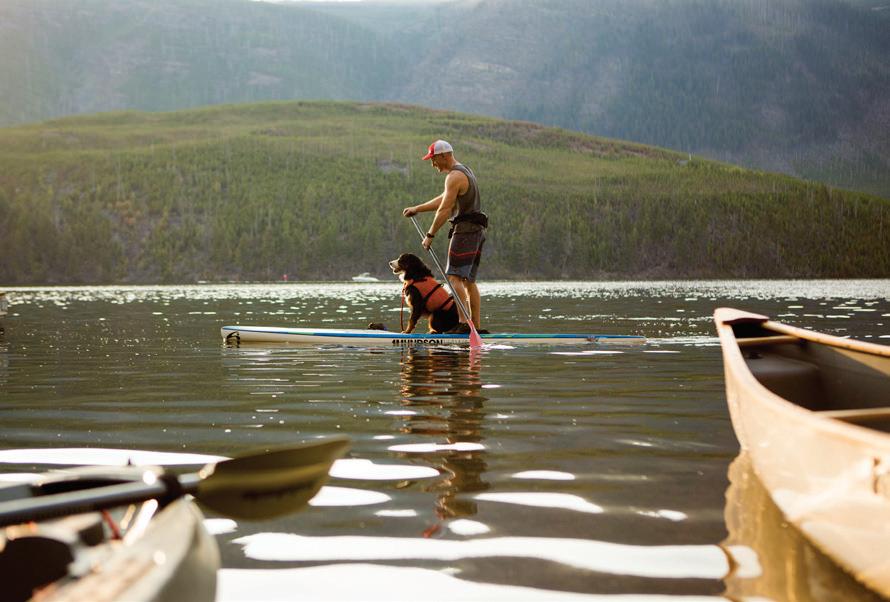 A selection of paddles to, well, wet your appetite.
A selection of paddles to, well, wet your appetite.
The tRENCH | Spring Summer 2024 45
Abby Cooper Photo, courtesy of Cranbrook Tourism
Premier Lake
Located within the Provincial Park Campground, Premier Lake offers paddlers of all levels serene early season paddling in an idyllic mountain setting. Stoney Lake
Known to the locals as Stoney, but named on the map as Hahas, this small lake offers family-friendly paddling opportunities where a variety of birds and turtles are often sighted. Note that access requires driving a few kilometres on a forestry road.
Valley views — Make time for play after your paddle when you land on the mouth of the Kootenay River at Kootenay Lake, just north of Creston. Danette Polzin Photo
Lazy Lake
Approximately 20 minutes northeast of Wasa is a paddlers paradise: stunning green waters, towering cliffs, and bald eagles diving for their lunch provide you with a worthwhile early-season outing.
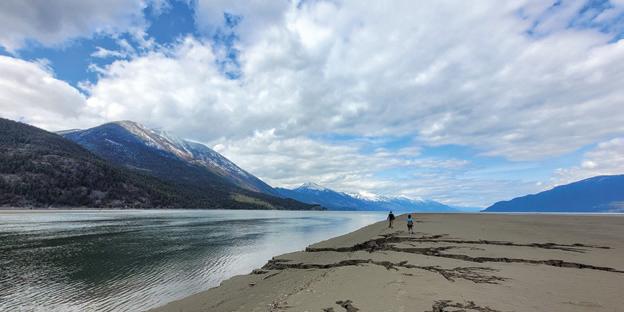
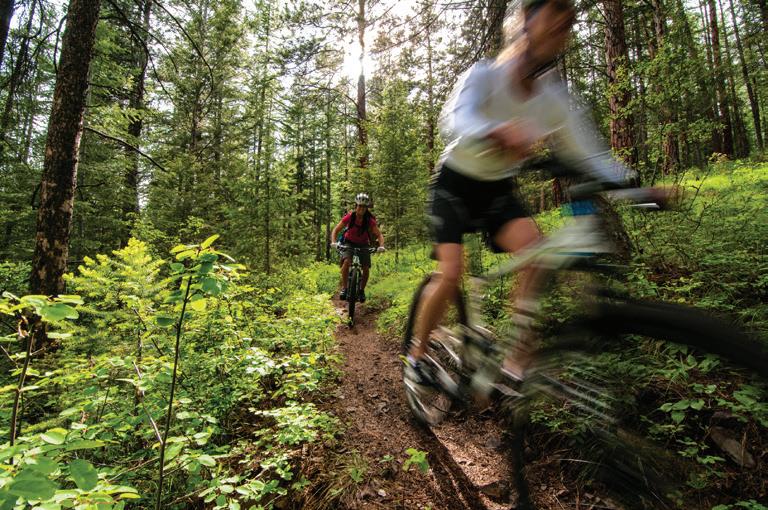
RAD RIDES
Early season mud, sweat, and gears.
Eager Hill / Cranbrook Community Forest
A variety of sun-exposed trails offer burns, berms, and turns for early season riders of all levels and abilities.
Nature Park
From cross-country to downhill and gentle doubletrack to technical features, this extensive trail system offers something for everyone.
Swine Flu
An almost 7 km moderate-to-difficult loop accessed near the Fernie Visitor Information Centre makes you work for your rewards, but it’s definitely worth it. (The trail is typically inaccessible until late-April or early-May.)
Kloosifier
At just over 8 km, this blue-rated singletrack is a part of the Lillian Lake riding area outside of Invermere. Good sun exposure and fast, fun features make it a spring-riding hit.
Three pointer — With over 20 kilometres of riding, the Montane Trail Network in Fernie provides a perfect day with friends.
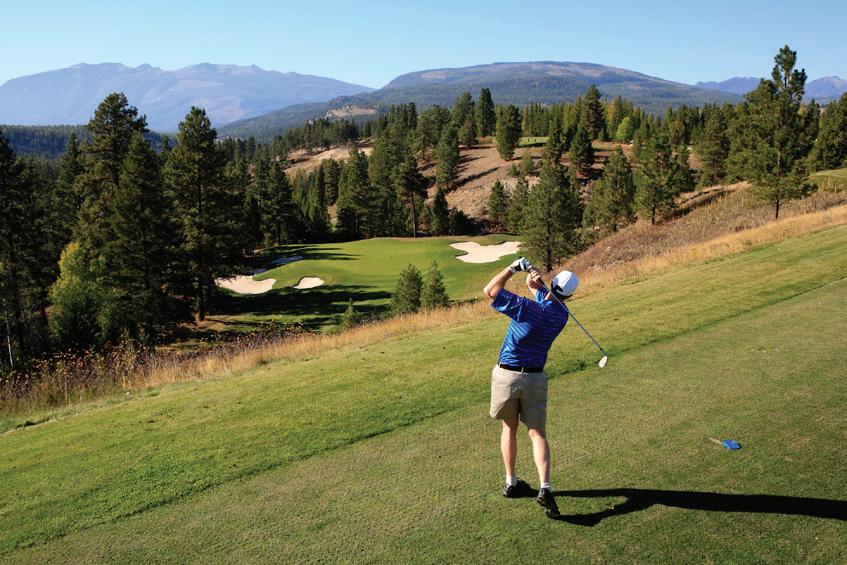
A good place to be choosing your own adventure.
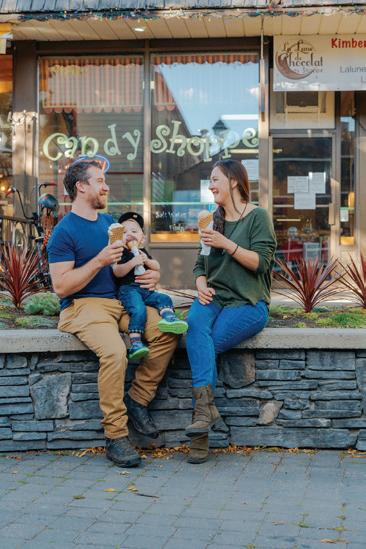 Vince Mo Photo, courtesy of Tourism Fernie
Vince Mo Photo, courtesy of Tourism Fernie
Kimberley ca @CityofKimberley


In the 1900s, Interior B.C.’s wild horse populations, including Columbia Valley herds, were all but destroyed in a bid to save vital grassland needed by ranchers and farmers of the day. But a veteran Kootenay biologist’s best-selling book on the subject shows a darker and misguided truth.
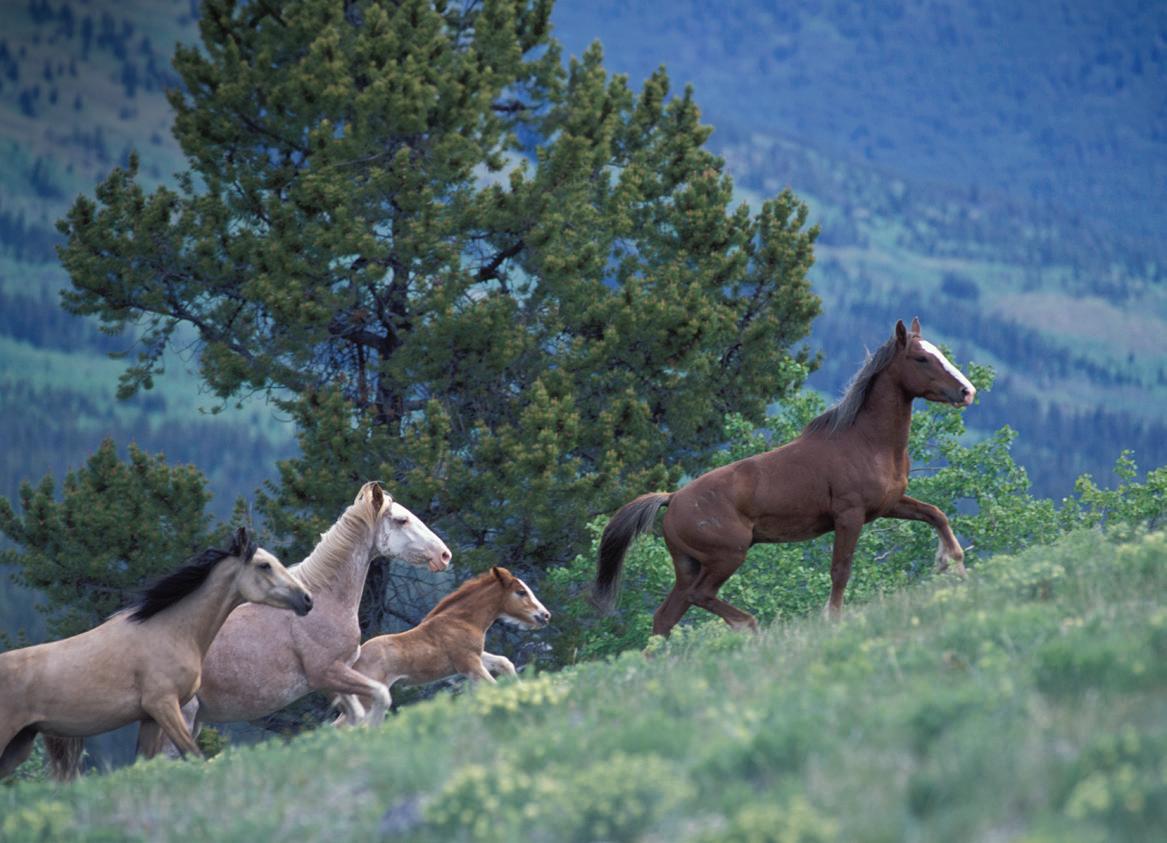 w. Wayne McCrory
p. Patrice Halley
w. Wayne McCrory
p. Patrice Halley
The Wild
Ishot the last one way over there. An old, lone white mare,” reminisced Lester Pierce as he leaned against his log cabin. The aging trapper and hunter pointed a gnarled trigger finger toward a nearby mountain swathed in bunchgrass. “Oh, she was hard to put down.”
It’s clear in his voice that Pierce wasn’t happy about killing off the four or five dozen wild horses remaining in the Elkin Creek Valley. “Forestry drove into my yard one day back in 1988 and offered me a bounty to get rid of them all for a new cattle range tenure,” he explained. “When I said it wasn’t something I’d be happy about, he said he would just pay someone else. What was I to do? I needed the money.”
Up on the pristine Chilcotin Plateau, where Pierce ran his trapline for decades, I had started a decade-long study of the ecology and genetics of wild horses with the Tsilhqot’in Nation and Friends of the Nemaiah Valley. Pierce had left out salt blocks for the horses that were not part of the government’s earlier bounty hunt down in the valley. I had come down to his cabin that day in 2021 to talk to Pierce; to try to learn why there weren’t any wild horses in Elkin Creek Valley despite an abundance of healthy bluebunch wheatgrass, while a healthy wild horse population still roamed on the Plateau. Now I knew.
A Scapegoated Species
As my research interest in wild horses grew, I continued to dig deeper into the origins, genetics, range ecology, and history of the Chilcotin’s wild horses — including their cultural significance for First Nations peoples and the traditional management practices they used. I also looked closely at the century-long “Range Wars” waged by the cattle industry across B.C.’s interior grasslands to rid the region of the species. As
far as I could tell, the 1988 slaughter was the last “unofficial” government bounty hunt, after announcing the last official one in 1967.
My queries to the B.C. range managers for more information on Pierce’s bounty hunt consistently went unanswered. Eventually, I was told, guardedly, that there was nothing on the records. As our study on the wild horse ecosystem on the Plateau continued over the next several decades, other than the brief
48 Spring Summer 2024 | The tRENCH
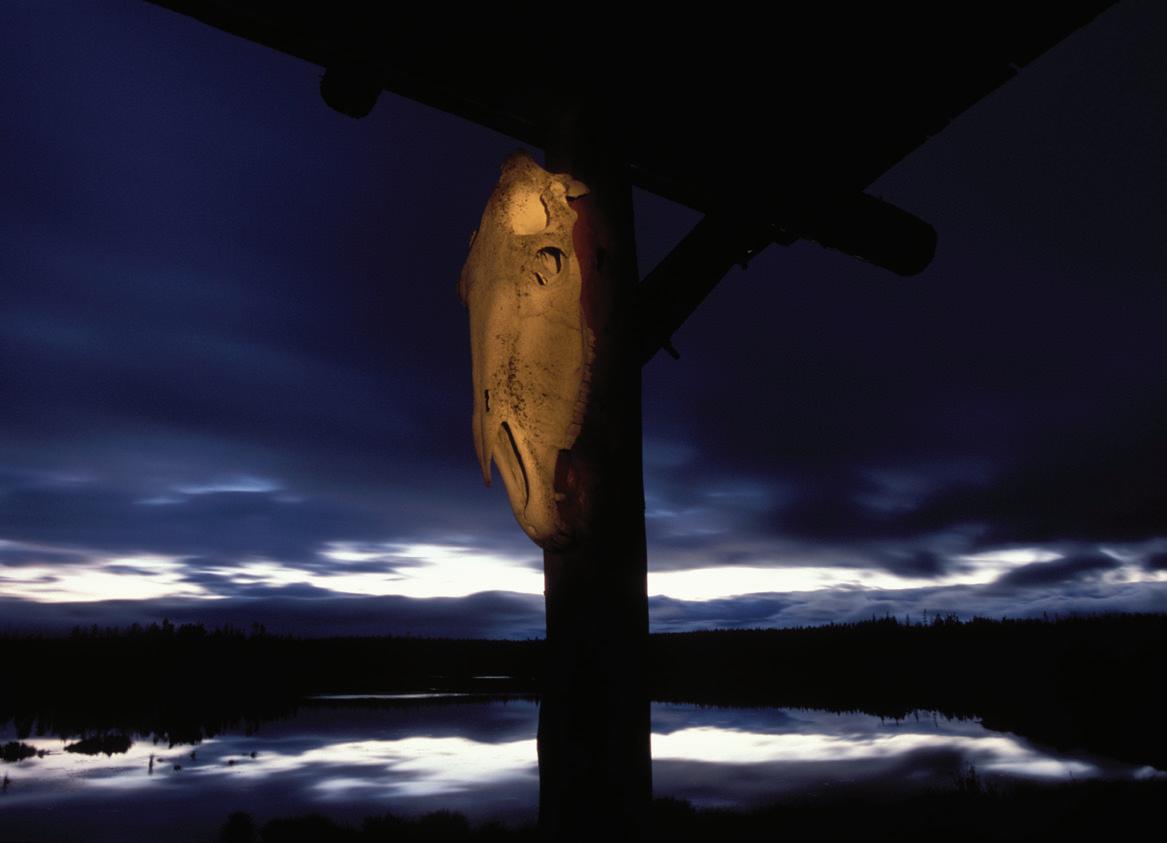
& The Wicked
appearance down in the valley of a small band of silver-dun wild grullas for half a day, no horses from the Plateau ever bothered to recolonize the Elkin Creek Valley. Maybe, I wondered, if like elephants, they stored deep memories in their DNA that recall their dead ancestors. That was my best guess.
I was also to learn in my research that B.C.’s Range Wars and the wild horse eradication narrative is very controversial. The story has
been told endlessly around campfires and in Cattlemen Association boardrooms, and in the oral history and storytelling of the Interior Region First Nations since the passing of B.C.’s Act for the Eradication of Wild Horses in 1896. It’s a history full of conflict, controversy, cruelty, and blatant misclaims — as well as the scapegoating of the wild horse to conceal major historical range degradation across B.C. caused by cattle overpopulation.
It’s a dark chapter in our colonial grassland history that still refuses to close, as new science reveals that the wild horses are not recent “alien” species that escaped from stock brought in by early gold miners and settlers, as previously claimed. Rather, the horses were actually introduced by First Nations in the first half of the 1600s, making them a returned native species that evolved in North America over the last 50 million years as a critical grazer in
our ancient grassland ecosystems.
Ancient Tails
In the Ktunaxa homeland, or ʔamakʔis Ktunaxa, all wild horses appear to have been eradicated by the 1960s or early 1970s; no one seems to know for sure. According to ʔakisqnuk First Nation Elder Alfred Joseph, “There are two histories in the Columbia Valley: the written and the unwritten.”
Joseph tells me that the
Ktunaxa name for the horse is kqaǂǂaxaʔǂ¢in, meaning “elk dog.” Before the horse, the Ktunaxa used dogs for packing. Ktunaxa oral history explains that their communities first acquired horses in the 1700s, if not before, from the Shoshone peoples to the south. In the past, the best wild horses captured for domestic use came out of the Findlay Creek area. One of the last wild horses to survive the century-long bounty hunts was captured
The tRENCH | Spring Summer 2024 49

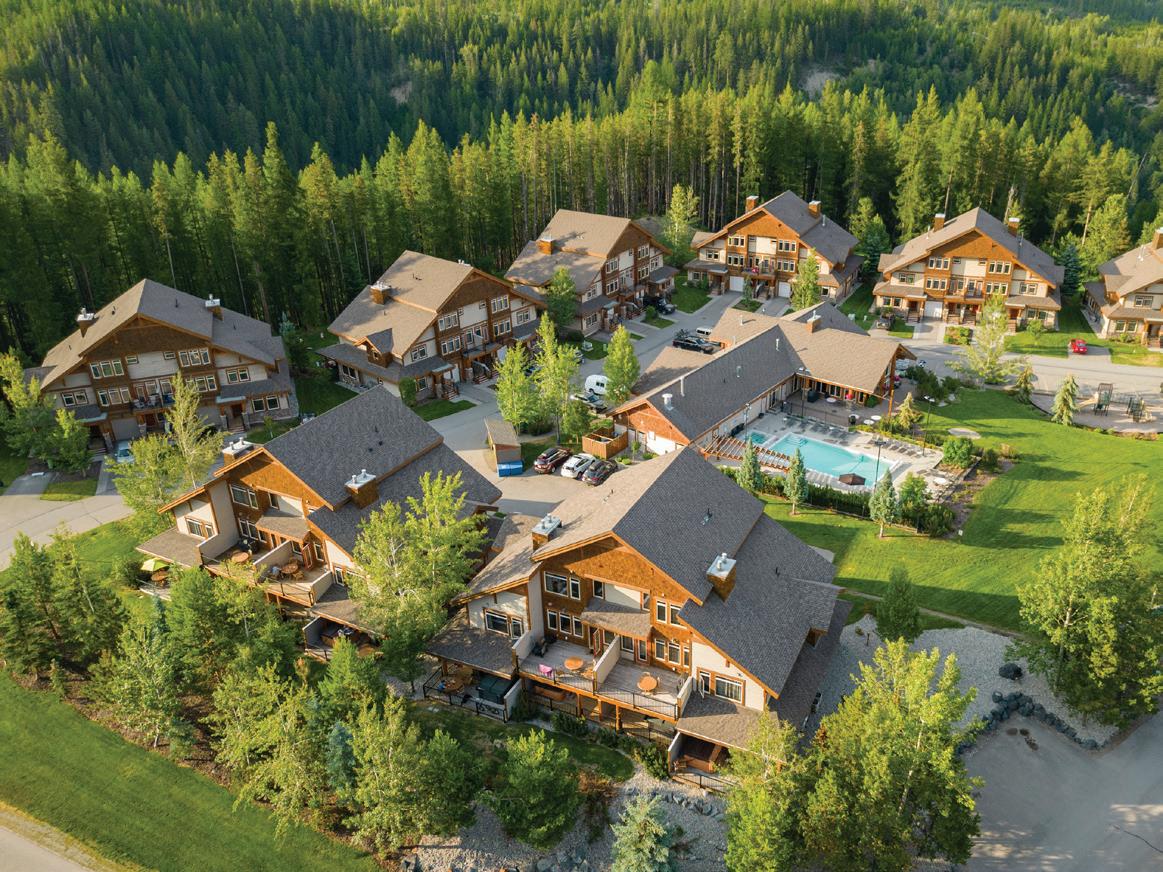
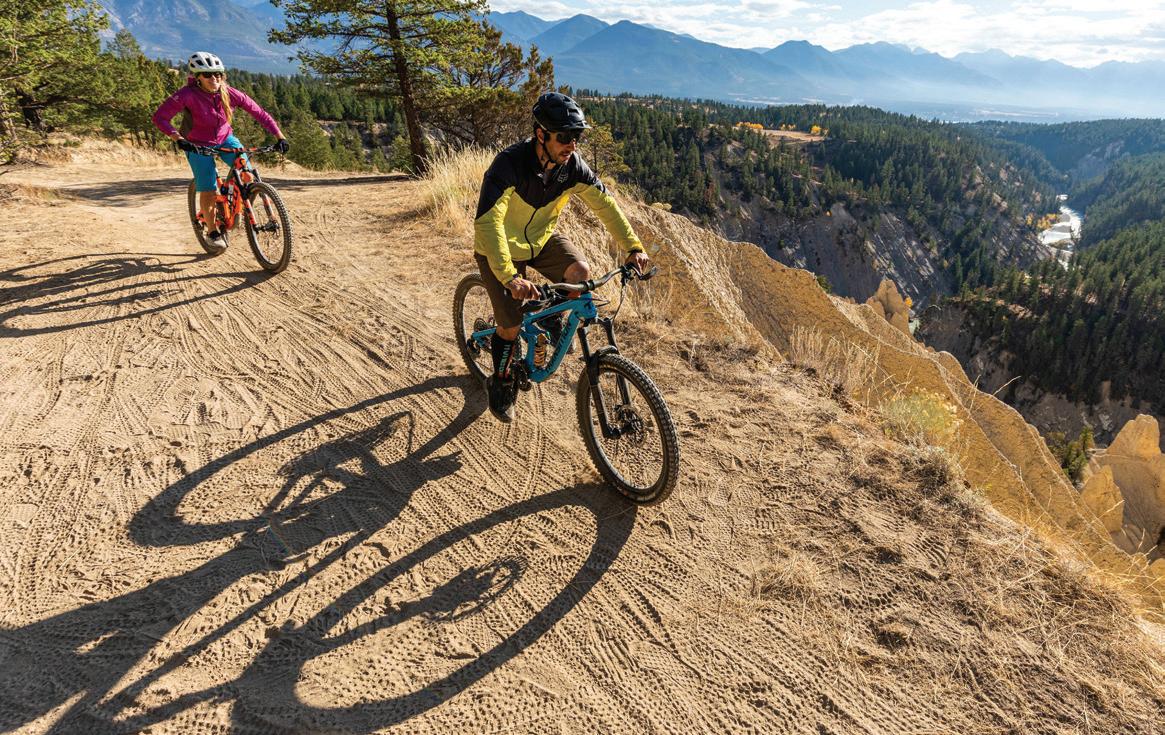
FIND MORE IN THE COLUMBIA VALLEY TravelColumbiaValley.com Find everything from warm water lakes, endless trails, guided adventures, local farmers markets, tasty restaurants, pristine golf courses, and so much more within the welcoming communities of the Columbia Valley. There is so much to discover, no matter the season. RADIUM HOT SPRINGS • INVERMERE • PANORAMA • FAIRMONT HOT SPRINGS 778-481-8181 reservations@thenorthstargroup.ca

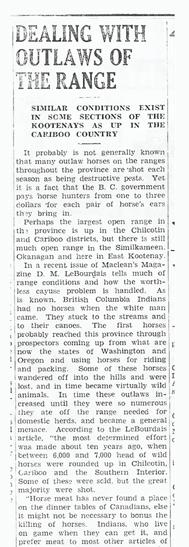

“…any horses found on the Crown ranges may be rounded up and disposed of or shot under the provisions of the said ‘Grazing Act’…” — Cranbrook Courier, January 1961
from this area in the 1970s.
A recent multidisciplinary study, The Spread of the Horse Across the Americas — by a group of scientists, myself included, and Indigenous Knowledge Keepers and scholars, including Tsilhqot’in
with growing evidence, that some First Peoples had a relationship with late Pleistocene horses.
Even the land on which the City of Cranbrook now stands has its own history with kqaǂǂaxaʔǂ¢in, or the horse. In 1841, HBC George Simpson travelled near what is today’s Cran-
argument to dispossess Isadore of his ranch land: “You have hundreds of horses running wild, and they are increasing in number. They only tend to destroy the ranges and are of little value to you. You cannot expect the government to give you more land to raise useless horses.”
New science reveals that the wild horses are not recent alien species that escaped from stock brought in by early settlers, as previously claimed.
“In time, these outlaws increased until they were so numerous they ate off the range needed for domestic herds and became a general menace.” — Cranbrook Courier, December, 1939
Knowledge Keeper Alice Williams — confirms the Ktunaxa oral history as told by Joseph. The study found that Spanish horses, first introduced to Mexico by the conquistadores in the early 1500s, were spread across the Americas from one Indigenous tribe to another via their vast web of trade networks, reaching the northern Rockies in the early to mid 1600s.
After the last Ice Age ended, the late Pleistocene Yukon Horse — Equus caballus, the same horse species we see today — hung on for another 5,000 years before winking out in North America. Thanks to the Bering Land Bridge that once linked today’s Alaska and Siberia, the horse was able to cross over and continue to survive in Europe and Asia, where it was domesticated. However, on this side of the pond, some Indigenous creation stories of the horse reach back deep into time — well before the arrival of the first Europeans — suggesting,
brook and observed that the Ktunaxa had about “two hundred fine horses,” according to C. Graham’s 1947 Fur and Gold in the Kootenays. By the late 1800s, settler prejudices against Ktunaxa-kept wild horses had grown, handin-hand with the terrible colonial mistreatment and persecution of First Nations over land ownership and alienation.
In the Cranbrook area, this came into play in 1886 and 1887 during Indian Reserve negotiations between the Ktunaxa and the provincial government commissioners charged with implementing the 1870 B.C. Land Ordinance. This allowed only white settlers to preempt Crown-claimed land that was not already an Indian Reserve or did not contain so-called “Indian Improvements.”
One such negotiation issue involved Akisq'aq'li'it, or Joseph’s Prairie, the site of present day Cranbrook, which at that time was a successful Ktunaxa ranch developed by Chief Isadore — conflicting with new settler interests in railroad development. The commissioners wielded negative comments about the Ktunaxa’s wild horses in their
Tragedy On The Grassland
Although the B.C. government’s bounty hunt on wild horses officially began in 1924, in the East Kootenay, wild horse roundups by cattle ranchers would have started in ʔamakʔis Ktunaxa as early as the 1896 Act for the Eradication of Wild Horses, if not before. A 1939 article in the Cranbrook Courier headlined “Dealing with the Outlaws of the Range” falsely claimed that “British Columbia Indians had no horses when the white man came. They stuck to the streams in their canoes. The first horses probably reached this province through prospectors coming up from what are now the states of Washington and Oregon.”
The article went on to state that escaped horses became “outlaws” that “increased until they were so numerous they ate off the range needed for domestic herds,” and that about a decade prior, some 6,000 to 7,000 wild horses were mostly shot in the province. “A horse roundup is now planned for the Cranbrook Grazing District and others will follow,” the article claimed.
In 1939, the Waldo
Cranbrook Courier, November 1945
The tRENCH | Spring Summer 2024 51
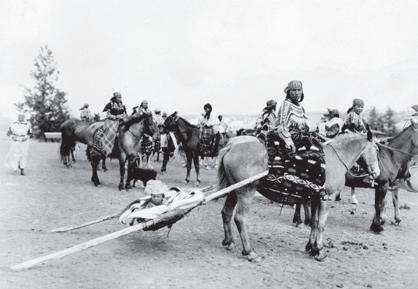
Among other First Nations throughout the northern Rockies, the Ktunaxa had horses as early as the 1700s. This Ktunaxa photo is from the early 1900s. Spanish horses, first introduced to Mexico by the conquistadores in the early 1500s, were spread across the Americas from one Indigenous tribe to another through their vast trade networks. — B.C. Archives Photo
Stockbreeders Association was formed out of a concern for wild horse sleeping sickness, or Encephalitis, and with the aim to clear the range of “useless horses.” Horses were either shipped out or shot on the range, where a bounty of $2.50 could be collected by bringing in the scalp with ears, and for a stallion, $5.00 if one also brought in the testicles.
Dr. John Thistle’s groundbreaking study Range Wars: Ranching and Pest Eradication on British Columbia’s Interior Plateau, asserts that by 1919 “state enclosure of the open range, and ridding the range of wild horses, became a powerful imperative for ranchers and provincial range managers alike.” He notes that by 1922, B.C.’s first grazing

some sources claim 2,000 wild horses were removed from the region in the two decades following WWII.
about 4,000 to 5,000 wild horses left in all of Canada.
commissioner finally admitted that a great deal of the destruction of the rangelands was caused by the stockmen.
The renowned grassland specialist, Dr. Bert Brink — who supported the formation of wild horse preserves, and was my own UBC ecology instructor — lamented the dismal state of the interior of B.C. grassland ranges caused by too many cattle: “You can’t imagine what some of these ranges were like by the 1920s… much dust; dark, black dust.”
What Could Have
Been Records kept by the Provincial Grazing Branch indicate that at least 13,420 wild horses were removed from provincial rangelands between 1924 and 1955. It’s not known how many of these were killed off in the East Kootenay, but
Did eradication of wild horses make much difference to the dismal state of the range? Not much. Comprehensive studies of vegetation and forage in the Rocky Mountain Trench in the 1990s found that the combined cattle and wildlife use exceeded the grassland carrying capacity, resulting in ongoing degradation. In 2008, a Forest Practices Board investigation found the same problem, with marginal improvement. In other words, killing off all the wild horses that the Ktunaxa introduced four centuries ago did not make much, if any, impact on the decline of the range.
Dr. Thistle claims that there was a much better way to deal with what ranchers perceived as pests, including wild horses. “There was nothing inevitable about the decisions early British Columbians made,” he says. “They might have restored the range, rather than simply put poison on it. They might have reclaimed wild horses, rather than simply annihilate them. They might have listened more to what First Nations peoples were saying, rather than simply dismiss and blame them for not valuing property, and they might have looked closer at their own land use practices rather than demonizing those of others.”
Today, there are only
B.C. has about 250 in the Highland Valley, as well as some remnant feral herds on First Nations reserves elsewhere, and there are 2,800 in the West Chilcotin that are protected in North America’s largest wild horse preserve declared by the Tsilhqot’in-Xeni Gwet’in Nation.
Much of B.C.’s once-pristine grasslands — virtually emptied of the wild horse, grizzly, and wolf in order to make room, in just a short wink of the earth’s history, for the domain of the alien cow — is now a barren landscape. No longer does the wild horse run across sunlit plains with the ghosts of its Pleistocene ancestors; no longer do thundering hooves echo off canyon walls as a wild herd blazes through the moonlight. Something essential, nearly indefinable, is missing from these expansive landscapes.
For those, such as myself, who have carefully studied the ecology, genetics, origins, and relationships of B.C.’s wild horses for decades, it’s clear that the wild horse is a valuable returned native species. Our last wild horses need to be recognized and protected as a heritage and keystone species, vital to many of the continent’s cultures and to the ancient grassland ecosystems they evolved in, and as a reminder of the wild spirit that exists in all beings.
In early 2024, Wayne McCrory’s book, The Wild Horses of the Chilcotin: Their History and Future (Harbour Publishing) won the Basil Stuart-Stubbs award. The prize is given by UBC Library and the Pacific BookWorld News Society, awarded annually to the best scholarly book on a British Columbia subject by a Canadian author. The book is available in bookstores or from www.harbourpublishing.com.
Patrice Halley: From Paris to Wycliffe and back

A photographer, filmmaker, and world-travelled media expert originally from Paris, France, Patrice Halley called the hills of Wycliffe home for a number of years.
Earlier this year, Halley sent along some sentiments via email while sharing photos from his assignment for British Columbia Magazine’s summer 2004 cover story on the wild horses of the Chilcotin.
“The wild horses story was one of the greatest experiences I had while residing in British Columbia,” Halley writes, “and a highlight in my career.”
And what a career it’s been. The never-say-die lensman has worked for the likes of National Geographic, CBC’s The Nature of Things and BBC’s The Human Planet, with the famous voice of Sir David Attenborough commenting over top his images. While his career has dispatched him around the planet, his memories of the Rockies’ easternmost edge, right out his former front window, is a view he’s never forgotten.
“I should never have left the province that is still home,” he lightly laments, “forever in my heart.”
52 Spring Summer 2024 | The tRENCH



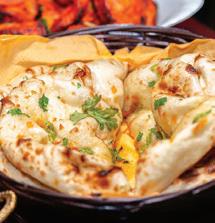


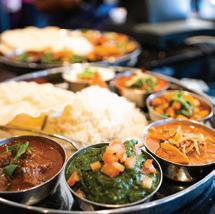
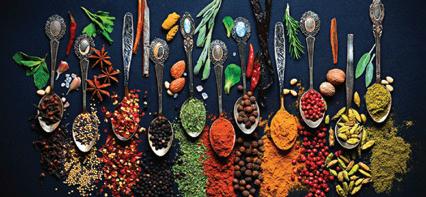

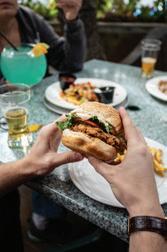

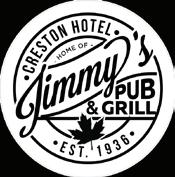
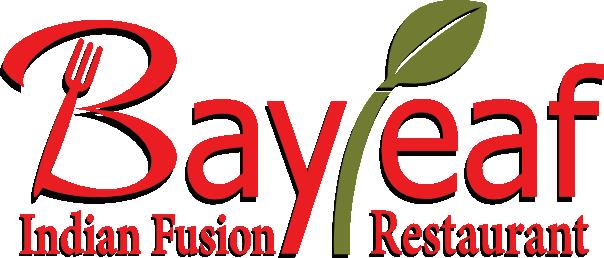
DELUXE SUITES "Discover comfort and charm at our hotel & pub. Enjoy luxury rooms, delicious dishes, and lively atmosphere. Book now for an unforgettable experience!" CONTACT US (250) 428-2225 Crestonhotel com 1418 Canyon Street, Creston BC FERNIE 201 Fairway Dr, Fernie | 250-423-4115 cranbrook 600 Cranbrook St N, Cranbrook | 778-517-5060 CRESTON 1403b Cany on St, Creston | 250-428-7713 bayleafindianfusion.com
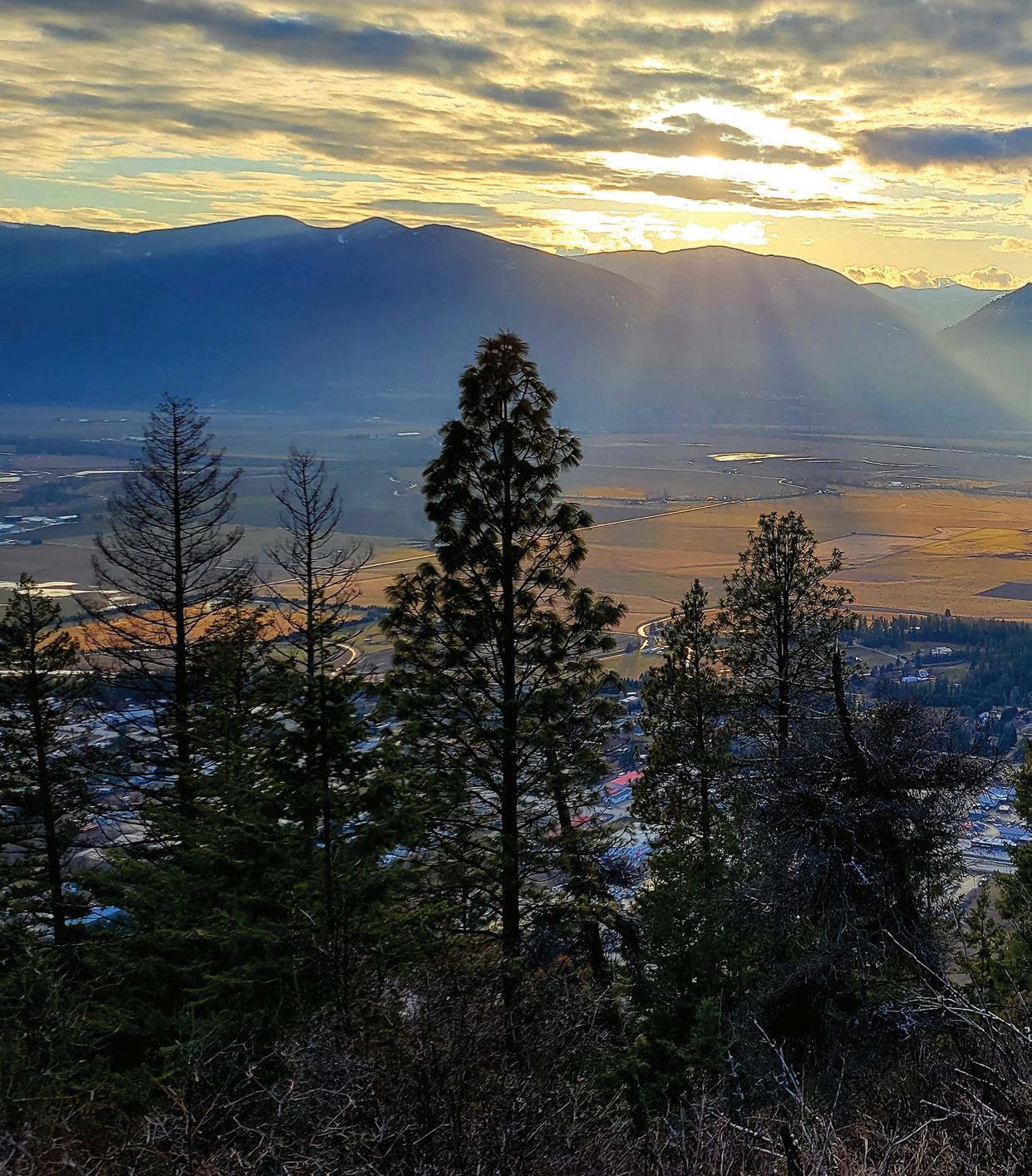
Of Harvest and High Country
Creston celebrates a century
W: Brian Lawrence
54 Spring Summer 2024 | THE TRENCH
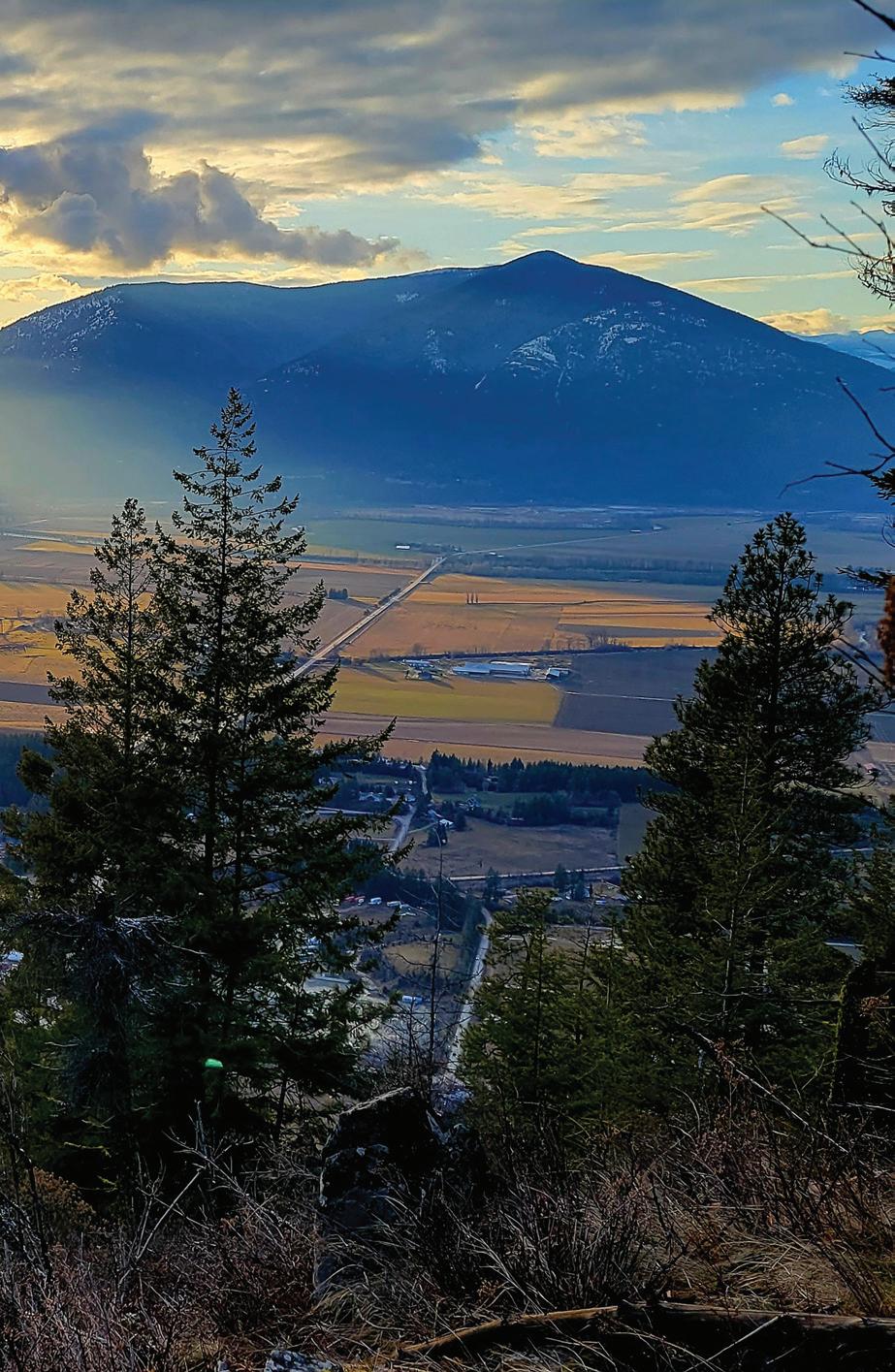
Creston is well known for its downtown grain elevators — landmarks that attest to its strong agricultural heritage — and its fertile valley nestled between the East and West Kootenays. But they are just the beginning of what makes this place special.
“You can tick them all off: the location, climate, proximity to the U.S. border, the lake, farming,” says Ron Toyota, who served as mayor of Creston from 2008 to 2022. “But it all comes down to the people.”
Those people are the cultivators of farm-fresh fruits, meats, and veggies; the creators of a vibrant performing and visual arts scene; and the proprietors of trendy restaurants and boutique shops — all of which bring a unique spark to life in the community.
“Creston’s just a terrific place,” smiles Toyota.
This year marks a milestone 100 years since the town’s incorporation. Read on to learn about the festivities and history — and to even meet a few Creston celebrities.
The tRENCH | Spring Summer 2024 55
Trevor Marzke Photo

EVENTS
From a collaborative community art installation to a film detailing the rich Indigenous history of the area, inclusion is at the heart of events as the Town of Creston honours 100 years since its incorporation. Centennial celebrations kick off the week leading up to May long weekend.
Tuesday, May 14 sees the debut of a short film produced by Chris Luke Sr., an author, Ktunaxa Elder, and former elected Chief of the Yaqan Nuʔkiy (or Lower Kootenay Band). Running at a variety of centennial events throughout the week, the film shares a Ktunaxa perspective and guidance about how we can move forward with a spirit of partnership and reconciliation.
Later that evening, the sky will be illuminated by a drone-powered light and music show presenting a dazzling display of Creston Valley imagery, such as the downtown grain elevators. Topping off the night will be a centennial cake created by Loïc Fauteux-Goulet, a local high school teacher and the winner of Season 7 of CBC’s The Great Canadian Baking Show
VALLEY VOCALS — Contestants take the Kootenay River Theatre stage at the second annual Reach for the Mic, a singing contest hosted each fall by the Creston Valley Arts Council.
Lynne Karey-McKenna
Photo
CELEBRITY
You never know where Creston faces are going to pop up, and here are a few that have recently graced the small screen — and a really big one!
Loïc Fauteux-Goulet

Need a baking boost? Giving Loïc Fauteux-Goulet a follow on Instagram (@loicbakes) might do the trick. The Kootenay River Secondary School Foods and French teacher is truly an expert, having won Season 7 of CBC’s The Great Canadian Baking Show in 2023.
“That’s kind of fun — bringing in some local heroes,” enthuses City Councillor Denise Dumas.
To ensure that the celebrations represent the entire community, the town’s events advisory committee is partnering with other organizations to offer centennial events.
From May 17 to 20, the Creston Valley Blossom Festival hosts the Shooting Star Amusements’ midway carnival at Millennium Park, for a delightful dose of childhood nostalgia.
On Friday, May 17, the Blossom Festival’s Opening Ceremonies features a concert of local musicians covering 100 years of music at the Kootenay River Theatre. And the music doesn’t end there: on Saturday, May 18, the popular Nelson-based AC/DC cover band, BC/DC, will rock the Creston & District Community Complex.
John Bucyk
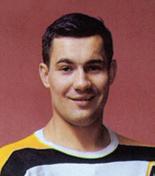
NHL left-winger John Bucyk married into the Creston community, often spending summers on Kootenay Lake. He played with the Boston Bruins from 1957-1978, and lent significant support to fundraising after Creston’s Civic Centre burned down in 1968. The Creston and District Community Complex’s arena is named for Buyck — who still works with the Bruins at the age of 88!
Remington Louie

A member of the Yaqan Nuʔkiy, or Lower Kootenay Band, Remington Louie starred in the short film REZilience, billed as Canada's first Indigenous zombie movie. He’s since starred in the crime drama Road of Iniquity, and had a recurring role on CTV Comedy Central’s Acting Good
Pascale Hutton
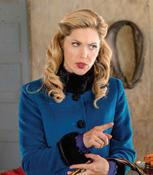
Currently starring in Hallmark’s When Calls the Heart, Pascale Hutton is no stranger to the small screen; she starred in all three seasons of the CBC drama series Arctic Air. She’s played a number of supporting roles too, including on TV series’ Rookie Blue and Smallville, and in films like A Simple Curve, filmed in the West Kootenay.
56 Spring Summer 2024 | THE TRENCH
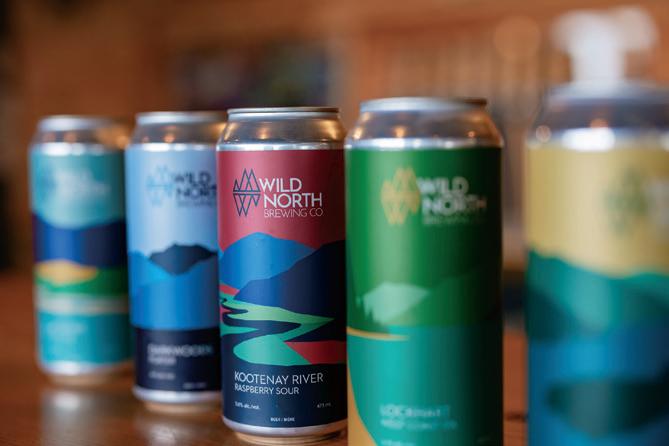
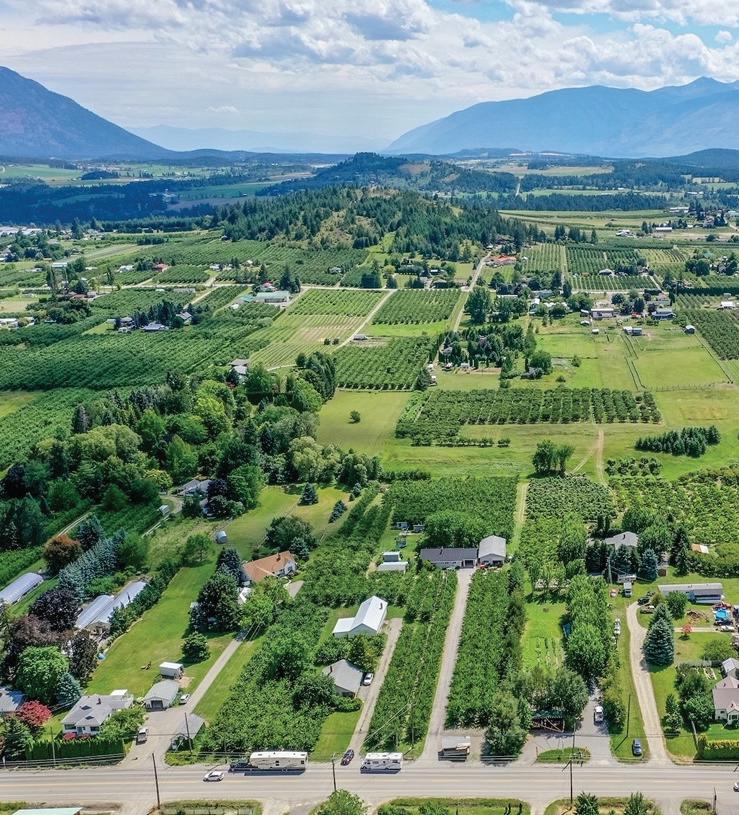
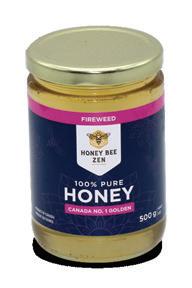



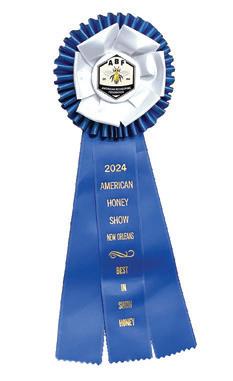
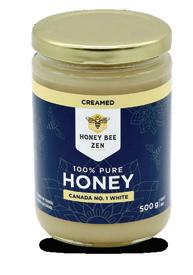
Where friendship, adventure and great beer collide! HONEY TASTINGS AT OUR FARM GATE HONEY SHOP 220 Placsko Road E., Creston honeybeezen.com | 250.866.6861 100% Pure Kooten Their creamed honey was the best I've ever judged and tasted. It received a perfect score of 100. – Rick Sutton, American Honey Show judge 100% Local. 100% Pure. WINNER! BEST IN NORTH AMERICA 2024 Locally Owned & Operated. We’re your Creston Valley real estate experts! Veitch Realty - Creston 1131 Canyon Street, Creston 250.428.9331 c21creston.com | sales@c21creston.com

“It’s about the people who have been here and built things,”
she says.
“I love that we can honour those who have gone before us and made Creston such a wonderful place to live.”
Calling all hockey fans: The Creston Valley Minor Hockey Association will unveil a 100 Years of Ice Sports legacy display at the John Bucyk Arena on Friday, May 17.
Other events that week include the launch of a community art project by Cresteramics — in which community members can paint wooden bird silhouettes that will become part of a colourful downtown art installation — as well as a historic scavenger hunt on Saturday, May 18, hosted by the Creston Valley Youth Network.
It doesn’t end in May: Centennial events will continue throughout the year. In June, Footlighters Theatre Society presents a play by Jason Smith and Suzanne Chubb. Rather than a reenactment of actual history, the plot follows the adven-
tures of a group of youths in 1924 Creston — think The Little Rascals meets Laurel and Hardy.
Throughout 2024, the Creston Valley Public Library will present a series of historical lectures, and in the fall, the Creston Lions Club will host a community meal tying their 85th anniversary in with the centennial.
Dumas, whose family has been involved in municipal politics and local events for decades, says she is impressed by the spirit shown by community members.
“It’s about the people who have been here and built things,” she says. “I love that we can honour those who have gone before us and made Creston such a wonderful place to live.”
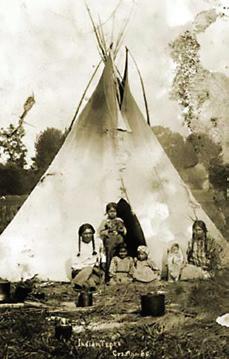
1808
The travels of cartographer and Northwest Fur Company trader David Thompson bring him to the southern end of Kootenay Lake where he establishes trade with the Yaqan Nuʔkiy people and produces the first maps of the region.
Vic Mawson opens Mawson’s Sports, the oldest business in the Creston Valley still running today. The Creston Valley Rod & Gun Club later names the lake at the Rykerts border crossing after Mawson.
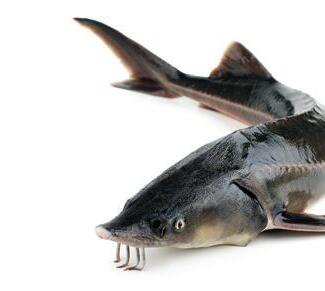
1924 Creston is incorporated as a village in May, and Governor General Lord Byng visits in August to present the official village charter.

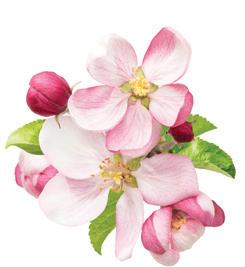
1942
The Creston Lions Club hosts the first Creston Valley Blossom Festival as a fundraiser and morale booster for the Second World War, creating one of Creston’s most enduring annual events (next to the Creston Valley Fall Fair, started in 1918).
start
58 Spring Summer 2024 | The tRENCH
Emma Penner Photo
Creating Creston
From festivals to farmers’ markets, power plants to powwows, and the arrival (and departure) of industries, the last two centuries have seen spirited expansion in this verdant valley.
1893

Father Nicolas Coccola founds a Catholic mission among the Yaqan Nu kiy people, which leads to the construction of St. Peter’s Church, the first church in the Creston Valley. In 2017, Yaqan Nu kiy members vote to dismantle the church. The site is now the location of the Wilfred Jacobs Building, which opened in 2022: a 13,365 square-foot facility housing Yaqan Nuʔkiy administration and health staff, shaped like the traditional yaqsuʔmiǂ, or sturgeon-nosed canoe.

1925
1914
Over 200 young men from the Creston Valley enlist when the First World War breaks out. Twenty-five years later, more than 1,000 enlist when Canada joins the Second World War.
On October 20, John Ward and an unidentified accomplice hold the Imperial Bank at 1018 Canyon St. at gunpoint. No one is hit by the 14 shots exchanged by the manager and robbers, who escape through a side window with the bank’s cash. Following a shootout through downtown, the robbers split up

1908
A public auction by the provincial government offers several thousand acres of farmland for sale, launching a “fruit boom” in the valley.
1930
The central part of Creston begins receiving electricity through an electrical power plant built at 10th Avenue North. Electrical coverage expands to much of Creston, Erickson, and Canyon when the West Kootenay Power dam is built on the Goat River in 1933. It takes until 1964 for electricity to finally reach West Creston.
1907
1899
The name Creston is adopted and the first plan of the townsite
The “light” aspect is still years away, but the Creston Power, Light, and Telephone Company begins operations with the first phone lines installed to the Alice Mine north of town.


1935
The first of Creston’s iconic grain elevators — the white one — is built by Midland and Pacific to hold the first major crop of grains coming off the newly-reclaimed flats. The Alberta Wheat Pool elevator — the red one — is built the following year. Both eventually fall into disuse and in 2018, Columbia Basin Trust purchased the grain elevators with the goal of preserving the landmarks. Restoration of the red elevator was completed in 2023.
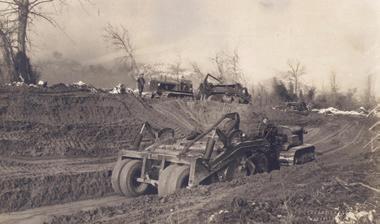
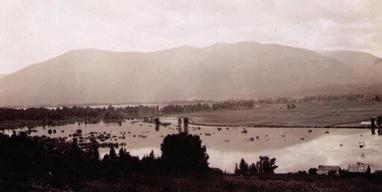
1935
After numerous attempts (including William Adolph Baillie-Grohman’s 1880s effort to divert the Kootenay River at Canal Flats), the flats west of Creston are “reclaimed” by diking the Kootenay River, allowing reliable grain farming for the first time — although floods in 1938 and 1948 wreak havoc on crops and livelihoods. The grain industry eventually withers after 1943, when the federal government began requiring wheat, oats, and barley to be sold through the Canadian Wheat Board grain elevators at far higher quotas than farmers could produce.
The tRENCH | Spring Summer 2024 59


1966
1959
The Columbia Brewery (then Interior Breweries) begins operation, most famous for its Kokanee brand. Labatt (now owned by Anheuser-Busch InBev) buys the company in 1974, and eventually expands the facility’s production to include Alexander Keith’s and Budweiser.
Creston’s population is 2,920, up from 2,460 in 1961, allowing it to be incorporated as a town. By the 2021 census, the town’s population has reached 5,583.
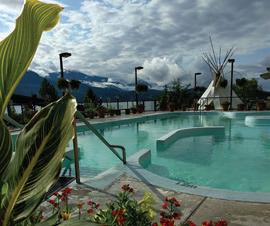
2015
Lower Kootenay Band purchases
Ainsworth Hot Springs, putting the business in the hands of the people who traditionally enjoyed the nupika wu’u (Ktunaxa for ‘spirit water’) for centuries.
2016 Wynnwood, the sawmill that started as Wynndel Box and Lumber in 1913, is sold to Canfor, ending its reign as the Creston Valley’s longest-running family-owned business.
1947
To meet new standards for B.C.’s Southern Trans-Provincial Highway (mostly now Highway 3), which passes through downtown Creston, Canyon Street abolishes angle parking — and gets widened by 20 feet. Some building owners move their buildings back 10 feet, while others simply chop 10 feet off the front.
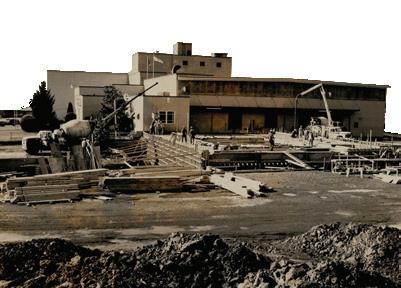
1968
Indoor winter sports are disrupted for a few years when the Civic Centre burns down. Through a massive fundraising effort, the facility is rebuilt and reopens in 1971. Following a 2006 referendum, the centre, now the Creston and District Community Complex, receives a $25 million-plus upgrade with a grand reopening in 2010.
1947
The 155 babies born this year in the Creston Valley are Canadian citizens, not British subjects, after the passing of the Canadian Citizenship Act.
1957
Parking meters are installed downtown. They require plugging until 2013, when Town Council approves free two-hour parking indefinitely.

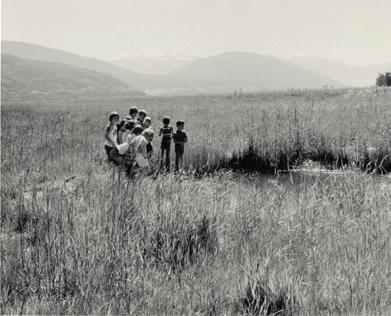
2004
After a low-profile start in Erickson in 2003, the Creston Valley Farmers’ Market expands and moves downtown — and keeps growing! Today, about 50 vendors offer their wares and bounty each week, and hundreds of weekly visitors spend about $1.72 million annually.



2017

Red Bird Estate Winery produces its first vintage, becoming the region’s fourth winery — after Skimmerhorn Winery and Vineyard, Baillie-Grohman Estate Winery, and Wynnwood Cellars Estate Winery — to take advantage of the valley’s ideal climate for growing grapes.
1991
The Lower Kootenay Band holds the first Yaqan Nuʔkiy Powwow, now an
May long weekend with attending, and dancers
In a move supporting reconciliation, Prince Charles Secondary School is renamed Kootenay River Secondary School. Members of the Lower Kootenay Band join students and staff for the official announcement.
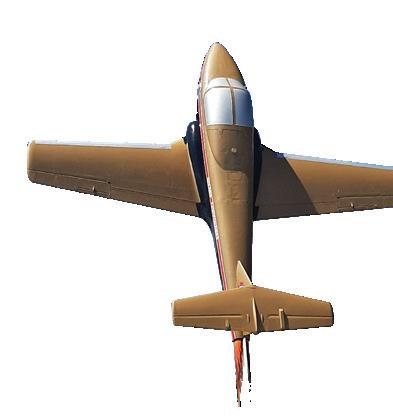
60 Spring Summer 2024 | The tRENCH

1948
Alex O. Carruthers publishes the first edition of the Creston Valley Advert, which later becomes the Creston Valley Advance. It outlasts its major competition, the Creston Review (1908-1983).
1952
Fifty-five per cent of B.C. voters choose to adopt Daylight Saving Time, but the Creston Valley opts out, creating a mini time zone that is perpetually confusing to outsiders. (Hint: Creston is the same time as Cranbrook in the winter and Nelson in the summer.)
1968

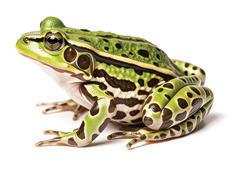
The Creston Valley Wildlife Act establishes the Creston Valley Wildlife Management Area, 7,000 hectares of land stretching from the southern tip of Kootenay Lake to the U.S. border. Home to about 300 birds, 60 mammals, 17 fish, and 6 reptile and 6 amphibian species, the CVWMA has B.C.’s only known breeding population of Forster’s terns, and one of two known breeding populations of the northern leopard frog in the province.
1980
The high school, then named Prince Charles Secondary School, burns down. Plans for a smaller replacement include a multipurpose room, which a group of visionary residents thought could be put to better use as a fully functioning theatre. The Ministry of Education allows the Creston Community Auditorium Society to raise $120,000 to meet their goal and the venue, now Kootenay River Theatre, opens in 1987.

A CT-114 Tutor jet is installed near Millennium Park in a ceremony that featured a flyover by the Canadian Forces Snowbirds. Painted in the colours of the 1967 Golden Centennaires, a Royal Canadian Air Force aerobatic flying team, the jet honours C.B. Lang, who
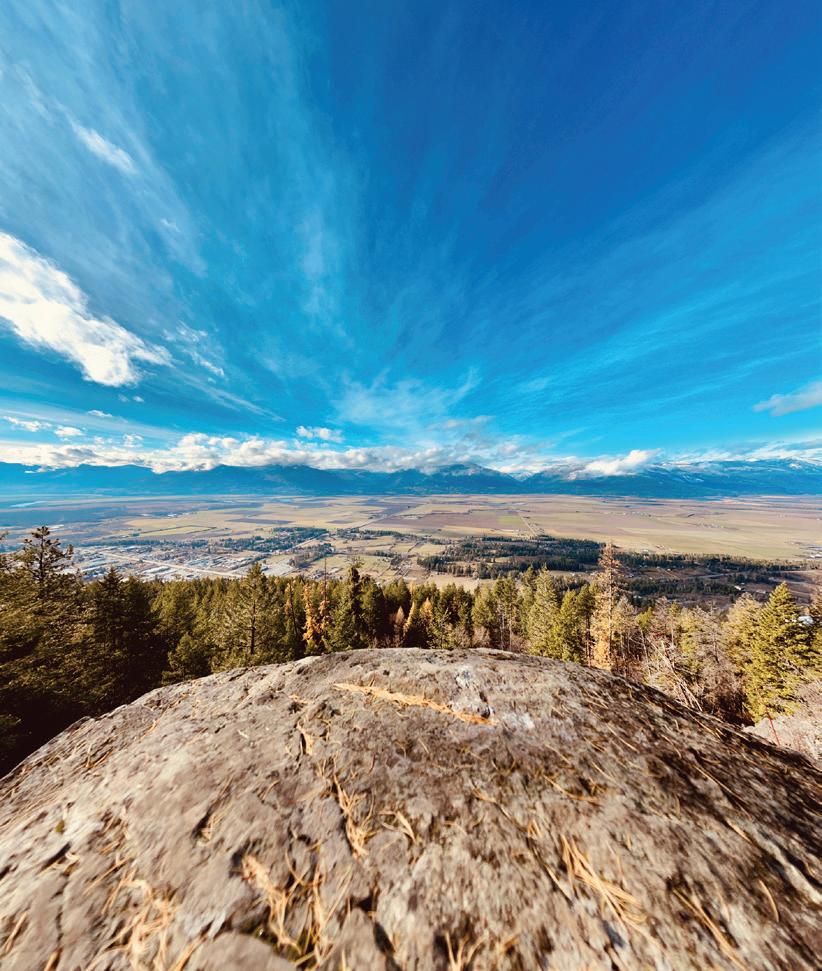
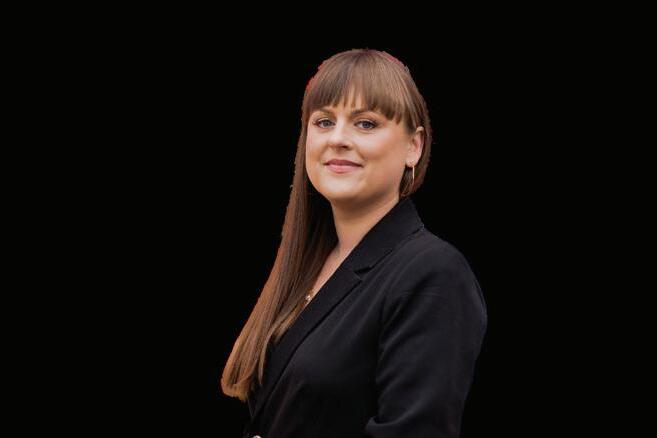
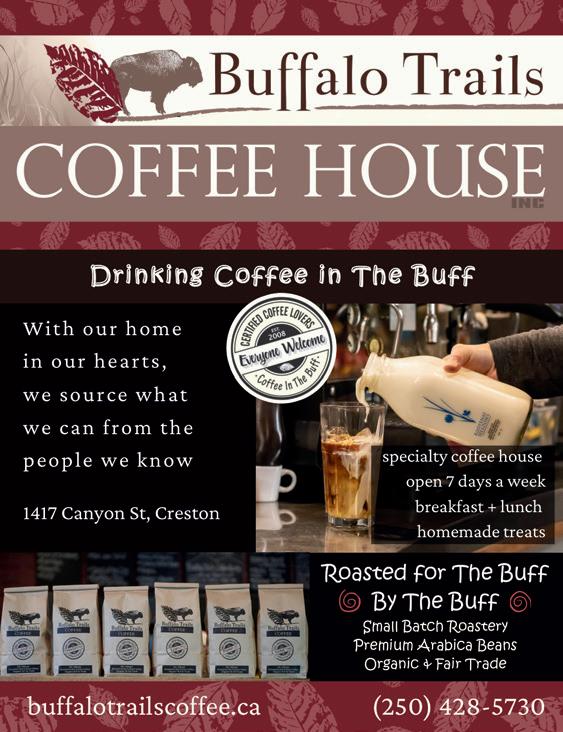
Celebrating Creston’s Centennial Brittny Anderson MLA for Nelson-Creston 250.354.5944 Brittny.Anderson.MLA@leg.bc.ca




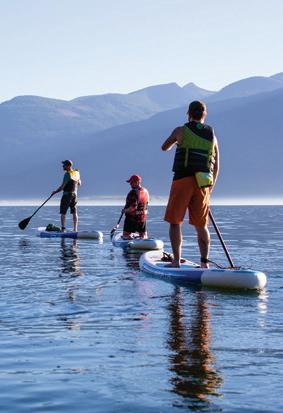
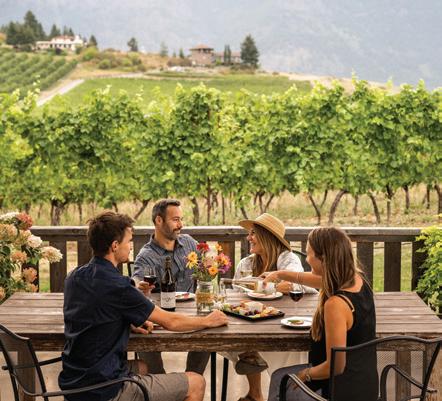
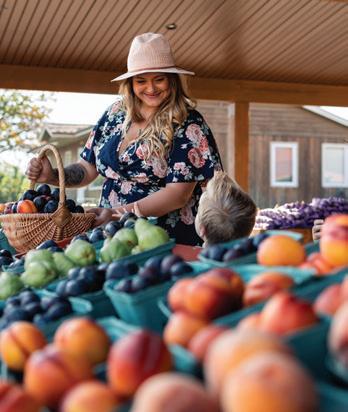


escape, unwind, indulge. Visit explorecrestonvalley.com or scan the QR code to start planning your trip Come, explore, and discover the charm of the Creston Valley, the hidden gem of the Kootenays. With its unique culture and art, friendly and welcoming locals, decadent food and wine, and epic recreation opportunities, Creston Valley has something for everyone. Nestled between the Selkirk and Purcell Mountains, Creston is 20 minutes from Kootenay Lake and just over an hour from Cranbrook. Come for the day or a week, we welcome you! Farmers’ Market • Wetland & Mountain Trails • Wineries & Fruit Stands • Local Artisans 18-Hole Golf Course • Entertainment & Activities • Shopping • Fresh Dining Experiences While in town be sure to pick up a Visitor’s Guide and Hiking Map for free!
INDUSTRY
After the fur trade peaked in the 1820s and then steadily declined in the following decades, mining, forestry, and agriculture flourished, becoming the key industries leading Creston’s growth.
Mining

The Minister of Mines’ 1894 annual report noted 71 mining claims in the area. One of the most significant — the Alice Mine just north of Creston — began producing in 1904, but struggled until its closure in 1919 due to the demand for metals and minerals in the First World War. The Bayonne Mine west of Creston began producing in 1903 and expanded in 1936, employing up to 100 men. It closed in 1938, with another quick run from 1940 to1942. Creston’s last gasp for mining came in 1949 when the tailings from the Alice Mine were sorted and shipped to the smelter in Trail.
Agriculture

The Creston Valley’s agricultural potential was seen early on and attempts to dike the Kootenay River flats were made as early as 1892. (It didn’t work until the mid-1930s, and even then not perfectly.) With the newly available land, small fruits were popular crops, and Wynndel announced itself as “the Strawberry Capital of the World” in 1912. After diking was more secure, farmers grew more grain, which later shifted to potatoes, alfalfa, and other crops by the 1970s. Once Montana’s Libby Dam became operational in 1975, the significantly lower risk of flooding allowed the establishment of dairy farms and homes on the flats.
Forestry

A sawmill was established in 1898 in what is now downtown Creston, where it remained until 1992 when the planer mill and veneer plant shut down. Ten years later, entrepreneur C.O. Rodgers pre-empted 8,000 acres of land and started a new sawmill, selling off the logged land to farmers. In 1913, Monrad Wigen started a box factory north of Creston, which became Wynndel Box and Lumber in 1924, and later Wynnwood in 2014; it sold to Canfor in 2016.
In 1958, J.H. Huscroft Ltd. permanently moved its portable mill to Erickson where the company still operates today.
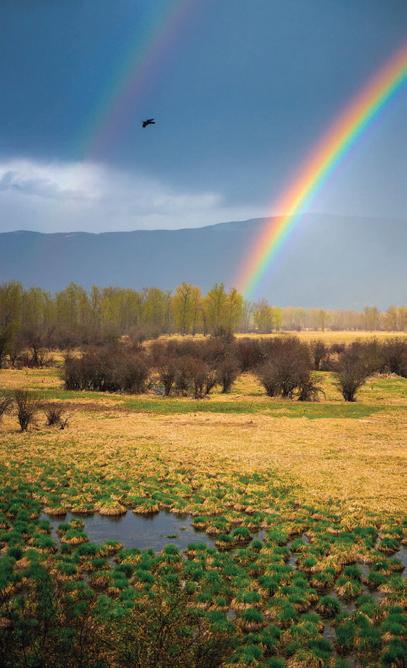
The future is bright
Its identity as an idyllic retirement community is well earned, but Creston’s population is becoming noticeably younger and wealthier: a visible change contrasting dollars and blue-collar roots.
“You might see a Mercedes right beside a Kubota,” says Scott Veitch, owner of Century 21 Veitch Realty.
Whether newcomers have excellent retirement planning or well-paying remote work, many are coming straight to the Creston Valley from the Lower Mainland. The town’s population grew from 4,826 in 2006 to 5,583 in 2021, as the average age dropped from 54 to 51.7.
Home prices have risen in recent years, from an average of about $260,000 in 2018 to $412,000 in 2023. Outside of town, farmland prices have also risen, from about $4,000 to $15,000 an acre in the last 10 years, with 20 acres in Lister fetching about $500,000.
The market is particularly busy not just with prospective home buyers, but also entrepreneurs looking to rent business space, further bolstering downtown’s thriving small business scene.
“People will come here not for big commercial development, but for the lifestyle,” says Veitch. “We’re this little oasis.”
Historical photos courtesy of Tammy Bradford at the Creston Museum. Family in front of teepee image courtesy of Royal BC Museum.
today The tRENCH | Spring Summer 2024 63
Photo: Ashley Voykin
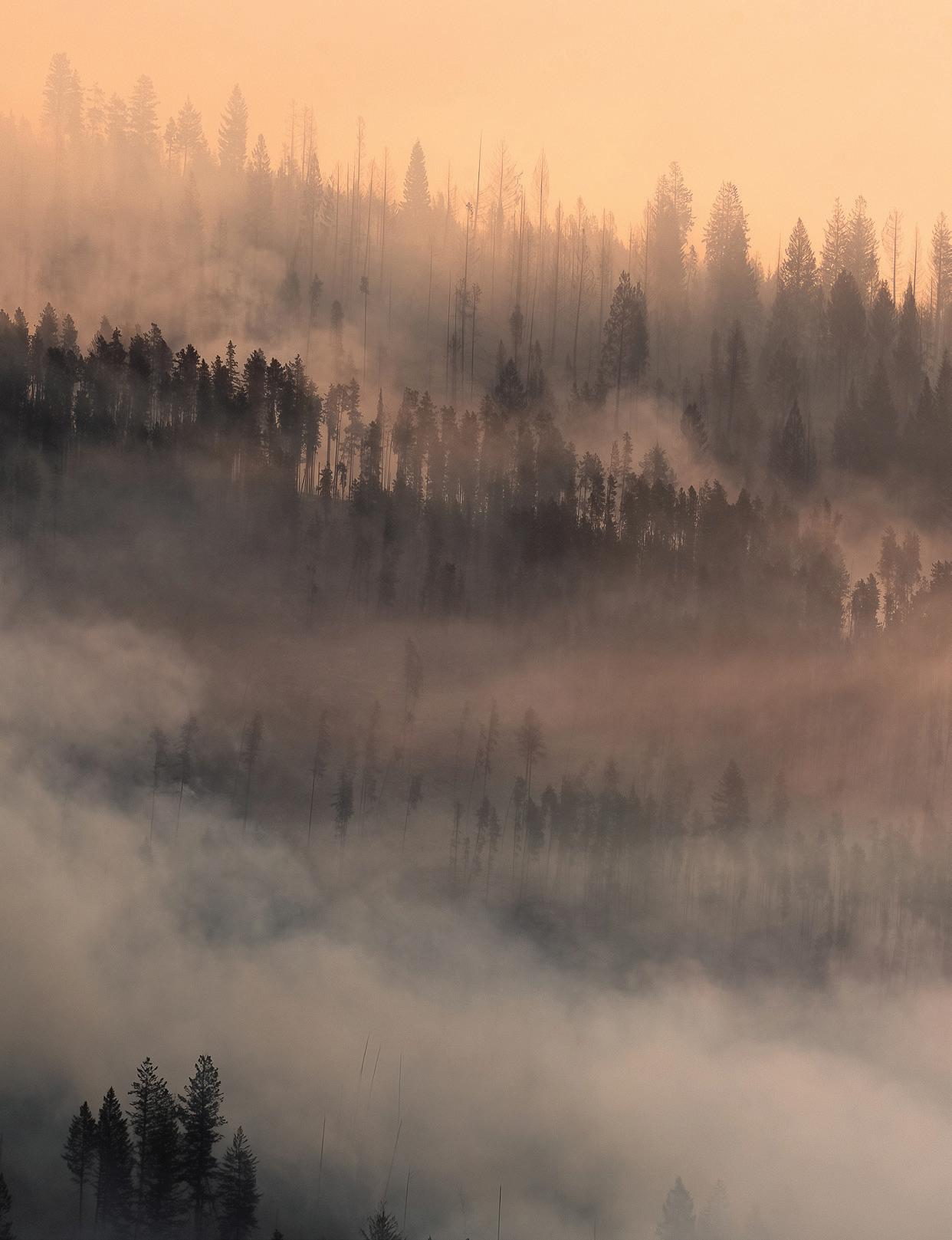
Warming Receptions
Water and snow. Local food and our forests. Little beasts and big questions. The signs of Columbia Valley climate change abound. Trench senior writer Dave Quinn and Kootenay climate scientist Mel Reasoner explain where we’re going from here.
grew up on tales of how things used to be, spoonfed anecdotes of a Kootenay past by my grandmother, Kay Sims. Kay was a storyteller who lived to 105, painting historical oral pictures of currently relevant events like the Spanish Flu burning through Cranbrook in 1919, a forgotten quarantine when white handkerchiefs hung on doorknobs to warn away visitors. She remembers the neighbour knocking on her window to sneak her some cookies when the flu tried, unsuccessfully, to carry her off.
She also told forgotten tales of giant salmon in the rivers near Invermere and of a Kootenay climate that are now both only memories. Tales of hitching a winter ride on the railway baggage car to Kuskanook to skate on frozen Kootenay Lake. Ski-drool stories of winters so deep that Townsite homes in Kimberley had tunnelled entrances though drifts, with boards for a roof, and of long seasons of bitter cold.
Even into the 1970s, we had ‘real’ winters. When Barb and Sep Renner arrived to take over Assiniboine Lodge at Christmas in 1983, a frigid -48 degrees had gelled all the propane for the cookstoves. Kay’s stories
were a glimpse into a time when the predominant large mammal here in the Kootenays was the mountain caribou, whose huge hooves, hollow hair, and lichen-guzzling propensity made a perfect match for the severe winters that were. In less than 60 years, caribou have been been utterly replaced by elk and whitetail deer, species given a boost by not only milder winters and shallower snowpacks, but also by wholesale conversion of the caribou’s diverse old-growth forests to primarily pine tree farms, right to the ridge in many cases.
What was initially termed ‘global warming’ we now know more accurately as climate change. Sure, the planet is warming, but local outcomes differ dramatically. Some areas have warmed, others have become wetter or drier, while some zones may even see a temporary cooling trend as weather-driving ocean currents and seawater temperatures respond to changes on a planetary scale.
Change, a loaded word, simply means a new or shifting normal. The judgement of ‘good’ or ‘bad’ depends entirely on who is asking, who answers, and what level of optimism you are dealing with.
64 Spring Summer 2024 | The tRENCH
Up In Smoke — Ash and smoke rise in the early morning light above Mitchell Ridge in Kootenay National Park. The 2021 fire scorched over 260 hectares of forest just east of the famous Kootenay Valley viewpoint on Highway 93 South. The blaze came within seven kilometres of Nipika Mountain Resort. Nearly nine million hectares of Canadian forest was destroyed in 2023, 90 per cent due to wildfires. — Denise Hoffgaard Photo

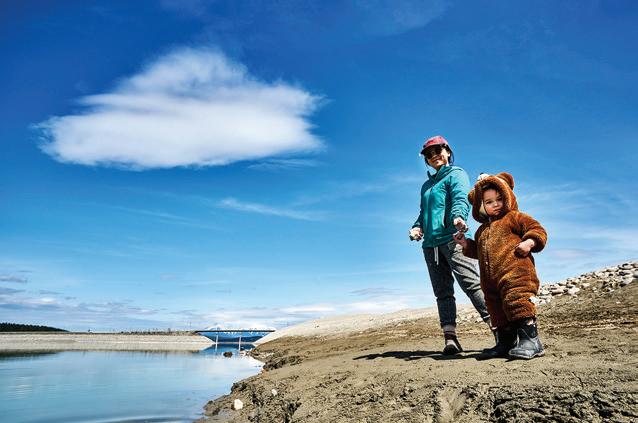
Water, is everything.
CLIMATE CHANGE has altered how much water is stored in and on the land, how much falls from the sky, and when it falls. Human activities such as wetland drainage, overgrazing, unsustainable logging practices, and poor road construction all increase the effects of these changes. Warm air loves water. For every degree increase in temperature, the air can carry 10% more water. Atmospheric rivers occur when warm air carries unimaginable volumes of water inland and dumps it as precipitation. Over two days in June 2013, 200 to 350 millimeters of rain fell on a line across northern Kootenay Lake, the White River, the Upper Elk, and over to the Bow River in Alberta. That’s one-third to one-half of the City of Cranbrook’s annual rainfall, falling in a 48-hour window.
Despite engineering regulations that factor in once-in-a-hundred-year flood events, the Rocky Mountain Forest District lost 50 bridges, including every bridge on the Elk and White
Rivers. Across the province, our storm drains, bridges, culverts, and home drainage systems are woefully inadequate in the face of the new reality that we face.
Water management is inherent in everything. Here in the Kootenays, overheated cattle stirring up small lakes and wetlands into muddy quagmires hasten their evaporation. Uncontrolled off-road vehicle use
can tear up soil and spread weeds, which lowers the land’s ability to deal with major rainfall events. Extensive road building and clearcutting also continues to limit the land’s ability to slow water down and store it.
Concurrently, a dramatic climate shift we’re experiencing is long periods of drought-like conditions in
Continued on page 66

Above: The same storm that did this damage to a bridge on the White River blew out 50 bridges in the Rocky Mountain Forest District, including all of those along the White and Elk River Forest Service Roads. — DQ Photo
Top: Bearing Witness — A springtime journey by Fernie-based photographer Spencer Robinson and his family to the Kookanusa Resevoir, at the entry point of the Kootenay River. — Spencer Robinson Photo
The tRENCH | Spring Summer 2024 65
Continued from page 65
the summer months. Even the showcase Columbia River Wetlands — the longest intact interior wetland complex in North America — is drying out, leaving huge question marks for the hundreds of thousands of migratory waterfowl that rely on it for a fuel-up stop on their annual flyovers.
Water, or wuʔu in Ktunaxa, is the lifeblood of everything from wetlands and forests to cities and entire agricultural systems. We need to start following nature’s lead, and do what our management systems should have been doing all along: use science and precautionary management principles to protect biodiversity and ecosystems that will, in turn, look after us in the face of a changing climate.

Less snow and melting ice.

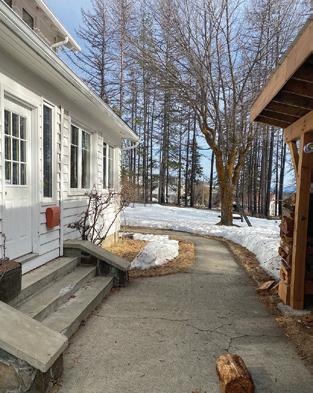
Requim For A Glacier performance, which included the entire Kootenay Symphony Orchestra.
— Pat Morrow Photo
Right: Extreme variation in snowpack is the new norm, and has severe implications for summer drought, wildfire risk, and water quantity and quality in Kootenay ecosystems. Maria Quinn at age four, then eight, pedals through significantly different conditions at her home in Kimberley Townsite in March of 2018 and then again in 2022.
— DQ Photo
WINTER SNOWPACK plays a critical role in the delicate balance of our varied ecosystems. Areas like Moyie, Kidd, Iron, and Lizard Creeks and the St. Mary River Valley are home to an ecosystem called the Interior Temperate Rainforest. “Snowforest” might be more accurate, as historically much of our precipitation fell as snow, hoarded at higher elevations to provide cold, clear meltwater throughout the hot summers.
These valleys receive enough precipitation to allow thousand-year-old cedars — some three metres in diameter — to grow, and they harbour a rich diversity of life from wolverines, grizzlies, and endangered mountain caribou to recently discovered lichens, liverworts, and mosses. Warmer temperatures in the winter means less precipitation overall, as well as more rain on snow events, which melts snow faster than a hot summer day.
The end result is a 20 - 40% lower snowpack across the Kootenays, with further dramatic reductions predicted, such as notably earlier spring runoff — already 20 days earlier than in the mid-20th century — and hotter, drier summers.
The role of our legendary Kootenay Cold Smoke and reliably deep snowpacks cannot be overstated when discussing the future of everything, from ski resorts and backcountry lodges to agriculture and cattle ranches to golf courses and even community water supplies. The single-lift Akloo Ski Hill (ʔa·kǂu, pronounced roughly a’kshlu, meaning ‘snow’ in Ktunaxa) of my youth, on the hill near Cranbrook’s Parkland Middle School, could not exist today, as it would have potentially zero skiable days in a season.
Glaciers are essentially just another form of water storage and refrigeration, helping buffer short droughts by adding meltwater and maintaining cold water temperatures that our salmonid species in particular require for survival. Cold water holds more oxygen than warmer water and some salmon eggs do not grow when water temperatures start to edge above 12 degrees.
Ice loss is easy to document and understand. The Columbia Basin Trust recently released a report based on satellite and air photos comparing ice-covered areas in the South Kootenays. The report found that in the final 15 years of the 1900s, the Slocan watershed lost 47% of its glacial coverage. The Bull River lost 60%.
Left: Drummer and music teaching icon Sven Heyde packed his kit all the way up to the midst of Farnham Glacier to play an ode to the icefield’s shrinking snowpacks and ice. Heyde was part of the
2018 2022
66 Spring Summer 2024 | The tRENCH
Reckonings & Reasonings

Mel Reasoner — Kootenay resident and climate scientist. PhD, Earth and Atmospheric Sciences, University of Alberta. Lecturer and researcher at Brunel University in London, England; Switzerland’s National Academy of Sciences; and the University of British Columbia. Principal at Climate Resilience Consulting. CRC helps communities, governments, and corporations prepare for the impacts of global and local climate change.
It’s been over 30 years since the scientific community began ringing the alarm about the magnitude of the climate change problem.
Over this interval, some of the consequences of the ever-increasing levels of greenhouse gases (GHG) in the atmosphere, coupled with land use changes, are beginning to emerge and we know this trend is not going to bend in the right direction anytime soon.
Reducing GHG emissions should be a priority from individual households to national governments. However, at the local level, it may be more important to anticipate the changes that we can expect over the coming decades and take actions that will mitigate these impacts. A number of sources are now available online for this purpose and can be very useful for those involved in planning for the future, sources including the Columbia Basin Climate Source, Climate Data Canada, and ClimateNA.
The climate in our region has warmed significantly over the last century and the changes in temperature have been accompanied by changes in precipitation that have varied according to season. Downscaled climate models indicate that trends in rising tempera-
tures will continue in the region with higher rates of change associated with higher GHG emissions pathway.
Mean annual temperatures in the region could be up to approximately 4°C warmer than 1985 by the 2070s. Increases in precipitation are expected in all seasons, with the exception of summer, which will likely experience declines in precipitation. Additionally, extreme precipitation, such as maximum oneday rainfall, is also expected to increase in the future.
FOR THE KEY CITY, WILDER WEATHER
Anticipated changes of key climate indices by the 2050s relative to 1985, if carbon emissions at levels considered ‘high’.
OT APPROVED
PROUD PARTNERS & PINT PROVISIONERS FOR THE TRENCH CLIENTS, QUAFFERS & LOCAL BREW-LOVIN’ CREWS.
- 9% + 5.8oc
Mean Annual Temperature Hottest Day of the Year
Coldest Night of the Year
Summer Precipitation
Precipitation as Snow + 4.5oc + 3.5oc
- 32%


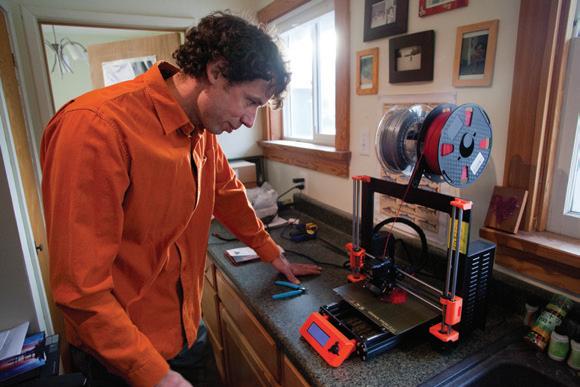
Venture Acceleration Program
Do you have an innovative idea and are looking to launch or grow your business?
We provide personalized, one-on-one mentorship to help you de ne your business model and grow your business.
Our program supports early-stage entrepreneurs working in both traditional tech and other innovative startups!

Connect With the Community
Attend a Tech Meet-up to learn about interesting tech topics and mingle with other local tech workers. Coming soon to Cranbrook, stay tuned!
Want to host or volunteer at an event? Email info@kast.com to get involved.

Have a tech company with innovative technology?
Accelerate IP provides enhanced access to education, skills development, and financial support for protecting, managing, and leveraging your intellectual property.
Who's eligible?
Tech startups in BC, Yukon, the Northwest Territories and Nunavut.
Which sectors?
All tech sectors. Additional support is available for under represented founders and startups in clean tech, health tech and data tech.
The program is offered by New Ventures BC, in collaboration with Innovate BC, plus a network of accelerators, like KAST.

Contact Sam Farrell for more information: sam@kast.com

This program is supported by Innovation, Science, and Economic Development Canada With funding from
l f t | www.kast.com | info@kast.com
KOOTENAY ASSOCIATION FOR SCIENCE AND TECHNOLOGY
KAST is proud to partner with New Ventures BC to deliver
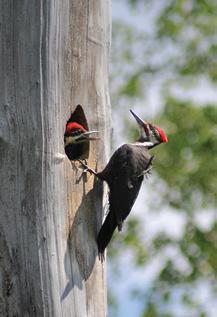
Left: Yamakpaⱡ, the pileated woodpecker, is one of the species benefiting from climate change, due to an increase of food and snags resulting from the uptick of forest pests and wildfires.
— DQ Photo
Right: Milder winters have allowed natural forest pests to thrive. Here, entire patches of older spruce forest in Height of the Rockies Provincial Park have died and turned grey, due to an invasion of spruce bark beetle. But nature has a plan: the younger, fire-origin species in the forest remain healthy. Diversity equals strength. — DQ Photo

Bugs. Who eats who?
THE HUMBLE pine beetle has been an unfortunate scapegoat for some of the worst forest management on the planet. For decades, the Province of B.C. has been beholden to industrial interests with an industry-driven, volume-based system that focuses predominantly — some might say only — on maximizing the wood fibre that can be harvested from our ecosystems.
A rash of early 1900’s wildfires sparked by coal-fired rail engines and mineral exploration efforts converted much of our lower slopes to burn-origin Lodgepole pine, a tree designed to help the land recover from events like fires.
Industry showed up and began to replant clear-cut larch, fir, spruce, and cedar-hemlock forests primarily with Lodgepole, as it grew the fastest of all. Forestry regulations require fast greenery, rather than ecological balance.
Pine beetles have always existed in harmony with normal fire cycles. They now find themselves in an all-you-can-eat Mexican Riviera holiday scenario, with an endless sea of young pine to munch on, and beach vacation winters. Spruce beetles, Douglas fir beetles, and other tree pests have also benefited from higher overwinter survival. The predictable result? More dead and dying trees, which ironically the forest industry used in the 1990s as a rationale to convince us to let them cut even higher volumes of timber to be replanted with, you guessed it, predominantly pine. More dead trees also turns a regular ol’ wildfire into a destructive inferno in the right conditions.
Life for woodpeckers, on the other hand, has never been better, with an unprecedented number of bark beetle larvae to feast on through much easier winters.
Migrating Trees
WESTERN LARCH (often misnamed Tamarack; the closest Tamarack grow in the Saskatchewan and Churchill River basins in the Canadian Shield) have a very limited range in B.C. While this gorgeous, confused deciduous coniferous tree is abundant in the mountains of the Southern Kootenays, its historic range only extends into West Kootenay and Boundary Country, and barely into the Upper Columbia near Invermere. The forestry company Canfor started plant-
ing larch near Golden decades ago, far north of the current range, in anticipation of warmer climates, allowing the species to slowly expand northward. Experimental, climate-anticipating larch plantations have been established near Horsefly, Burns Lake, and even in the Kispiox Valley north of Smithers. These newly planted larch farms appear to be doing just fine.
Nature itself is taking advantage of our recent wimpy
Continued on page 70

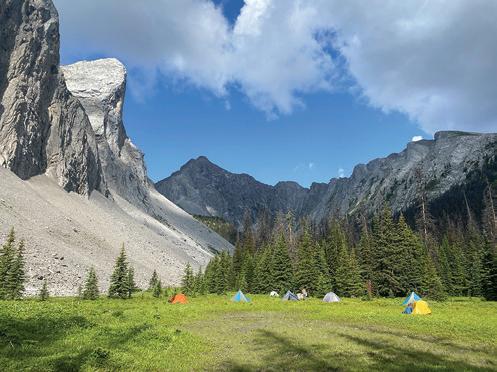 Top: Larch plantations, like this one in the Central Purcells, north of the current larch range, highlight the predicted and observed movement of species in response to changing climates. — Petra Hekkenberg Photo
Bottom: Subalpine meadows, like this gem in Height of the Rockies Provincial Park, are slowly disappearing as lower snowpacks and warmer winters allow trees to take hold. — DQ Photo
Top: Larch plantations, like this one in the Central Purcells, north of the current larch range, highlight the predicted and observed movement of species in response to changing climates. — Petra Hekkenberg Photo
Bottom: Subalpine meadows, like this gem in Height of the Rockies Provincial Park, are slowly disappearing as lower snowpacks and warmer winters allow trees to take hold. — DQ Photo
The tRENCH | Spring Summer 2024 69
Continued from page 69 winters to rearrange its furniture and the Kootenays, like all mountain zones, are losing alpine at a startling rate. The Coyote Plateau in Top of the World Provincial Park is a high-elevation limestone bench that, for the past 10,000 years, has been predominantly open alpine meadow and grassland, as evidenced by an abundance of grass pollen found in the mud layers from nearby Fish Lake. But you don’t need to go to the bottom of the lake to see this change. The open meadow complex with its small patches of Engelmann spruce, Subalpine fir, and Alpine larch that I remember from childhood hikes in the park is now a thick forest of young trees with a few open meadows already losing ground to a steadily marching army of seedlings.
Down in the valley, most forecasts show the Rocky Mountain Trench shifting towards very open sage and Ponderosa pine forest, similar to the Okanagan today, a change supported by the increasing frequency and severity of wildfires. Forest-dwelling and grassland-reliant species may just benefit from these changes, while alpine dwellers like goats, lemmings, pica, and marmots might not be as lucky.
Tick. Tick. Tick.
ADDITIONAL beneficiaries of climate change might lead to some imagined queasiness and real health concerns. Other insects that are limited by cold winters include wasps, whose overwintering queens can freeze to death; conifer seed bugs, also known as cedar bugs and stink bugs, who feast on the seeds in cones produced by the tonne by drought and heat-stressed trees; and wood ticks.

Ticks are some of the most-hated Kootenay crawlies. They often climb up legs and arms to burrow into warm nether parts, underarms, or behind ears to inflate themselves with their host’s blood. Tick saliva can carry zoonotic
including Colorado Tick Fever, Rocky Mountain Spotted Fever — an ulcer-inducing bacteria called tularaemia — and Lyme Disease, which
a patient’s heart and nervous system.
According to Dr. Emily Jenkins, Head of the Zoonotic Parasite Disease Unit in the University of Saskatchewan’s Department of Veterinary Microbiology, Lyme Disease isn’t in the Kootenays — yet.
“Lyme Disease in B.C. is carried by Ixodes pacificus, the Western black-legged tick, which tends to be restricted to Vancouver Island and coastal regions of B.C.,” explains Jenkins.
However, there is recent evidence of expansion of the range of Ixodes, as well as our local Rocky Mountain Wood Tick (Dermacentor andersoni). There’s also the arrival of a surprising newcomer.
“We thought the region only had Rocky Mountain Wood Tick, but we started hearing reports of Dermacentor variabilis, or the American Dog Tick, showing up in southern B.C., which made no sense since it’s only established east of Saskatchewan,” explains Jenkins. “It turns out that this is likely an entirely new species of Dermacentor tick sneaking up from the U.S.A. that looks exactly like D. variabilis — but is actually a new species called D. similis, based on DNA.”
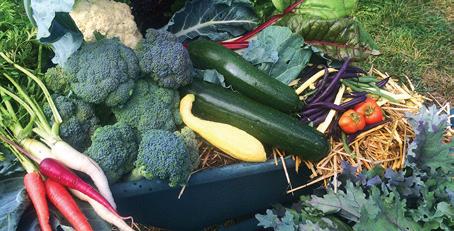

A target rash indicative of a standard Rocky Mountain Tick bite, on the chin of writer Dave Quinn. Despite its nasty appearance, Quinn says, “I hardly felt it.” Nevertheless, a doctor’s visit was required, plus a dose of antibiotics. — DQ Photo
Rocky Mountain Ticks can transmit Colorado Tick Fever, Rocky Mountain Spotted Fever, and Tularaemia to people, although cases are currently very rare in Canada.
“Some female D. andersoni produce a salivary neurotoxin that causes tick paralysis in pets, livestock, and people, primarily observed in central British Columbia,” says Jenkins. “Even one tick can cause a serious and progressive paralysis that can be fatal if the tick is not found and removed.”
Currently, experts like Dr. Jenkins don’t yet know enough about D. similis to know what diseases it might transmit.
Gardens of plenty.
AS EVERY Kootenay gardener knows, frost is the enemy. Hard frosts in June and August in the Wycliffe zone limit what can be grown outside of greenhouses, despite this being one of the sunniest spots in the country. However, with warmer temperatures and the number of frost-free growing days on the rise, the potential for local food production increases dramatically. Townsite gardens in Kimberley — at one time Canada’s highest municipality — have produced tomatoes in an unheated greenhouse until Halloween in recent years, with fresh, late-October raspberries thrown in for dessert. Kiwis, grapes, avocados, and citrus all have potential here with a little effort and added winter heat.
Climate change might just be a boon to the hundred-mile diet and the more robust food security it can support.
Longer growing seasons and more frost-free days are both climate change gifts to the Kootenays, meaning gardeners will be growing more of everything. — DQ Photo
diseases
affect
can
70 Spring Summer 2024 | The tRENCH
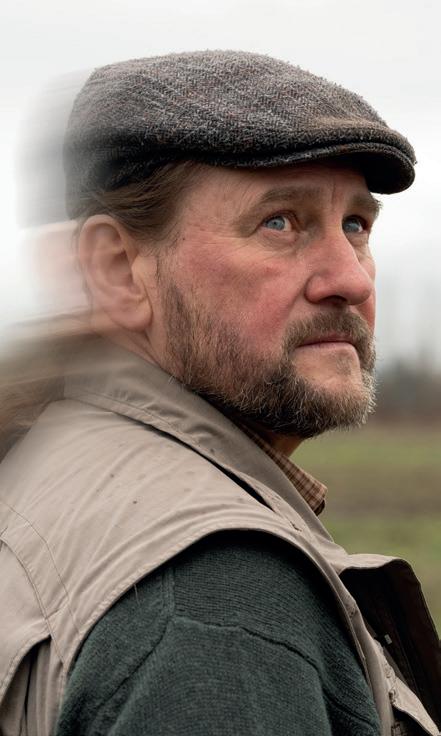


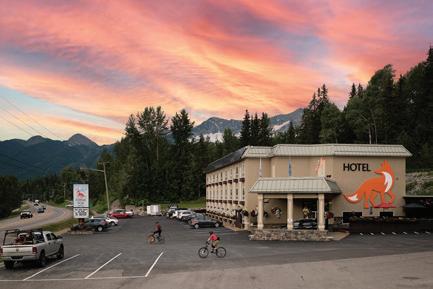
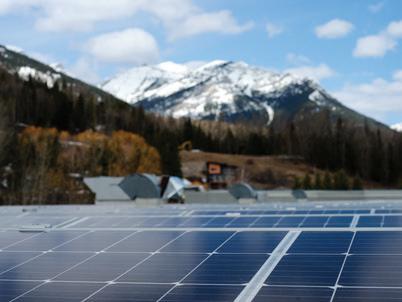
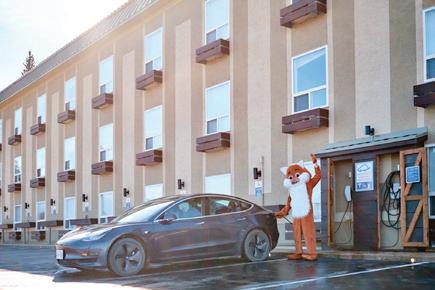

Stay at Fernie's most sustainable hotel this summer. www.ferniefoxhotel.com 1-877-447-6788 BOOK NOW The bank for Canadian entrepreneurs Keep moving your business forward with our flexible financing solutions and expert advisory services. Cranbrook Business Centre Michelle Kleindienst, Account Manager michelle.kleindienst@bdc.ca bdc.ca 1-888-INFO-BDC













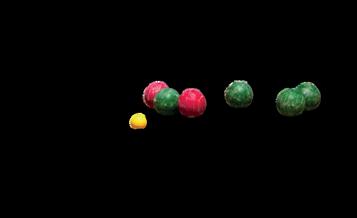



NOW OPEN BOCCE REGISTRATION Cranbrook 505 Victoria Ave 250-489-3461 | Open 8am-10pm, 7 days a week Proud to serve our communities Kimberley 1545 Warren Ave Fernie 792 2nd Ave Sparwood 113 Red Cedar Dr Creston 1000 Northwest Blvd 250-427-2313 | Open 8am-9pm, 7 days a week 250-423-4607 | Open 8am-9pm, 7 days a week 250-425-6849 | Open 8am-9pm, 7 days a week 250-428-2555 | Open 7am-9pm, 7 days a week Pharmacy: 8am-7pm Mon-Fri | 10am-6pm Sat-Sun Pharmacy: 9am-5:30pm Mon-Fri | Closed Sat-Sun Pharmacy: 9am-6pm Mon-Fri | Closed Sat-Sun
Solutions?
THE CLIMATE CHANGE cat is well and truly out of the bag, and as with all collective problems, the solutions are limited to individual efforts, with some legal motivation thrown in for good measure. Some families are travelling less, emphasizing local energy sources and goods consumption, and shifting into EVs before the 2035 national mandate — all while trying to minimize their impact and make the world a better place. Others are still partying like it’s 1999: driving large fossil fuel vehicles, enjoying expensive holidays and long road trips, and consuming energy and food from all over the world — often while complaining bitterly about the exorbitant price of gas, flights, mangoes, and avocados.
Climate change is not all bad. Benefits to some ecosystems include: longer biking, golfing, hiking, and fishing seasons; longer growing seasons for gardeners; and lower energy costs potentially helping offset the shorter winters, lackluster ski seasons, expensive fossil fuels and exotic foods, and smokey summers that are all part of our collective realities moving forward.
Like all things in life, we all choose what we are willing to adapt to, and what we want to just keep on griping about, wondering why it never changes…

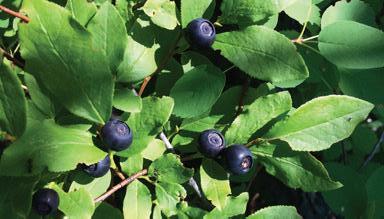
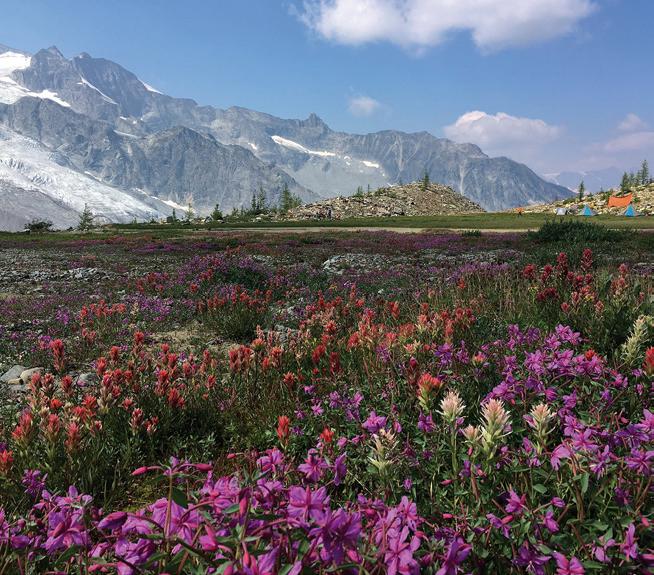
The Future Can Be Friendly
AS IN EVERY SCARY story, hope is the path that leads us out of the climate crisis.
The good news locally is that few places on the planet are as well-positioned to adapt to a changing climate as the Kootenays.
With over 3,500 meters of elevation to play with across the region, we have a lot of room for species and ecosystems to move. All but those already pushing the higher elevation limits have wiggle room, and our northsouth main valleys allow for streamlined migration of pretty much anything. Wild adaptation here can be easeful — if we allow it to happen.
We are still blessed with an abundance of wild areas and a diversity of species, although our negligence has driven caribou, fisher, and burrowing owls to local extinction, and is pushing many others — like bighorn sheep, wolverine, and badgers — towards the door.
Balancing an exploding human population while still making space for our wild neighbours will require a dramatic shift in worldviews
from the colonial “industry first, at all costs” mindset back to a more balanced, Indigenous-led approach that respects all, and strives for ecosystem health over profits.
The elephant in the old growth is the reality that many of us have a huge buffer of resource consumption before we could claim hardship. For decades, the rest of the world has had water meters, rainwater collection systems, on-demand water heaters, efficient vehicles, excellent local food production, and limited personal travel.
All of these initiatives conveniently support us in adapting to a changing climate, as well as mitigate it, by helping us offset our contributions. The irony in the fear-based responses many of us have to these ideas is that their perceived limits actually encourage us to slow down and cherish life more. Put another way: life is simply better when you chill out and truly appreciate what you have.
Many Kootenay communities have enacted bylaws
that prioritize densification of human residential areas over the mindless 20th century expansionism that saw subdivisions replace wildlife habitat, and made commuting and consumption a built-in obligation. Ostensibly a knee-jerk reaction to the current housing crisis, this also helps us adapt to, and mitigate, climate change.
More efficient resource use and the protection of intact wild spaces is good for everything from carbon storage, reduction of energy use, biodiversity protection, water conservation, and quality of life. Here in the Kootenays, we are blessed with abundant opportunities on all fronts.
Learn more: You can explore different climate models and projections for your community at: basinclimatesource.ca
Top: Terrestrial species like ¢upqa, or mule deer, will move uphill in elevation, and northward in range, as long as we protect wilderness habitats that allow them to do so.
Bottom: Huckleberry patches are often established in areas after wildfires, meaning a potential boon for berry pickers in years where drought doesn't hinder berry growth. — DQ Photos
The tRENCH | Spring Summer 2024 73
EVENTS

KIMBERLEY
Sundays
BINGO for charity. The Shed, 180 Deer Park Ave. 19+. 8pm
Mondays
TRIVIA NIGHT Marysville Pub. 447 304 St. 7:30pm
Tuesdays ('til June)
TRIVIA NIGHT The Shed. 180 Deer Park Ave. 8pm
Wednesdays
KARAOKE NIGHT The Sullivan Pub. 400 Ross St. 8:30pm-late
May 5
CINCO DE MAYO PARTY Burrito Grill, 160 Howard St. Details TBA
May 25
RED DIRT SKINNERS Live folk music at Centre 64. 64 Deer Park Ave. 7pm
Thursdays
FARMERS’ MARKET Starting in June. Howard St. 7pm
June 1
CEILIDH ON THE MOUNTAIN
Kimberley Pipe Band and K/C Highland Dancers. Kimberley Alpine Resort. 2:30-7:30pm
June 8
LOBSTERFEST 13 Dinner and live music. Kimberley Conference Center, 301 North Star Blvd. 5-11pm
June 22
ROUND THE MOUNTAIN
Multi-discipline adventure event. Advance registration required. Kimberley Nordic Club, 840 Northstar Dr. 7am-4pm
July-October
FIRST SATURDAYS Live music, kids’ activities, and markets in the Platzl. Spokane St.
July 1
PURCELL GOLF 100-YEAR
CELEBRATION East Kootenay residents can golf for $19.24. 415 302 Ave.
July 19-21
JULYFEST 2024 Bocce tournament, live music, and more. Centennial Park
July 27
MOTOR MOUNTAIN NATIONALS
CAR SHOW Howard St and Deer Park Ave. 10am-3pm
CRANBROOK
Thursdays
TRIVIA NIGHT Encore Brewing Co. 1400 4th St N. 7-9pm
May 2
DINO LIGHT: A PUPPETRY
LIGHT SHOW Key City Theatre, 20 14th Ave N. 7-9pm
May 3 & 4
CRANBROOK WITCHES MARKET: BELTANE SPRING MARKET The Days Inn Ballroom, 600 Cranbrook St N. Times TBA.
May 25
CRANBROOK GRAVEL GRIND
Cycling event for all abilities. 3379 9th St S. Race starts 9am; post-race celebration 4pm-late
Saturdays
FARMERS’ MARKET Starting May 27. 10th Ave S. 10am-1pm
June 7
QUEEN: IT’S A KIND OF MAGIC
A recreation of Queen's 1986 World Tour. Key City Theatre. 20 14th St N. at 8pm
June 9
WASA LAKE TRIATHLON Many events for all ages. Wasa Lake Provincial Park. 8am start
June 13-16
SPIRIT OF THE ROCKIES FES -
TIVAL Live music, bocce, food trucks, logger sports, and more. Various locations.
June 14-15
ROCKIES FEST Tickets available at cranbrookbucks.ca. Western Financial Place, 1777 2nd St N.
August 9-11
ROCK THE KOOTENAYS Featuring Big Wreck, 54.40, Chilliwack, and many more. Western Financial Place, 1777 2 St. N.
FERNIE
Saturdays
JAM NIGHT Fernie Taphouse, 691 1st Ave. 9pm
Wednesdays
TRIVIA NIGHT The Fernie Taphouse, 691 1st Ave. 8pm
May 8
LIVE MUSIC: HOME ROUTES
PRESENTS KALYNA RAKEL Tickets at homeroutes.ca/concerts. Location announced after ticket purchase.
April 24
WANNABE Spice Girls tribute band. The Northern, 561 2nd Ave, 10pm.
May 4
FEAST FOR A CAUSE Long table dinner prepared by 10 of Fernie's finest chefs. 902 Highway #3, 6:30pm
May 9
CHALI 2NA Renowned hip-hop artist. The Northern, 561 2nd Ave. Tickets and time TBA.
May 11
SPRING CRAFT FAIR 902 Hwy 3. 10am-3pm
June 26
BANDIDOS BAND Classic rock cover band from Mexico. 19+. Knox on 2nd, 201 2nd Ave.
June 29
WAM BAM DIRT JUMP JAM
Freeride competition. 250 Pine Ave. 3:30-10pm
July 6-9
TRANS BC ENDURO MOUNTAIN BIKE RACE For more information visit transbcenduro.com.
July 12-14
FERNIE GRAVEL GRIND Races, social rides, vendors, food trucks, and live music. Details online.
July 18
LIVE MUSIC: MISERY MOUNTAIN BOYS Bluegrass-flavoured jazz. 19+. Tickets $25. Details TBA. The Knox, 201 2nd Ave.
July 27
6TH ANNUAL ELK VALLEY ULTRA: 50KM AND 15KM 6am: 50km at Maiden Lake. 8am: 15km at Fernie Alpine Resort. Register at stagleaprunning.com.
August 9 & 10
WAPITI MUSIC FESTIVAL at Annex Park. Featuring K'naan, Phonosonics, Jesse Roper, and many more. Tickets at wapitimusicfestival.com.
INVERMERE
Mondays
POKER NIGHT $20 buy-in. The Station Pub. 1701 6th Ave. 6:30-11pm
Thursdays
TRIVIA NIGHT Entry is $3 per person. 19+. Windermere Whitehouse Pub, 1654 Sinclair Ave. 7:30pm Flying the flag in Fernie Somali-Canadian rapper and singer K’naan headlines this years Wapiti Music Festival in Fernie, happening August 9 & 10. Soccer fans around the world will recall his single Wavin' Flag, one of the anthems for the 2010 FIFA World Cup. Photo courtesy Wapiti Festival
Spring Summer ~
74 Spring Summer 2024 | The tRENCH
April 13
LIVE MUSIC: STONEHOCKER Acoustic guitar with minimalist electronic beats. Arrowhead Brewery, 481 Arrow Rd. 7-9pm
April 20
LEGO EXPO Exhibitions, challenges, & more. By donation. Columbia Valley Centre, 646 4 St.
April 27
2ND ANNUAL SPRING FASHION SHOW 19+. Tickets $50, available at the thrift store or La Galeria. Coy’s Par 3, 4476 Columere Rd, Fairmont Hot Springs. 5:30-9pm
May 1; June 5
COMMUNITY DRUM CIRCLE Located at Pynelogs. 1720 4th Ave. 7- 8:45pm
May 6-12
WINGS OVER THE ROCKIES Nature festival with 100+ events over 7 days. Events calendar and tickets at wingsovertherockies.org
June 1-2
ROCKY MOUNTAIN RALLY The second event of the Canadian Rally Championship returns. More details TBA
RADIUM
Sundays
LIVE MUSIC Horsethief Creek Pub and Eatery. Accompanied minors permitted. 7538 Main St. E. 7-9pm
May 4
RADIUS RETREATS PRESENTS: LOCAL
LINEUP Live music, food vendors, and craft beers. Family-friendly. Tickets at radiusretreat.com/events.
May 25
CRAZY SOLES NIPIKA TRAIL RUN. 25km, 10km, 5km, and a kids' 2.5km run. Register at nipika.com/crazysoles. Nipika Mountain Resort, 9200 Settler's Road.
Fridays (June - September)
MUSIC & MARKET ON MAIN Craft and food vendors, live music. Highway 93. 4-7pm
CRESTON
Wednesdays
TRIVIA NIGHT Wild North Brewing, 125 16 Ave N. 6-9pm
Thursdays
BINGO Frisky Whisky, 1117 Canyon St. 7-9pm
Every 2nd & 4th Thursday
OPEN MIC Wild North Brewing, 125 16 Ave N. 7-9pm
Saturdays
FARMERS' MARKET Behind the Visitor Centre, Cook St. 9am-1pm
May 4-5
HERE COMES THE SUN Blossom Valley Singers Spring Concert. Details TBA. Kootenay River Theatre, 223 18 Ave S.
May 9-13
CRESTON VALLEY BIRD FESTIVAL Presentations, workshops, guided canoe trips & birding tours. Register at wildsight.ca
May 14-20
CENTENNIAL CELEBRATIONS Films, performances, drone light show, live music, and more. Details at creston.ca/centennial-event.
May 17-20
BLOSSOM FESTIVAL Live music from BC/DC, midway carnival, markets, and more. Details at blossomfestival.ca
May 25 & June 15
JAM NIGHT Jimmy's Pub, 1418 Canyon St. 8-11:30pm
June 15
ROCKIN ON THE RIVER Outdoor music festival. River’s Edge Ranch RV Park, Yahk.
July 1
CANADA DAY CELEBRATION Pancake breakfast, farmers’ market, live entertainment, fireworks. Various locations.
July 27
2024 SHOVELFEST Swap meet, show n shine, and more. 4725 Samuelson Rd, Canyon. 10am-4pm
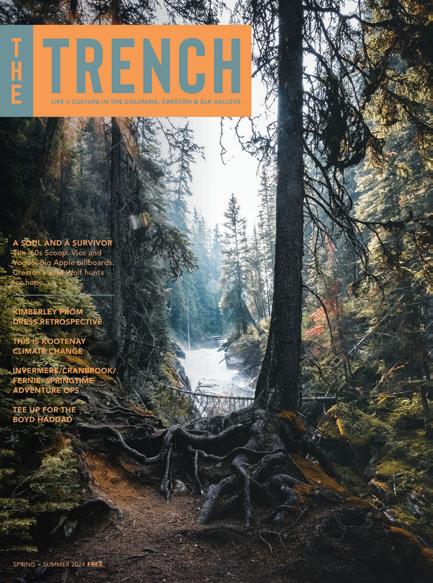
For nearly two decades, Kootenay Media’s various magazines have made it through forest fires, snow storms, a pandemic and even a merger (when our beloved local titles Go Kimberley and Go Cranbrook became…wait for it…Go Cranberley!)
Today, with the support of communities and businesses throughout the Columbia, Creston and Elk Valleys, we’re proud to introduce the next chapter in our collective story.
Welcome to The Trench Life. Culture. News and views. The Trench reaches a population of 50,000+, landing every four months in over 150 East Kootenay businesses and more than 400 rooms in hotels, motels and holiday rentals. Online, 2,300 folks follow us on Facebook and 1,200 on Instagram.
Advertise in our next issue. Carry us in your business.
ADVERTISING darren@kootenaymedia.ca 250.505.9759
alesha@kootenaymedia.ca 250.430.1330
DISTRIBUTION jesse@kootenaymedia.ca 403.510.4666
STORY + PHOTO CONTRIBUTIONS britt@kootenaymedia.ca
INVERMERE
CRANBROOK FORT STEELE CRESTON FERNIE
RADIUM KIMBERLEY
FAIRMONT
50,000 eyes are looking for you.
Small business is the lifeblood of our local economy. If you’ve got a Mom n’ Pop shop, a family-owned franchise or two, or even a side-hustle, our business directory is a great place to reach the 50,000 folks who call this part of the Columbia, Creston or Elk valleys home. A directory placement gets your business year-round presence in The Trench . Our design team will even help build it. And the affordable price will probably surprise you.
Better exposure, no hassle.
Brian Conn / 250.427.9896 kootenayshadeworks@yahoo.ca


Why not spend a few extra days exploring Kimberley’s vibrant arts, music and festivals? From Julyfest to Oktoberfest, this is the perfect way to explore the great city of Kimberley.


Brian Conn 250.427.9896 northstarcoffeeroasting@gmail.com BUSINESS DIRECTORY
KOOTENAYSHADEWORKS.COM Dine In or Take Out | Open for Lunch & Dinner A-1221 – 7th Avenue | 778.519-5255 sushiwood.com/fernie View Menu Come for the Adventure... Stay for the Arts, Food Music & Festivals
tourismkimberley.com
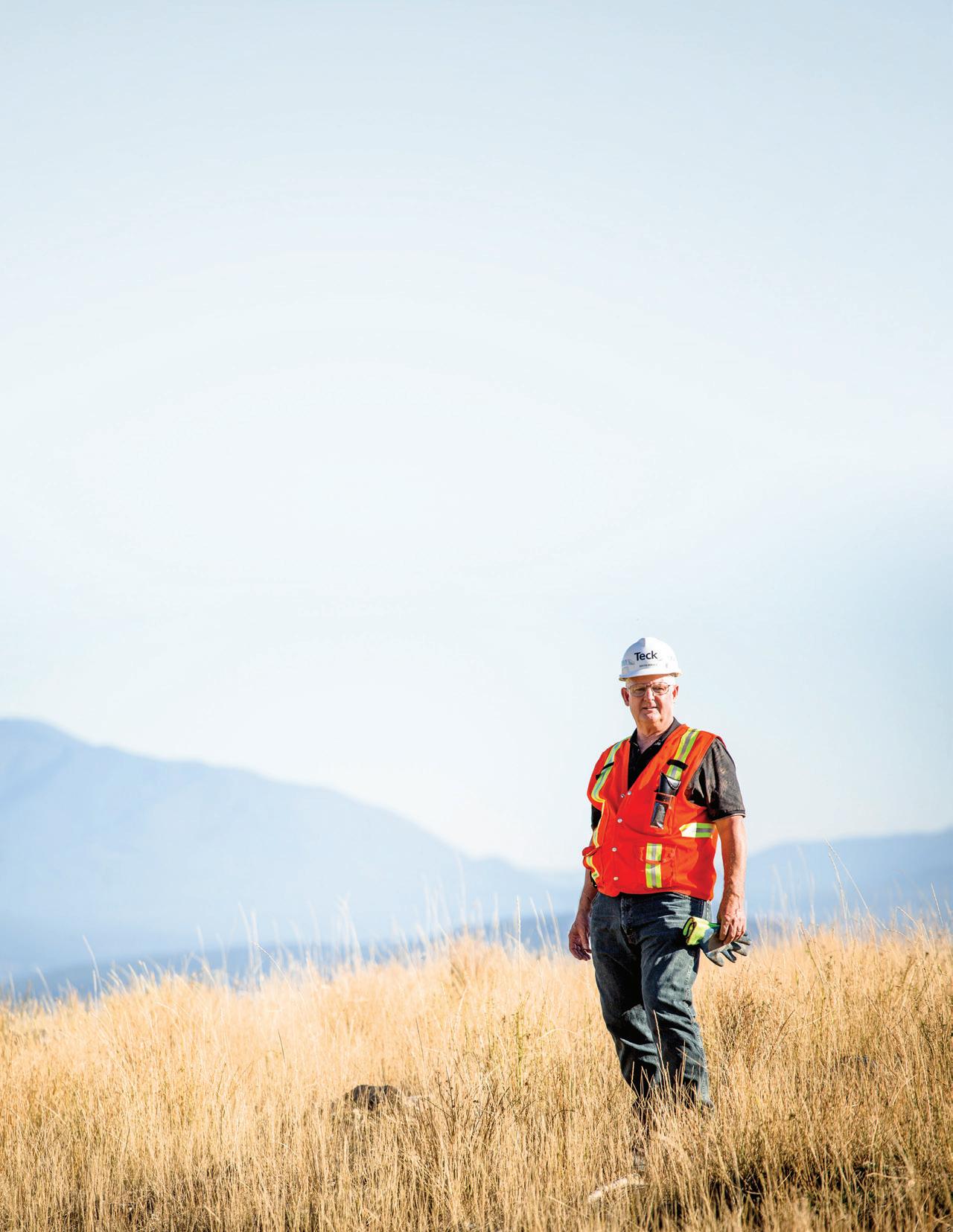
Sullivan Mine Information Day
For nearly a century, the Sullivan Mine shaped Kimberley’s social and economic landscape. Join Teck Resources on May 11, 2024, at the Kimberley Conference Centre to learn more about the ongoing stewardship efforts post-closure and experience Teck’s reclamation efforts firsthand during our mine tour (limited spots available—be sure to register in advance).
Visit teck.com/sullivan to learn more about the event or to register.





basecamp of the kootenays
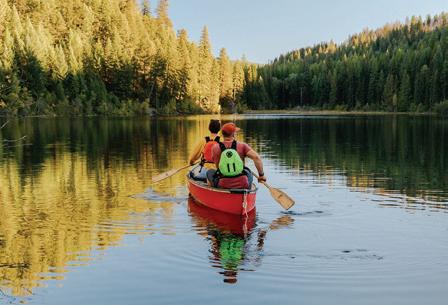
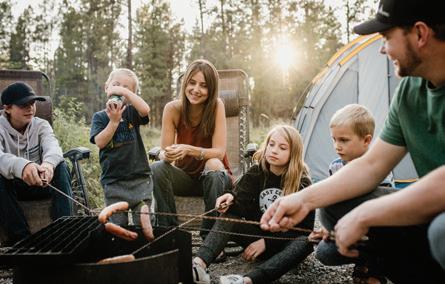
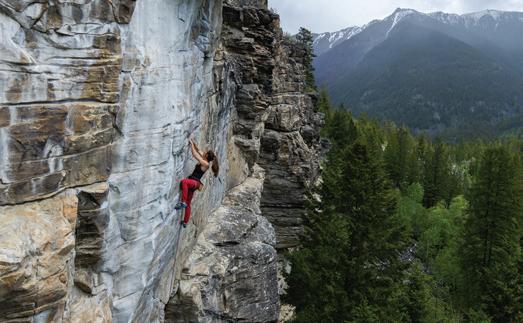


















































 Photo
Photo

































































































 BY DANETTE POLZIN
BY DANETTE POLZIN





 A selection of paddles to, well, wet your appetite.
A selection of paddles to, well, wet your appetite.



 Vince Mo Photo, courtesy of Tourism Fernie
Vince Mo Photo, courtesy of Tourism Fernie


 w. Wayne McCrory
p. Patrice Halley
w. Wayne McCrory
p. Patrice Halley



































































































 Top: Larch plantations, like this one in the Central Purcells, north of the current larch range, highlight the predicted and observed movement of species in response to changing climates. — Petra Hekkenberg Photo
Bottom: Subalpine meadows, like this gem in Height of the Rockies Provincial Park, are slowly disappearing as lower snowpacks and warmer winters allow trees to take hold. — DQ Photo
Top: Larch plantations, like this one in the Central Purcells, north of the current larch range, highlight the predicted and observed movement of species in response to changing climates. — Petra Hekkenberg Photo
Bottom: Subalpine meadows, like this gem in Height of the Rockies Provincial Park, are slowly disappearing as lower snowpacks and warmer winters allow trees to take hold. — DQ Photo













































